July/ August 2023
SIMPLY RED
How to integrate and balance red artificial light within the built environment

RECLAIM THE STREETS (ONE YEAR ON)
Revisiting the challenges around lighting, crime, and safety at night
PARKS AND RECREATION
Why are so many urban parks still so poorly lit and maintained at night?
Professional best practice from the Institution of Lighting Professionals
The publication for all lighting professionals
Modular (2X2) refractive lenses in PMMA with 5 optical distributions available. Shield in flat tempered glass with impact resistance IK10 and prismatic IK07. Upper



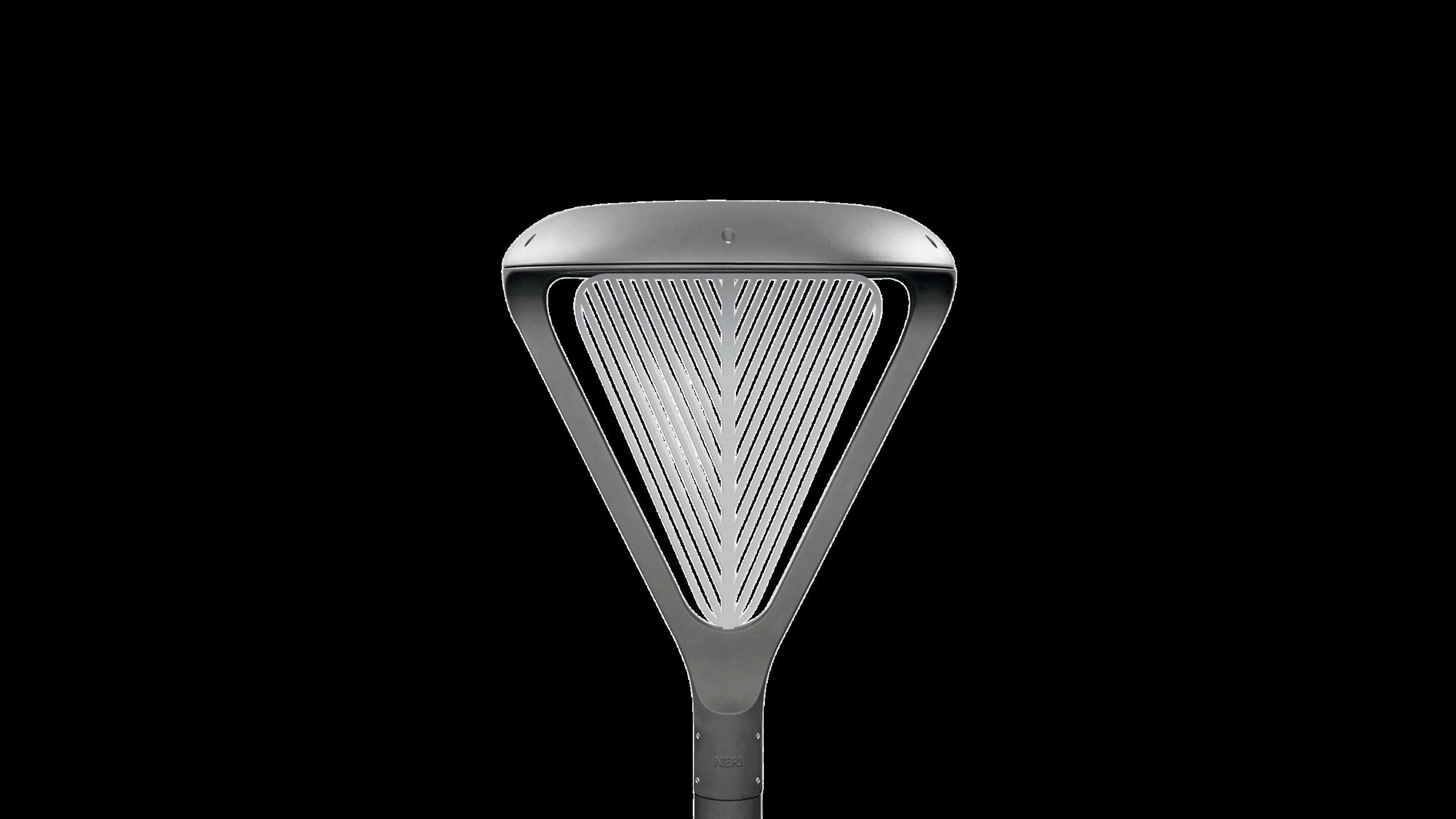
Discover More asdstreetlighting.com +44 (0) 1709 374898 sales@asdlighting.com Optical package consists of 8 geometries. Enclosure protection: IP66, IK08. Transparent or prismatic glass screen. Luminous flux from 350lm to 4,500lm per light source.
Lumen output between 1,500 and 15,000. Can be ordered with or without the blade. The blade is a customisable aluminium screen that separates the brackets, filters light and can be laser-cut to specific designs or colour tinted.
frame shaped bell in aluminium with threaded connection G 3/4″.
RECLAIM THE STREETS (ONE YEAR ON)
The connections between lighting, crime, safety and perceived safety are complex and multifaceted. What’s important, argues Clare Thomas, is to recognise that there is no singular user that public spaces should be designed for, we can’t simply ‘design out’ crime, and lighting on its own won’t resolve societal issues
PARKS AND RECREATION
Lit well, urban parks can not only be safe spaces for women but year-round wholecommunity hubs, for people of all ages. So, why, as a conference recently asked, are so many still so poorly lit and badly maintained? Lighting Journal spoke to Elettra Bordonaro to find out
SAFE PASSAGE
The importance of welldesigned and maintained artificial lighting in making parks feel safer for women and girls after dark has been emphasised in recent research by the University of Leeds. But it is also clear that better lighting is not the only answer
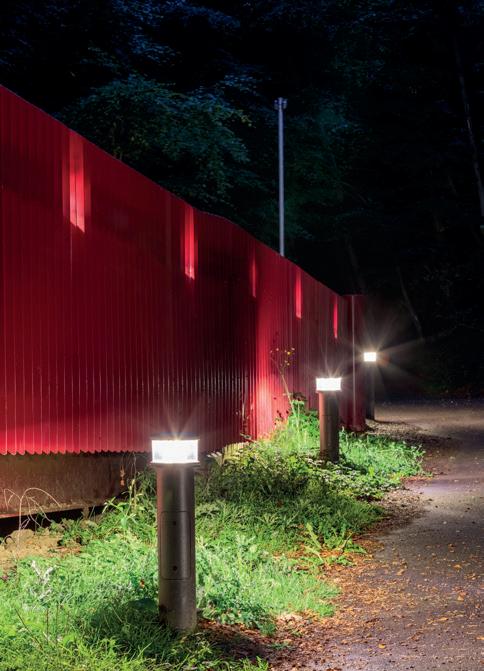
CREATING A MORE ‘LEGIBLE’ PUBLIC REALM
A recent ILP event, ‘City Signs & Lights’, brought together academics and lighting professionals to consider how public realm lighting can be better integrated into – and even lead – urban design and placemaking. Graham Festenstein reports
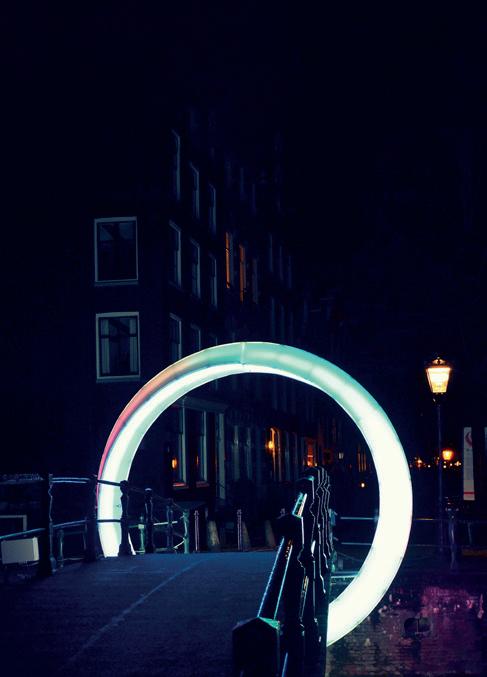
DECLARATION OF INTENT
Lighting Urban Community International (LUCI) marked May’s International Day of Light by publishing an ambitious ‘LUCI Declaration’ outlining how municipalities and lighting professionals may need to rethink their approaches to urban lighting over the next decade
WHAT ARE YOU LOOKING AT?
A research project is testing the assumption that, when researching lighting for interpersonal evaluations on subsidiary roads, we should focus on the face. Khalid Hamoodh and Professor Steve Fotios of Sheffield University report
SIMPLY RED
Millennia of evolution have shaped how we see, perceive and think about red light. Understanding this will allow us all better to integrate and balance red artificial light within the built environment and public realm, a recent ILP ‘How to be brilliant’ led by BDP’s Colin Ball and Lora Kaleva concluded
PEARL IN THE SHELL
The new lighting scheme for 80 Strand, formerly Shell Mex House, in London draws inspiration from its Art Deco heritage while also bringing a sense of contemporary cohesion to its communal spaces
SKILLED WORK
With an ageing workforce and not enough young people choosing it as a career, the highway electrical industry is facing something of a skills crisis. Making better use of apprenticeships, especially the highway electrical apprenticeship, needs to be an urgent priority for the industry, argues Greg Jarvis
EURO VISION
With 2,500 luminaires, two kilometres of LED tape, 17,500 individual light sources, 37 immersive lighting environments and 79,000 individual lighting cues, May’s Eurovision Song Contest in Liverpool was a massively complex lighting challenge
AS GOOD AS OLD
For too long, lighting has been obsessed with promoting and selling new product and has shown little interest in repurposing fittings or caring what happens to them. That has to change, writes John McRae. Lighting now has no choice but to wean itself off ‘new’ as the default solution to every problem
EMERGENCY PLANNING
The phasing out of fluorescent lamps during this year is likely to put a renewed impetus into LED retrofit projects. As Andy Davies argues, while clients are thinking about upgrades and perhaps have labour on site, it makes sense also to be talking to them about the importance of revisiting their emergency lighting


‘I ENJOY BEING ABLE TO MAKE A DIFFERENCE TO PEOPLE AND PLACES THROUGH LIGHTING’
It is the turn of the YLP’s new chair Ryan Carroll to put himself in the Lighting Journal spotlight, discussing his route into the industry and how others can be encouraged to follow suit
CLIVE LANE: 1943-2023
Former Institution President Clive Lane sadly passed away in May. His widow Sheila reflects on his life and significant contribution to lighting over many years

COVER PICTURE
Boxpark Croydon, showing its ‘even carpet’ of 30 lux of pure red light, as designed by BDP. Turn to page 38 where BDP’s Colin Ball and Lora Kaleva have discussed how to integrate and balance red artificial light within the built environment and public realm, as part of a recent ILP ‘How to be brilliant’ event. Photograph by David Barbour

Contents 46 06 64 28 www.theilp.org.uk JULY/ AUGUST 2023 LIGHTING JOURNAL 3 LIGHT UP, DRIVE OVER EMINERE™ INGROUND anolislighting.com 06 38 46 50 54 56 60 64 62 12 18 24 28 34
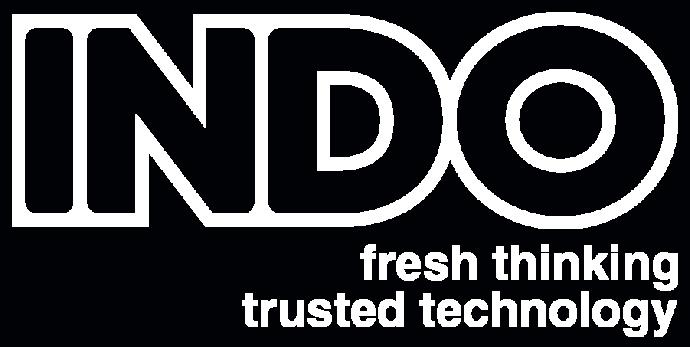










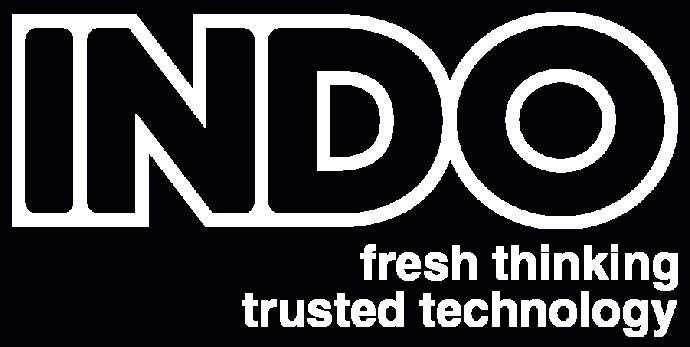

AIR3 20,000-56,000lm M1-M3,C1-C5 AIR1 500-4,500lm P1-P6,C3-C5 AIR2 3,000-24,000lm P1-P3,M2-M5,C3-C5 SiCURA 500-8,000lm P1-P6,M3-M6,C3-C5 www.indolighting.com w +44(0)2030511687 info@indolighting.com
Volume 88 No 7
July/ August 2023
President Rebecca Hatch IEng MILP
Chief Executive
Justin Blades
Editor Nic Paton BA (Hons) MA
Email: nic.cormorantmedia@outlook.com
LightingJournal’scontentischosenand evaluatedbyvolunteersonourreaderpanel, peerreviewgroupandasmallrepresentative groupwhichholdsfocusmeetingsresponsible forthestrategicdirectionofthepublication. Ifyouwouldliketovolunteertobeinvolved, pleasecontacttheeditor.Wealsowelcome reader letters to the editor.

Graphic & Layout Design
George Eason
Email: george@matrixprint.com
Advertising Manager
Emma Barrett
Email: ebarrett@matrixprint.com
Published by Matrix Print Consultants Ltd on behalf of Institution of Lighting Professionals Regent House, Regent Place, Rugby CV21 2PN
Telephone: 01788 576492
E-mail: info@theilp.org.uk
Website: www.theilp.org.uk
Produced by Matrix Print Consultants Ltd
Unit C, Northfield Point, Cunliffe Drive, Kettering, Northants NN16 9QJ
Tel: 01536 527297
Email: gary@matrixprint.com
Website: www.matrixprint.com
© ILP 2023
The views or statements expressed in these pages do not necessarily accord with those of The Institution of Lighting Professionals or the Lighting Journal’s editor. Photocopying of Lighting Journal items for private use is permitted, but not for commercial purposes or economic gain. Reprints of material published in these pages is available for a fee, on application to the editor.
If there is a common thread running through this month’s edition, it is how lighting – good lighting especially – colours our perception of the public realm and built environment. My use of the word ‘colour’ here is deliberate, given our review of Colin Ball and Lora Kaleva’s ‘How to be brilliant’ event on the colour red, from page 38. As their seriously wide-ranging talk showed, millennia of evolution have shaped how we see, perceive and think about red light – and this process is still going on.
Moreover, from blue light being the topicdejourtwo decades ago with the arrival of LED, it is now red that is becoming not just better understood but much more prevalent. This direction of travel may only accelerate as the use of bat-friendly redder lighting gathers pace, especially in the public realm.
Yet, as Colin highlighted, there is a tension here that feeds into perhaps the other key conversation within this edition: lighting and safety at night, especially for women. Very red lighting, after all, can bring with it problems around visibility, contrast and definition at night as well as the perceived safety of spaces.
As Clare Thomas makes clear from page six, better lighting is of course not the only answer to safety at night: lighting is not able to resolve the problem of male violence, of community deprivation and crime, of societal tensions. But understanding how well-specified and designed lighting can make a difference – understanding how to press the buttons of decision-makers and budget holders and understanding who lighting professionals need to work and collaborate with – can all help.
Equally, as Elettra Bordonaro emphasises from page 12, it is vital lighting professionals get boots on the ground when it comes to designing for safety. That can mean co-designing with communities. It can also simply mean being prepared physically to visit these spaces at night or at dusk (and in different seasons) to understand them properly rather than making lighting decisions from the office or in front of a screen. It means thinking ‘safety’ when designing for wayfinding or traversing a space – so, for example, not having overgrown or narrow corridors. This is echoed in our review of Leeds University’s ‘Whatmakesaparkfeel safeorunsafe?’ research report, from page 18.
On the plus side, the fact the Leeds research acted as a springboard for a high-level conference on this issue in May – where Elettra was a speaker – does illustrate the greater priority and urgency this subject is being given. It is also welcome there appears to be growing recognition that well-lit public spaces – whether urban parks or otherwise – can create something of a virtuous circle of ‘levelling up’. Better illuminated, planned and cohesive public spaces will be more used and vibrant, in turn helping to (as Elettra puts it) ‘activate’ such spaces, so generating wider community, economic and societal benefits.
Finally, this whole debate feeds into the public realm conversations at the heart of, first, LUCI’s ‘LUCI Declaration’ on urban lighting (as we report from page 26) and the recent ILP/Leicester Urban Observatory ‘City Signs & Lights’ event on the public realm, as Graham Festenstein discusses from page 24.
As Graham makes clear, lighting has a central role to play in creating a more ‘legible’ public realm at night. A public realm where the social as well as the functional benefits of lighting are understood, where individual and community safety is prioritised, and where the importance of lighting in promoting heritage, architecture and cultural engagement is recognised.
As Graham writes: ‘We need to be developing better strategies for urban lighting and using lighting masterplanning to… create, ultimately, a much more cohesive approach to the design of public spaces at night.’ Quite right.
Nic Paton Editor

SUBSCRIPTIONS
ILP members receive Lighting Journal every month as part of their membership. You can join the ILP online, through www.theilp.org.uk. Alternatively, to subscribe or order copies please email Diane Sterne at diane@theilp.org.uk. The ILP also provides a Lighting Journal subscription service to many libraries, universities, research establishments, non-governmental organisations, and local and national governments.

Editor’s letter
JULY/ AUGUST 2023 LIGHTING JOURNAL 5 anolislighting.com LESS WIRES, MORE WIRELESS LIGHTING SOLUTIONS FOR HERITAGE BUILDINGS
RECLAIM THE STREETS (ONE YEAR ON)
The connections between lighting, crime, safety and perceived safety are complex and multifaceted. What’s important, argues Clare Thomas, is to recognise that there is no singular user that public spaces should be designed for, we can’t simply ‘design out’ crime, and lighting on its own won’t resolve societal issues
 By Clare Thomas
By Clare Thomas
JULY/ AUGUST 2023 LIGHTING JOURNAL 6
It’s a year since Lighting Journal pub lished my article ‘Reclaim the streets’ (June 2022, vol 87 no 6). In it, to recap, I explored the complex relationship between lighting and safety. With ongo ing pressures on local authority revenue budgets, including the energy crisis, now seems a good moment to revisit some of those topics and ask whether decisions are being driven by funding rather than need.

My original article built on a white paper delivered at the Highway Electrical Associa tion’s (HEA) conference back in 2021, a sub sequent webinar for LDC Ireland in Febru ary and ongoing discussions with fellow industry professionals and customers. It culminated with some great workshop dis cussions at last year’s ILP Professional Lighting Summit in Bristol.
As discovered during the LDC webinar, lighting and its potential for improved public safety/crime reduction is a topic that triggers intense discussion, which is reflected when you carry out further background reading on this topic.
Safety and the potential for crime reduction is a topic that has been consistently linked with public outdoor lighting for over 30 years. Whilst it is generally acknowledged that improved lighting definitely improves perception of safety, there is still ongoing debate around whether improved lighting actually enables or hinders crime.
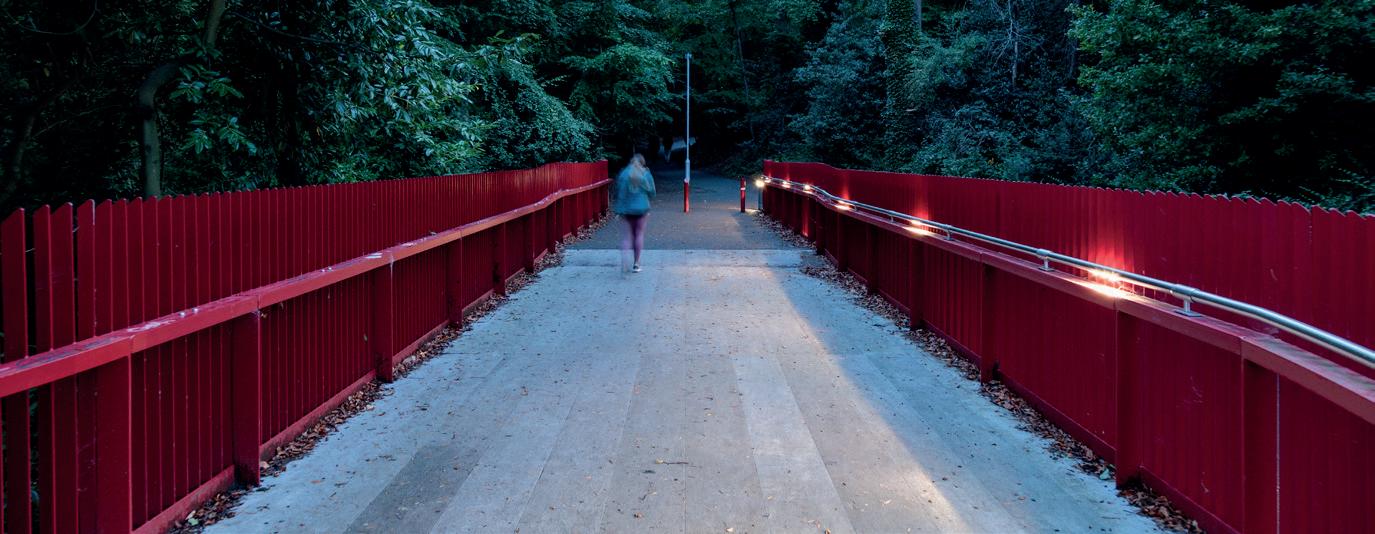
To cite just some examples of recent research, UCL in March 2022 published a study on how street lighting may enable rather than hinder crime, with an article subsequently also published in Lighting Journal [1]. Research led by the London School of Hygiene & Tropical Medicine has considered the effect of reduced street lighting on road casualties and crime in England and Wales [2].
Going back a bit, Farrington and Welsh (2007) have looked at the links between lighting and crime reduction (as also cited within Safer Streets documents), with the original study updated in 2021, but which still seems to suggest lighting can be an effective tool in this context [3]
WHAT CAN LIGHTING DO?
So, let’s start by considering what lighting can do. Lighting significantly affects how a space or place feels and is used. Is it welcoming, or not? Does it look attractive after dark?
Lighting and safety
Is it somewhere to stay and socialise, a quick route for an essential journey, or somewhere to avoid? And what is clear is that perceived safety is an important topic for everyone.
A YouGov poll was carried out in the UK in May 2021 (‘What would make the UK safer for Women?’) [4]. From a timing perspective this poll was carried out shortly after the shocking murder of Sarah Everard, when there was a real public outcry and movement for women to reclaim the streets.
Looking at the top 12 results, better-lit streets polled highly for both men and women. From a physical intervention, CCTV also polled highly for both sexes, however these was more of a gender difference. The other point to note is that, actually, the rest of the recommendations were societal rather than infrastructure changes, as shown in figure 1 on the left.
This was followed up by an Office for National Statistics study in early 2022 ‘Perceptions of personal safety and experiences of harassment’ [5]. Between 16 February 2022 and 13 March 2022, respondents were asked how safe they felt when walking alone both during the day and after dark in:
• a quiet street close
• a busy public space;
• a park or open
• using public transport on their own, in their local area.
to home;
space; and
0 25 50 75 Men Women 100 76 89 37 49 45 57 58 62 65 78 69 81 69 82 73 84 73 84 77 85 79 88 Tougher sentencing for sexual harassment, sexual assault and domestic violence Making the police take reports of sexual harassment more seriously More victim support to encourage women to report crimes committed against them More resources for investigating and prosecuting crimes against women If men did more to criticise their male friends for bad behaviour they displayed to women Making schools teach boys about acceptable behaviour towards women More CCTV cameras in public places Better education for women on how to stay safe A government campaign telling men what is and is not acceptable behaviour towards women Having undercover police officers in bars, clubs and popular night spots Better lit streets
Figure 1. Interventions that would make streets safer for women, according to a May 2021 YouGov poll
www.theilp.org.uk JULY/ AUGUST 2023 LIGHTING JOURNAL 7
This page and pages 10 and 11: the Dodder Greenway Bridge in Dublin, with lighting by Urbis Schréder. The scheme aims to balance active mobility with safety and ecology
Lighting and safety
Those who reported feeling very or fairly unsafe in any setting were asked whether this had affected their behaviour. Respondents were asked about experiences of harassment in the previous 12 months.
In addition, people who reported feeling very or fairly unsafe in any setting were asked whether they had stopped doing any activities as a results. Some of the findings are illustrated below.
The ONS study was released just before a new tranche of Safer Streets funding was released (round 4) which took the total to £120m since its original launch in 2020.
Underpinning the Safer Streets Fund is the Crime reduction toolkit, which was updated in 2022. This document is published by the College of Policing and advocates taking a structured process to understand and tackle the root causes of local problems [6].
Improved street lighting is recommended by the college as an effective form of situational crime prevention for tackling both neighbourhood crime and a physical environment intervention to help reduce violence against women and girls (VAWG) in public spaces [7].
Additional design guidance is provided within The Police Crime Prevention Initiative’s Guide to Lighting and the Secure by Design guides [8]. These refer back to BS5489-1:2020-2 and set out a ‘good lighting system’ as ‘one designed to distribute an appropriate amount of light evenly with Uniformity Values of between 0.25 and 0.40 using lamps with a rating of at least 60 on the Colour Rendering Index.’
The first round of Safer Streets funding was focused on so-called ‘acquisitive’ crimes, such as theft, burglary or robbery. Of the initial 52 bids, street lighting interventions were delivered to 29 as part of public space initiatives (as opposed to home security initiatives).
Evaluation of the initial funding round was published in January this year, and initial findings showed that, whilst there was minimal impact on acquisitive crime, there was a definite reduction in concerns from local residents [9]. The report does acknowledge, however, that the impact was being measured during Covid-19 and therefore further/ongoing evaluation needs to be carried out.
In essence more evaluation needs to be done to confirm whether the initiatives, including lighting treatments, actually made an impact or not.
SHOULD WE BE LIGHTING OR NOT?
Why is this relevant when we’re discussing lighting for safety? Firstly, people make choices about where to go and how to get there and in some instances those decisions are based on perception.
This is where we need to be clear about whether we should be lighting or not. For instance, we have seen Safer Streets funding being used to light previously unlit parks. There are times when this can make sense. For example, if a park is often used as a pedestrian shortcut, or for sports training after dark, lighting can make a huge difference, as it did on our project in Finsbury Park.
However, done wrong, you are, in the words of one customer ‘leading people to an ambush point’ and disrupting the natural rhythms of flora and fauna. This topic was explained really well by Elizabeth Harrison and Paul Brownbridge LightingJournalearlier this year when they looked at Northumbria’s Safer Parks Strategy (‘Tackling violence’, February 2023, vol 88 no 2). It is also a topic that is looked at in more detail in the
During the day After dark Disabled Not disabled % 100 100 80 80 60 60 40 40 20 20 0 0 % Park or other open space Park or other open space Quiet street close to home Quiet street close to home Using public transport on your own Using public transport on your own Busy public space Busy public space
2021 In a quiet street close to your home In a quiet street close
In a busy public space such as a high street In a busy public space such as a high street In a park or other open space In a park or other open space Using public transport on your own Using public transport on your own 2022 During the day After dark 60 50 40 30 20 10 0 During the day After dark Female Male % 100 100 80 80 60 60 40 40 20 20 0 0 % Park or other open space Park or other open space Quiet street close to home Quiet street close to home Using public transport on your own Using public transport on your own Busy public space Busy public space
to your home
Figures 2-4. Some of the key findings from the ONS ‘Perceptions of personal safety and experiences of harassment’ study. Figure 2 shows that, during both time periods, adults felt less safe walking alone in all settings after dark than during the day. Figure 3 shows that women felt less safe than men in all settings. And figure 4 shows that disabled adults felt less safe in all settings than non-disabled adults
Figure 4
Figure 3
JULY/ AUGUST 2023 LIGHTING JOURNAL www.theilp.org.uk 8
Figure 2

Lighting and safety
following two articles of this edition.
Key questions in this context need to include: where do you want to encourage people to go, or not? Do you make a more populated route more inviting, meaning more people are around to potentially witness a crime? Or do you want to deter the use of less populated routes?
This is why, to my mind, it doesn’t make sense to light playgrounds after dark. Toddlers and primary school children are in bed and, in those instances, lighting could simply make them attractive locations for antisocial and criminal behaviour.

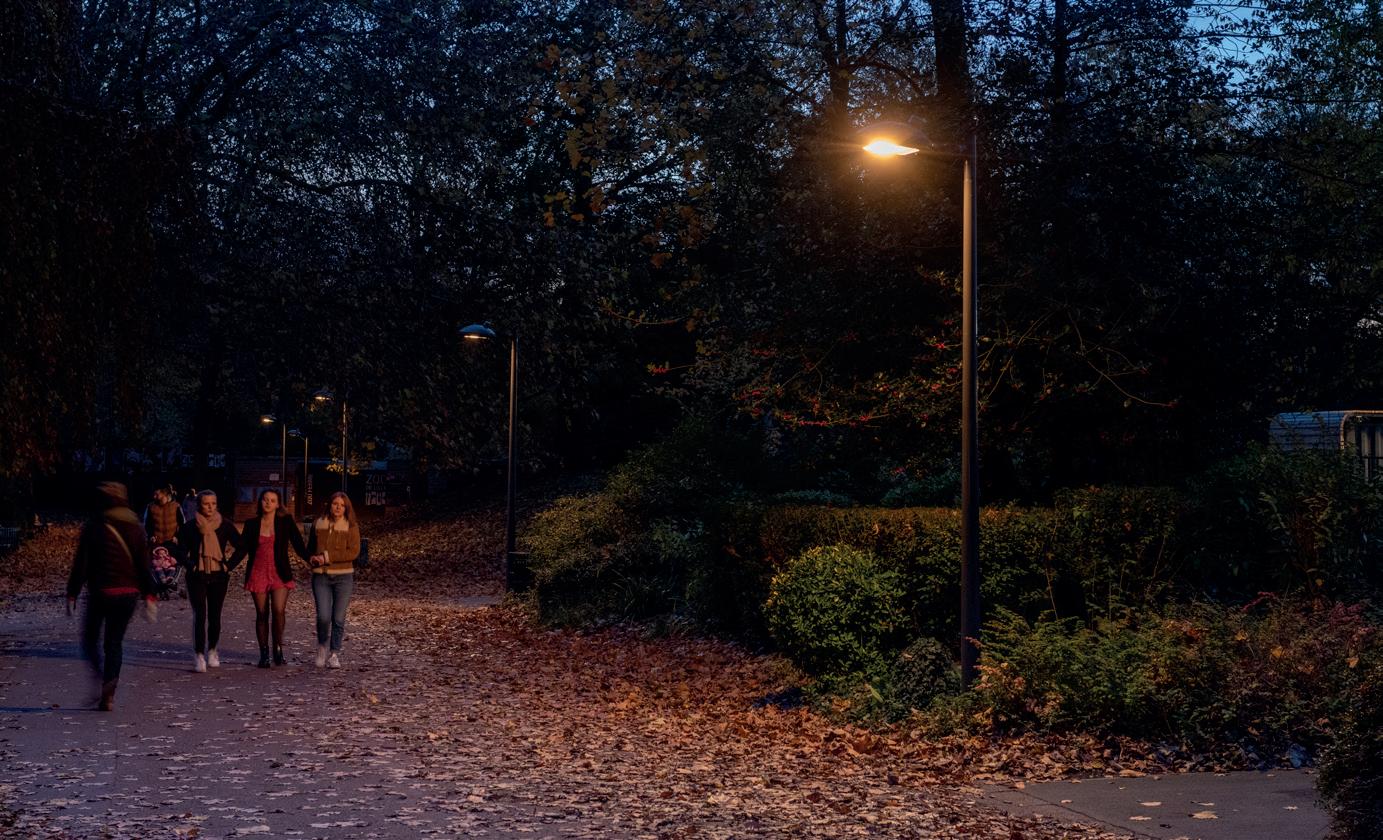
This brings us on to what lighting can’tdo. In my view, lighting – on its own – doesn’t prevent crime. It has to be aligned with a wider strategy for that neighbourhood. Lighting isn’t just a ‘thing’, it is a service, and how and where it is provided makes a huge difference.
We’ve also realised when working on safety-driven projects that there are a lot of stakeholders. Local authorities, police, business improvement districts, developers, architects, lighting designers, residents’ associations, community safety teams and so on… reaching a decision is hard. You can’t please everyone; there will never be a perfect solution. But what we have found is engagement and communication helps make intelligent choices.
Furthermore, you need collaboration across all of these functions to deliver sustainable schemes; the wider environment will impact on both actual and perceived safety.
Sight lines and the environment, too, have a huge impact. A well-lit alleyway will still feel intimidating if trees and shrubs are overgrown. The foliage will provide areas to hide and cast shadows. Will the lighting integrate with CCTV, and what other considerations are there to be taken into account?
IMPORTANCE OF ‘SEEING’ THE SPACE
Critically, you’ll only identify those issues by being on the ground, by ‘seeing’ the space, and understanding the lighting.
I’ve written previously about the danger of just relying on ‘the numbers’, the current lighting standards, to deliver the right lighting scheme. So, if we’re working to the guidance provided in BS5489-01 (2020) crime is
one of the criteria that should be used to help select the appropriate lighting class [10]. However, it’s extremely rare that detailed crime information is provided at a locational basis because of the potential for victim identification.
So, decisions on the lighting class are then made without this piece of data — and in many cases without actually visiting the site either before or after.
Over the years, at Urbis Schréder we’ve carried out many site visits and light level checks in nice – and less nice – parts of cities and towns all over the UK and Ireland. In some instances, we’ve gone out after dark to measure actual lighting levels and found the ‘numbers’ achieved aren’t even
www.theilp.org.uk
JULY/ AUGUST 2023 LIGHTING JOURNAL 10
the numbers that the end user thought they had. In any discussion about safer streets, there is no substitute for being there and experiencing the space, both before and after.
In many cases, the reported issue with lighting being poor or unsafe isn’t actually down to the lighting but other environmental factors. A good example of this was from a recent visit to west London to carry out a review of areas and streets where the residents and community safety officers had raised concerns regards poor or inadequate lighting.
In one particular location the measured lighting level was actually fine, but the perception was awful. Why? The location felt really dark because of a massive illuminated digital advertising hoarding right in your field of view, which effectively wiped out any night vision, hence the reported resident concerns.
In another location an alleyway was reported as being poorly lit and it had been flagged as a mugging hotspot. When we went to visit, the lighting was actually OK,
although one of the luminaires was partially obstructed by overgrown foliage from a private garden. The second point to consider was that the actual crime location was just outside the alleyway, so overall lighting intervention on its own would not have materially affected crime outcomes for that location.
So how do we put this into practice? Lighting for safety means making intelligent choices about the space. That means engagement with all the stakeholders and aligning any lighting approach with other environmental interventions. We should also consider a layered approach, and think also about vertical / surround illumination. Arup in its paper ‘Perceptions of Night-Time Safety: Women and Girls’ has articulated this really well [11]
To light or not to light? Where do you want to encourage people to go, or not? Do you make a more populated route more inviting, meaning more ‘eyes on the street’ and deter the use of less populated routes? What is important is making an informed decision? How do we make sure we are not letting money drive the decision-making process?
Over time, what we’ve learnt at Urbis Schréder is that good uniformity is more important than higher lighting levels when it comes to safety, and contrast should be minimised.
Bright spots contrasting with dark shadows in between do not create a reassuring walk home. In addition, excessive light levels have a negative impact on the environment and, of course, waste energy.
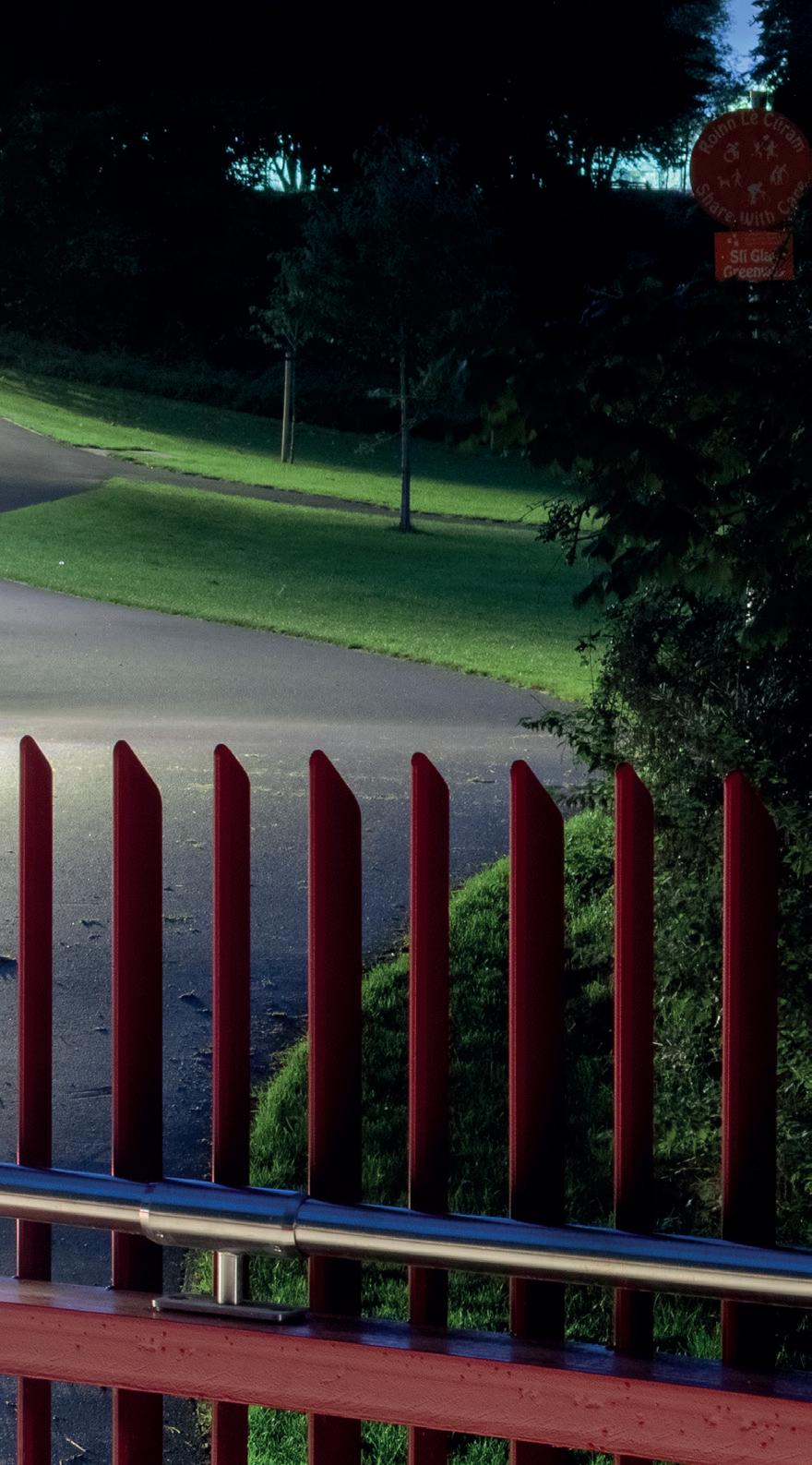
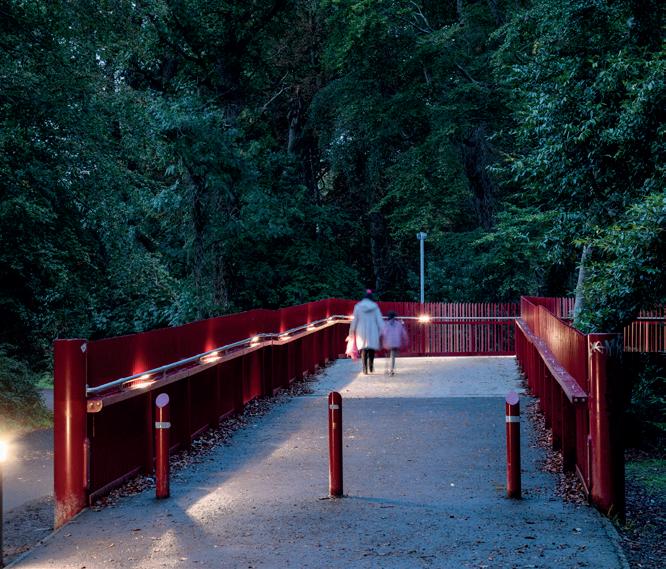
Control or remote lighting management is essential, as it allows you to tailor the lighting level to different tasks at different times. But it is also important to provide an instant override if needed or requested by attending services.
Communication matters, too. It is important to engage with all stakeholders – and that means having open dialogue with non-lighting people.
CONCLUSIONS
As a final thought, of course we can change the lighting within a space. But how do we know whether the lighting has had a positive or negative – or even any – impact? Therefore, we need more engagement
Lighting and safety
with and analysis of the data before and after. What would be interesting would be to get feedback on the impact of interventions. Fundamentally, we need more evidence and research into this topic so that we, as lighting professionals can support and provide advice on good practice.
We also need to monitor unintended consequences, such as crime displacement, and ensure we think really carefully about the diverse nature of modern cities. The focus on VAWG (violence against women and girls) has made everyone more aware of the topic. But everyone – young people, the elderly, BAME citizens, LGBTQIA+ individuals – all have a different experience of walking through the city after dark.
There is no singular user that public spaces should be designed for: such spaces therefore have to be for everyone. And we can’t simply ‘design out crime’ with the one tool we have at our disposal, we need that stakeholder engagement. Moreover, lighting won’t resolve societal issues.
Good street lighting can create spaces where people want to congregate, make them feel safer and create a welcoming environment for everyone. Done right, lighting complements the utility and distinguishing characteristics of the local environment.
It helps people work, play and move around – and yes, it can make people safer. But this will only happen if it’s part of a holistic approach to urban life, and one where stakeholders realise there are no instant fixes.
[1]‘Street lighting may enable rather than hinder street crime’, UCL, March 2022, https://www.ucl.ac.uk/news/2022/mar/street-lighting-may-enable-rather-hinder-street-crime; ‘Light fingered’, Lighting Journal April 2022, vol 87, no 4 [2] Edwards P et al (2015), ‘The effect of reduced street lighting on road casualties and crime in England and Wales: controlled interrupted time series analysis’, Journal of Epidemiology and Community Health, vol 69, issue 11, https://jech.bmj.com/content/69/11/1118 [3] Welsh B C, Farrington D P, Douglas S (2007). ‘The impact and policy relevance of street lighting for crime prevention: A systematic review based on a half-century of evaluation research’, Criminology & Public Policy, DOI: 10.1111/1745-9133.12585, https://prohic.nl/wp-content/uploads/2022/05/389-StreetLightingEffectivenessPreventingCrimeSystematic Review.pdf; ‘Effectiveness of Street Lighting in Preventing Crime in Public Places’, (2021) Swedish National Council for Crime Prevention, https://prohic.nl/wp-content/uploads/2022/01/327-StreetLightingEffectivenessPreventiongCrimePublicSpacesSystematicReview.pdf [4] ‘What would make the UK safer for women, according to women?’, YouGov, May 2021, https://yougov.co.uk/topics/politics/articles-reports/2021/05/10/what-would-make-uk-safer-women-according-women [5] ‘Perceptions of personal safety and experiences of harassment, Great Britain: 16 February to 13 March 2022’, Office for National Statistics, May 2022, https://www.ons.gov.uk/peoplepopulationandcommunity/crimeandjustice/bulletins/perceptionsofpersonalsafetyandexperiencesofharassmentgreatbritain/16februaryto13march2022 [6] ‘Crime Reduction Toolkit’, College of Policing, https://www.college.police.uk/research/crime-reduction-toolkit [7] College of Policing: ‘Interventions for situational crime prevention’, https://www.college.police.uk/guidance/neighbourhood-crime/interventions-situational-crime-prevention; ‘Physical environment interventions’; https://www.college.police.uk/guidance/interventions-reduce-violence-against-women-and-girls-vawg-public-spaces/physical-environment-interventions; ‘Street lighting’ https://www.college.police.uk/research/crime-reduction-toolkit/street-lighting [8] Secured by Design, https://www. securedbydesign.com/guidance/design-guides [9] ‘Safer Streets Fund evaluation’, Home Office, January 2023, https://www.gov.uk/government/collections/safer-streets-fund-evaluation [10] BS 5489-1:2020 – TC ‘Design of road lighting Lighting of roads and public amenity areas. Code of practice’, BSI, May 2020, https://knowledge.bsigroup.com/products/design-of-road-lighting-lighting-of-roads-and-public-amenity-areas-code-of-practice/tracked-changes [11] ‘Perceptions of Night-Time Safety: Women and Girls’, Arup, https://www.arup.com/projects/perceptions-of-nighttime-safety-women-and-girls
JULY/ AUGUST 2023 LIGHTING JOURNAL 11
Clare Thomas is head of Logic at Urbis Schréder
www.theilp.org.uk
PARKS AND RECREATION
Lit well, urban parks can not only be safe spaces for women but year-round whole-community hubs, for people of all ages. So, why, as a conference recently asked, are so many still so poorly lit and badly maintained?
By Nic Paton
It is estimated that, across the UK, as many as 27,000 parks give our nation much-needed access to nature within urban areas. As we perhaps felt most keenly during the lockdowns of the pandemic, our green spaces are invaluable places for exercise, play, socialising and relaxing, good for both our physical and mental health.
Yet, especially as night falls or dusk settles, and particularly in the winter months when it can be dark by late afternoon, many of our parks and public spaces can become much less welcoming, threatening or even unsafe. This is especially the case for women, and in

particular for lone women after dark.
Last year, a survey by the Office for National Statistics found that women feel considerably more unsafe than men across all types of public settings, especially after dark [1]. As many as four out of five UK women (82%) report feeling very or fairly unsafe after dark in a park or open space compared with two out of five men (42%), the same study concluded. Research by Girlguiding, meanwhile, has found that more than half of girls aged 11-21 (53%) do not feel safe outside alone [2]
It was against this rather depressing backdrop that, in May, Leeds University brought
together a wide range of high-level speakers, including academics, politicians, safety specialists and lighting professionals to discuss the subject of ‘Women and Girls: Safety in Parks’.
The university’s Dr Anna Barker and Professor George Holmes were among the speakers, and their research on what makes a park feel safe or unsafe is looked at in more detail in the next article. There were presentations from Tracy Brabin, the Mayor of West Yorkshire and Marina Milosev of the London Legacy Development Corporation, who spoke on her experience of lighting the Queen Elizabeth Olympic Park and Detective Superintendent Vanessa Rolfe of West Yorkshire Police, among others.
PERCEPTION OF SAFETY
One critical aspect of this conversation, of course, is the role that light and artificial lighting can play in creating safer spaces and, as importantly, creating the feeling –the perception – of safer spaces. This was something emphasised in a presentation at the conference by Elettra Bordonaro, co-founder of lighting design consultancy Light Follows Behaviour.
Back in 2020, Elettra, as regular readers may recall, discussed in these pages how social housing can sometimes end up with ‘poorer’ second-tier lighting solutions because some local authorities feel it is just, well, social housing (‘Social value?’, July/ August 2020, vol 85 no 7).
Catching up with Elettra after this latest conference, it was clear that, from her perspective at least, some developers and local authorities have an equally long way to go to understand the ‘value’ (in all senses of the word) of properly lighting their park infrastructure.
‘In some places I’ve worked, the solution after there has been a serious incident in a park is simply to switch off the lighting, which is a totally bizarre response,’ she tells LightingJournal. ‘Equally, I’ve experienced councillors who feel that, because they’ve
JULY/ AUGUST 2023 LIGHTING JOURNAL 12
Lighting and safety
“solved” the lighting in one park, that’s it, job done; now it’s just a case of copying and pasting that approach across the rest of their part estate. But it really doesn’t work like that.’
What, then, is the answer? The first thing local authority teams and decision makers and lighting professionals need to understand is why having good lighting in parks is so important, not just to women but to anyone who uses parks after dark, Elettra argues. It’s not just about the individuals who are using the space (although that is important), it’s what a well-lit and well-maintained park also says about the vibrancy of a community, its cohesion and integration – and its night-time economy.
‘It’s about understanding how the wider park environment connects with and feeds into perceptions of safety, and how these need to link to and complement the surrounding more urban environment. It’s about, very simply, understanding the space you’re dealing with, at all times of the day and in different seasons. And, within all that, understanding if, with the right lighting, you can improve things,’ Elettra explains.
Elettra highlights how, at Light Follows Behaviour, night walks and community workshops – almost community co-design –are often an integral part of the design process. ‘We work to understand the situation in that particular park first. With some councils, they maybe don’t want to light up the park at night; they may be worried about obtrusive light or light pollution or energy costs or flora and fauna,’ Elettra adds.
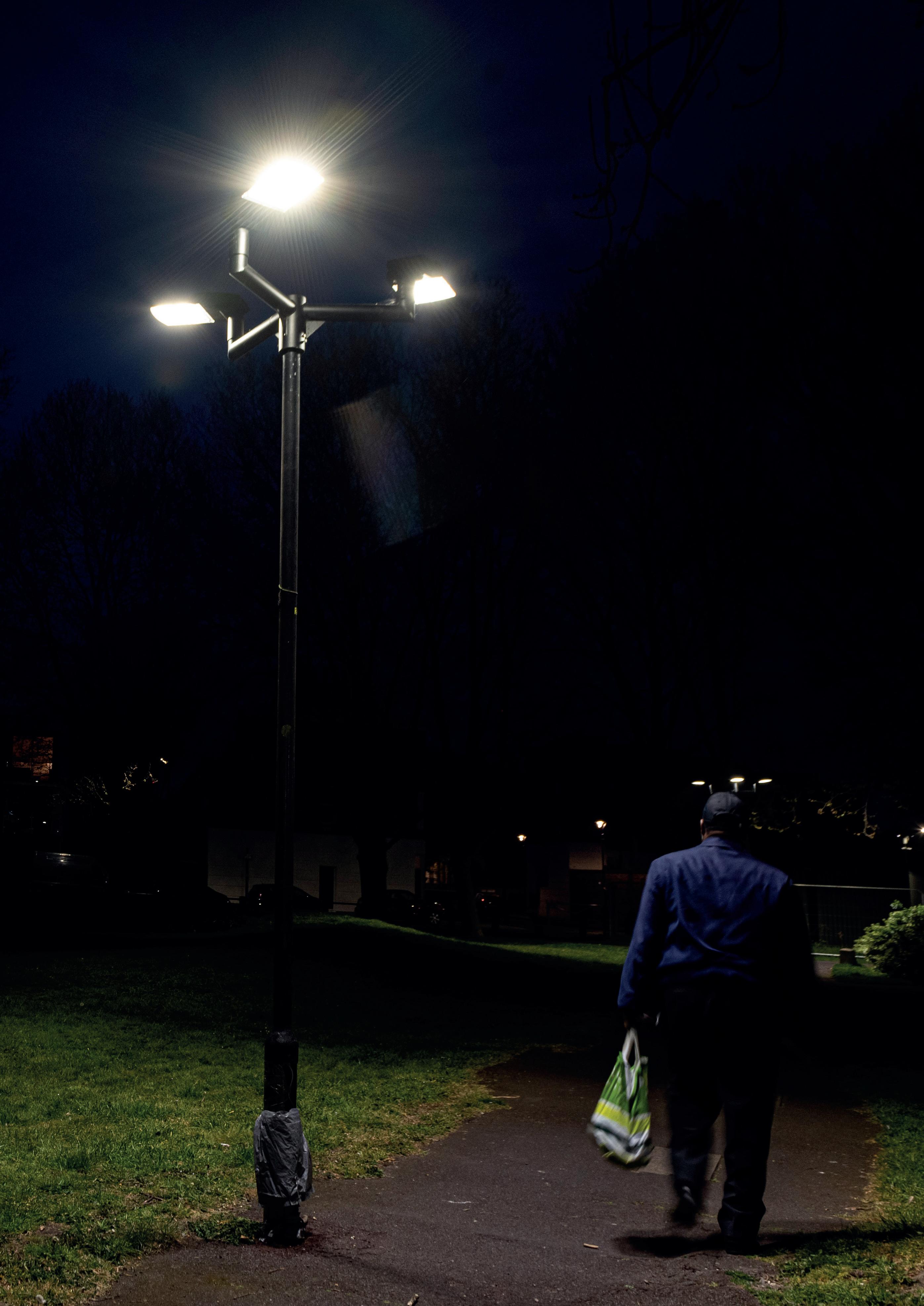
www.theilp.org.uk JULY/ AUGUST 2023 LIGHTING JOURNAL 13
Lighting and safety
That, of course, highlights one of the most important tensions here: balancing safety with ecology and overly obtrusive, polluting light. As Elettra recognises, you of course want your scheme to be well-specified, installed and directed. ‘You don’t want a million lux flooding the space (and, in fact, a really bright and glary lighting scheme can be intimidating at night too). Yes, too, you need to consider the local ecology of the area, especially bats and insects.
‘However, at the same time, especially with urban parks, you need to recognise you’re going to be designing near areas that are brightly lit anyway; whatever you do there is probably going to be an element of skyglow, light from high-rise blocks, from retail units, from traffic and so forth spilling into the space,’ she adds.
CLEAR WAYFINDING
When it comes to safety and perceptions of safety in these sorts of spaces, clear wayfinding is absolutely imperative. ‘As a woman in a park at night if you can see, clearly, what the route is through the park, that is going to make such a difference,’ Elettra explains. ‘That there aren’t unexpected dark patches, or dead ends, or places where, say, all of sudden you find you’re on a badly lit, narrow path between bushes or trees. So, it is absolutely critical that the lighting designer effectively collaborates with the landscape architect.’
Within this, clear (and often illuminated) signage is also an important part. ‘What we’re looking to achieve is soft lighting that makes you feel comfortable both on the path and within the surroundings. You can and should of course try to leave parts of the park dark, but at least ensure you have a network of safer routes that people are going to feel safe to run on and walk on at night. Routes through parks are sometimes almost the only connections between neighbourhoods,’ Elettra recommends.
Furthermore, as touched on earlier, there’s the context of the park in different seasons to be taken into consideration. It is important to understand that it is not necessarily ‘night’ per se that is the issue here and more simply ‘after dark’. After all, in the UK a park in the middle of winter, is dark by 4pm. It will be – and feel – very different to a park at 11pm on a warm summer’s evening.
As Elettra explains: ‘Is the feeling you have at 8pm in winter comparable to the feeling you have at 10pm in the summer? No, it’s probably not. There will probably be many
more people around at the point of the summer than there will be in the winter. So it is not only lighting related; it is also related to things such as facilities, to other people in the park.
‘Moreover, within this, it is important to recognise that “after dark” is not “late night”, especially in winter. In winter, it can encompass the school run, commuter rush hour, after-school or after-work activities (or travelling to and from them), and community engagement events (or, again, travelling to and from),’ she adds.
HOLISTIC COMMUNITY APPROACH
This, in turn, brings us back to the importance of thinking about the space you have in the park in the round, how the park – and the lighting within it – connects to, colours and contrasts with the wider urban community around it.



‘If along and around the park you have lit activities, if you have spaces where families and children are going to feel welcome –especially year-round activities – those
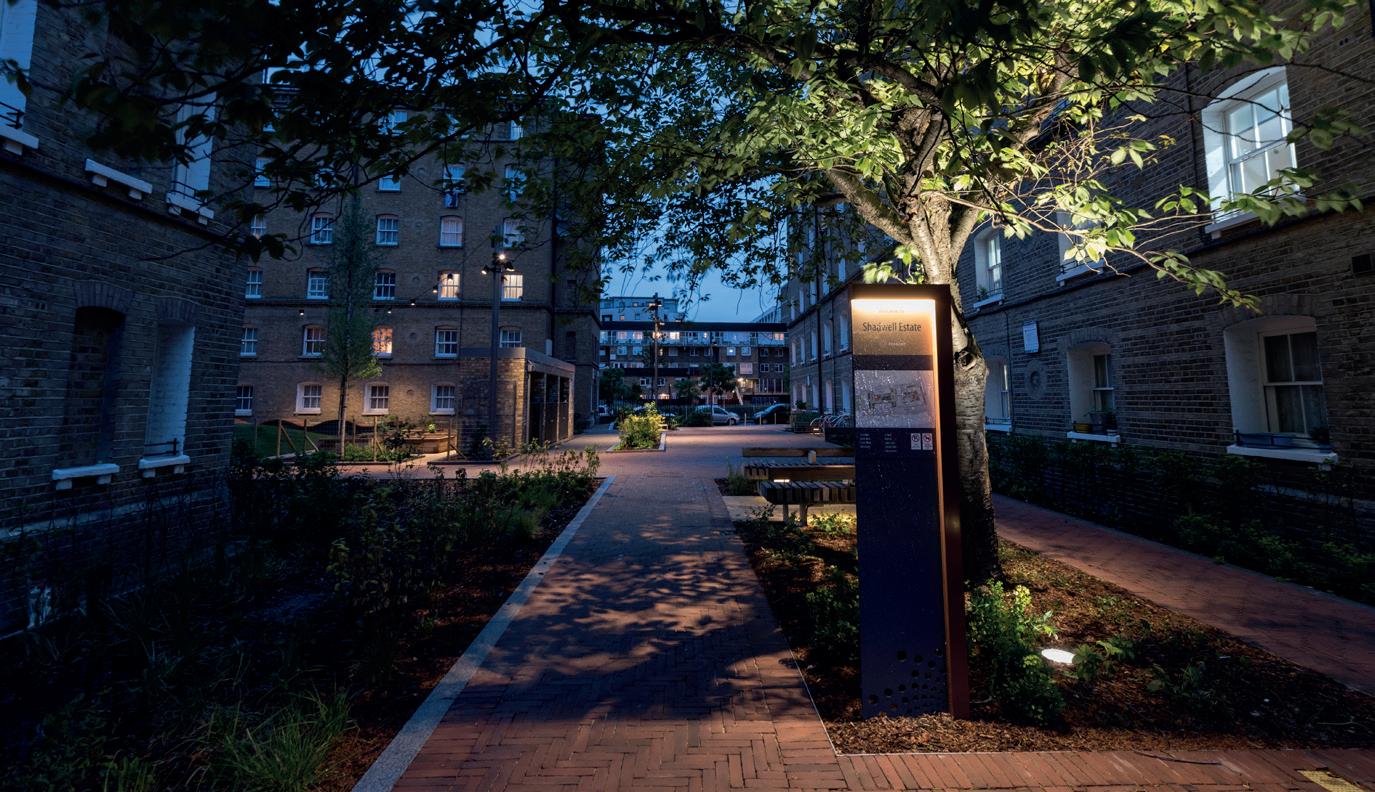
JULY/ AUGUST 2023 LIGHTING JOURNAL www.theilp.org.uk 14
London’s Shadwell Estate, where, as part of the Peabody IMPROVE programme, Light Follow Behaviour’s lighting scheme focused on giving its residents an improved outdoor experience, including in terms of safety and wayfinding







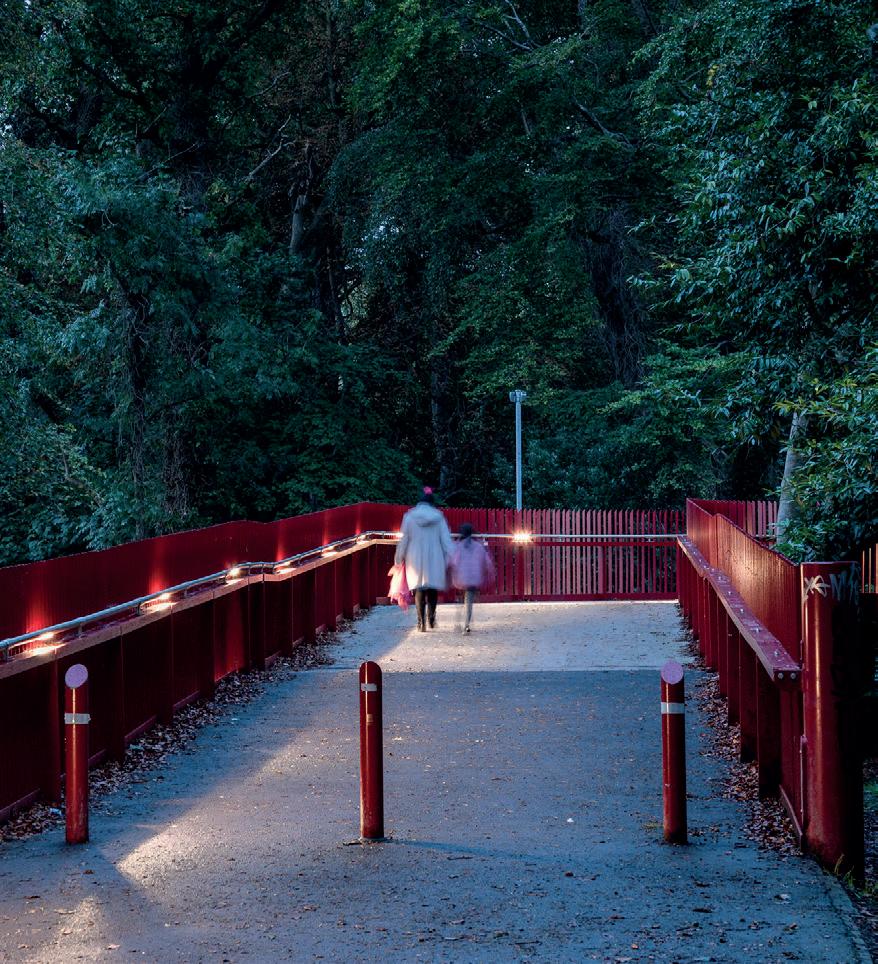




































































Talk to us about making the right connections. Get in touch at logic@urbis-schreder.com Smart integrated solutions that protect and prioritise .
is YOUR hollistic
to making the right
dark skies safety Urbis Schréder
-
approach
choice
Lighting and safety
spaces automatically are going to feel safer,’ Elettra points out.
‘Thinking about your park space holistically in this way – so maximising how and when it is used all year around – is also probably going to lead to wider economic, social and community benefits, more community engagement and involvement, more cohesion, too. You’re much more likely to “activate” the space,’ she advises.
Extreme glare/contrast from badly specified or positioned light sources can be bad not just for light pollution but for damaging night vision and creating dark, intimidating spaces around the periphery, Elettra also highlights.
Furthermore, poor semi-cylindrical illumination can lead to spaces that have poor facial recognition, spaces where there is a risk of people looming at you out of the darkness – and this is something Khalid Hamoodh and Professor Steve Fotios discuss later in this edition.
‘Extreme darkness on main corridors and extreme darkness at the edges of spaces can both be issues. I’d argue we can often be a bit more sophisticated in the way we are lighting up the space within an urban park,’ Elettra argues.
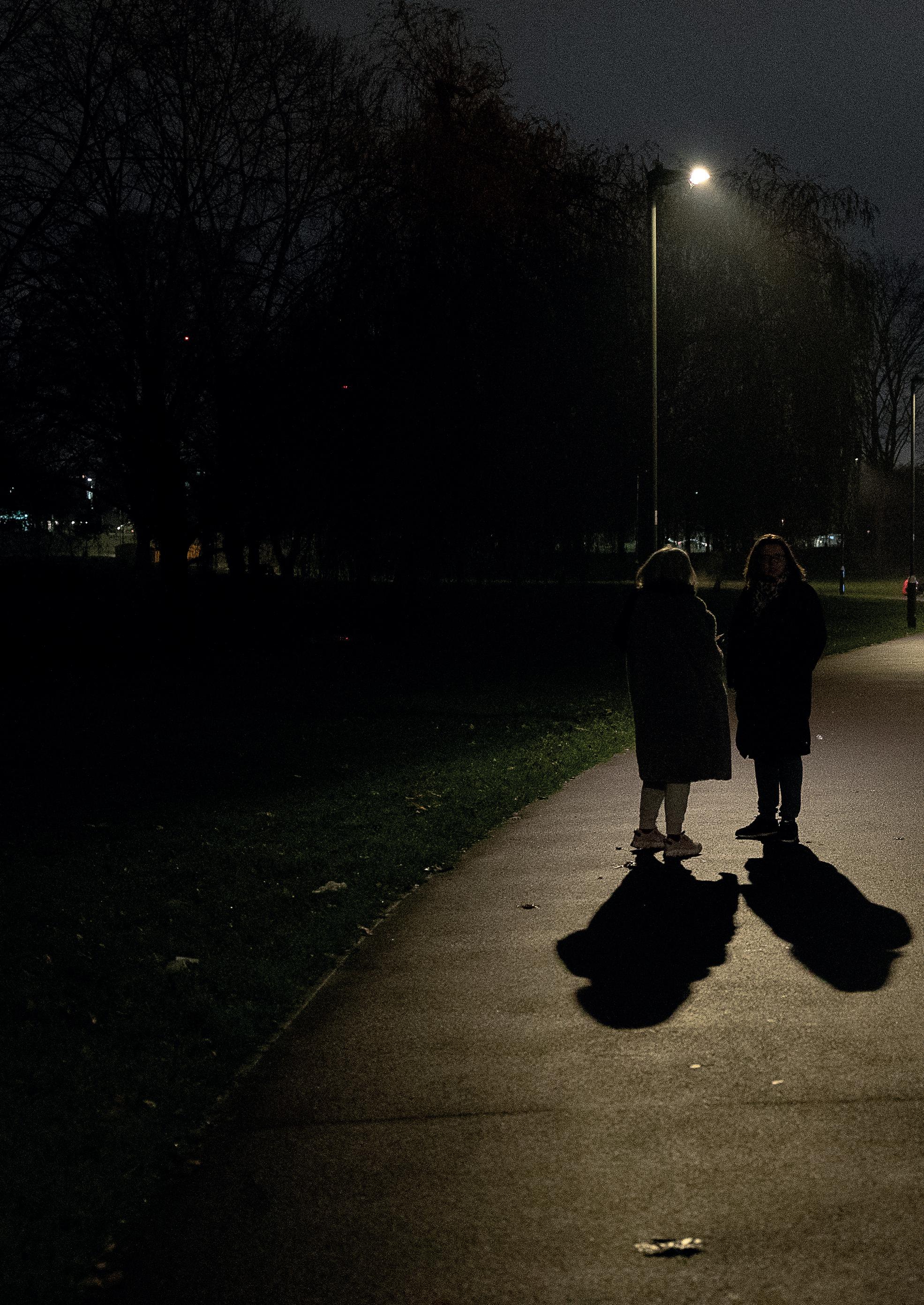
‘We can look at vertical lighting and the way that we are perceiving colour rendering in the space. People often say colour rendering is not that important in urban spaces, but I think it is. If I need to detect the colour of a shirt or to make out someone’s face as they’re approaching me, for example.
‘Having good uniformity, good colour rendering means people can, simply, see better, with a lack of uniformity leading to the opposite. It means they may be more attracted to the place, to the space, because it is acting a like a beacon.
‘You can see through it; you can see there is a destination you can reach at the other end. In that sort of space, you’re going to feel that much safer. Which comes back to coordinating with the landscape architect, the playground design, the planners and so on,’ she adds.
CONCLUSIONS
Councils, Elettra argues, need to be encouraged to look at their green urban spaces holistically, to see ‘safety’ as not just ‘a women’s issue’ but, if you can crack it, as a way of turning your urban parks into lively, friendly, outdoor community hubs all year round, spaces that will benefit the whole community as well as the night-time economy.
‘With good lighting just one (if important) part of this transformation. You can’t, and mustn’t, look at a site in isolation; context is everything,’ she points out.
Good, ongoing, effective maintenance needs to be an important adjunct to this.
‘Good park lighting is also, normally, well-maintained park lighting. That will, and should, mean council teams and/or lighting department teams being prepared to visit their parks after dark, winter and summer, to see, know and understand what’s going on on the ground. Rather than women having to find out for themselves – the hard way,’ Elettra argues.
Finally, while universities such as Leeds are clearly doing valuable research in this area, there is an argument for the development of more lighting guidelines specifically to address these issues, Elettra emphasises.
‘We need better analysis of what works and what doesn’t from a lighting perspective in urban parks after dark; we need, too, better planning and design to become the norm,’ she says in conclusion. ‘Maybe this is the something the ILP could consider down the line, or SLL, or maybe both?’
• Turn to page 18 for an analysis of the Leeds University safer parks research and page 34 for a discussion on Sheffield PhD student Khalid Hamoodh’s research into facial identity recognition.
[1] ‘Perceptions of personal safety and experiences of harassment, Great Britain: 16 February to 13 March 2022’, Office for National Statistics, May 2022, https://www.ons.gov.uk/peoplepopulationandcommunity/crimeandjustice/ bulletins/ptionsofpersonalsafetyandexperiencesofharassmentgreatbritain/ 16februaryto13march2022 [2] ‘A snapshot of girls’ and young women’s lives’, Girlguiding, https://www.girlguiding.org.uk/girls-making-change/girls-attitudes-survey/
JULY/ AUGUST 2023 LIGHTING JOURNAL www.theilp.org.uk 16
Don’t Switch to Solar
It isn’t right for every project.

BUT when the calculations work…
It’s light without ongoing energy costs. Without trenching costs. A permanent or temporary lighting and energy storage solution that can also be used to power CCTV and other Smart City sensors.
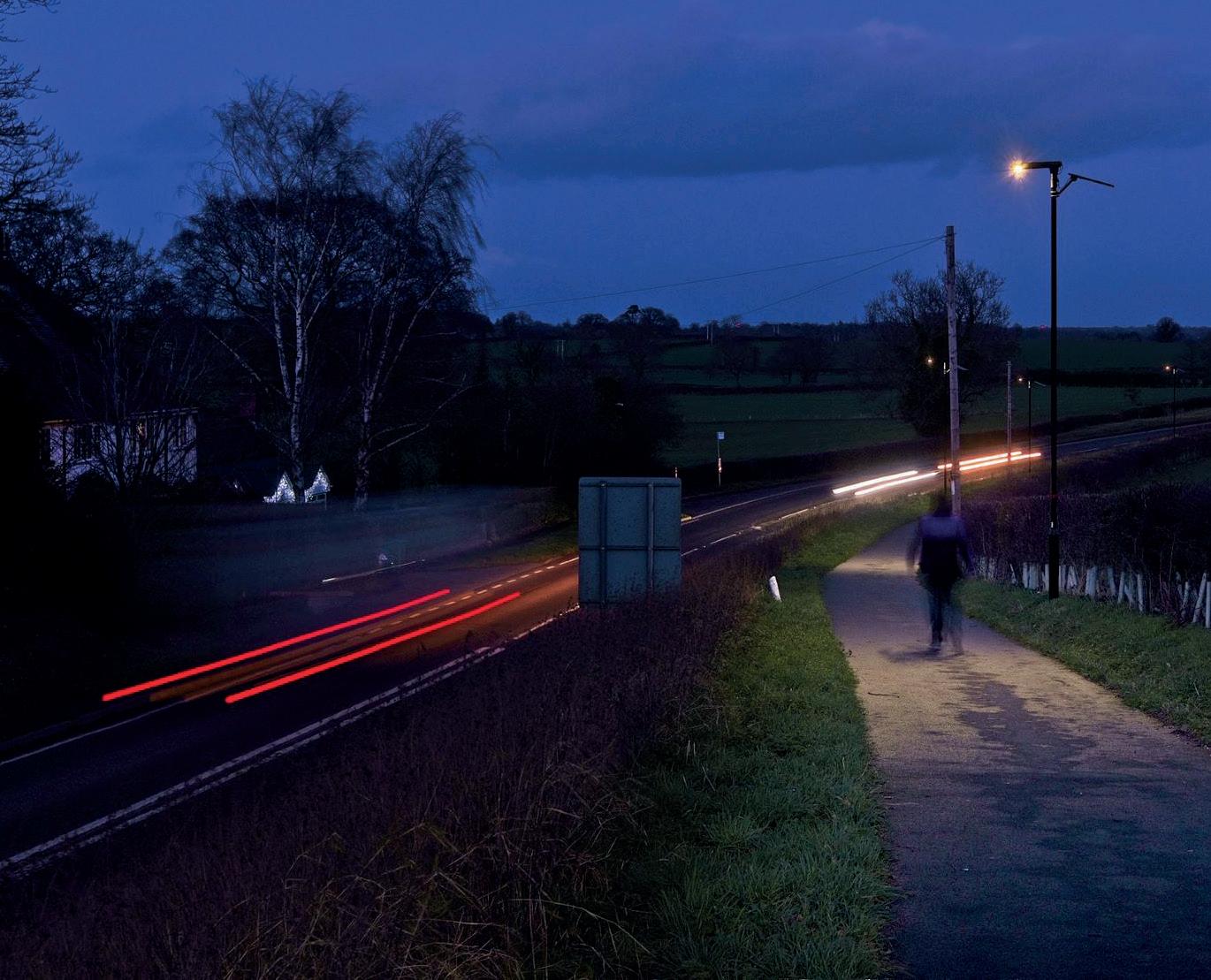
Challenge us – see if a solar solution could work for you. acrospire.co

SAFE PASSAGE

JULY/ AUGUST 2023 LIGHTING JOURNAL 18
women and girls’ views on what would make parks feel safer and more accessible public places. Indeed, research shows that welldesigned lighting can play a role in reducing fear and increasing use of space as well as reducing crime, providing opportunities for more equal access to public spaces and assisting women to foresee and respond to potential harms,’ it added.
The women interviewed by the academics agreed on eight areas:
By Nic Paton
Improving lighting in Britain’s parks, especially urban parks, would significantly help women and girls to feel safer in these spaces at night. Yet, by itself, better lighting is not a panacea solution, as it still leaves untouched the structural and cultural factors that underpin violence and harassment against women.
This is one of the key conclusions from a University of Leeds research report, ‘What makes a park feel safe or unsafe?
Theviewsofwomen,girls,andprofessionalsinWestYorkshire’[1]
The report, led by the criminal justice professor at the university Dr Anna Barker and co-authored by colleague conservation specialist Professor George Holmes, was the springboard for last month’s ‘WomenandGirls:SafetyinParks’conference at Leeds, as discussed in the previous article by Elettra Bordonaro.

The study, conducted across West Yorkshire in 2022, carried out interviews with 67 women aged 19-84 years, 50 girls and young women aged 13-18 years, and 27 professionals from parks and urban design services in local government and police.
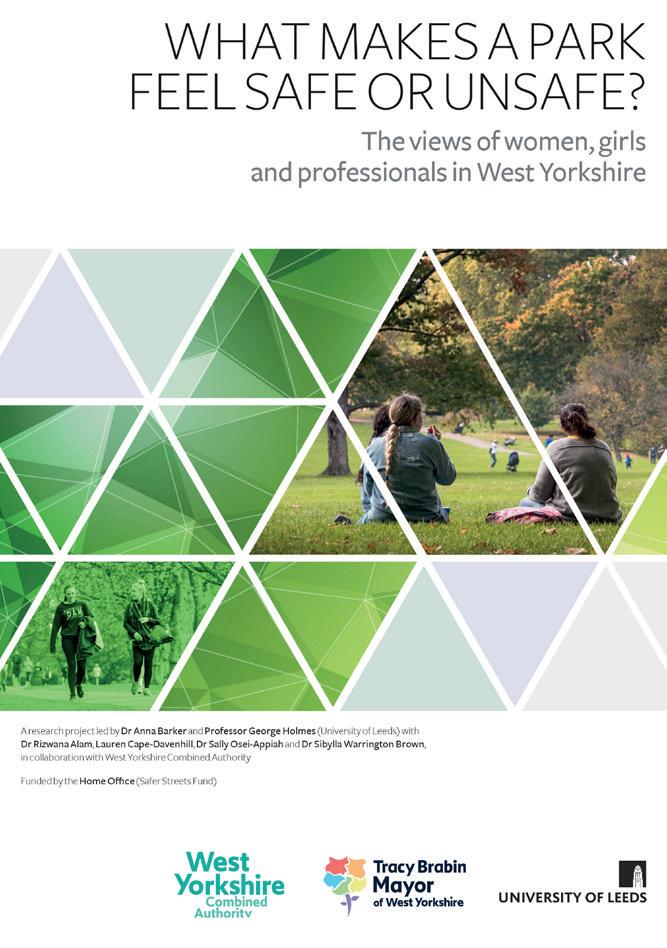
Worryingly, most of the women and girls believed their local parks were unsafe. More than half felt they were very unsafe.
Lighting, it was also clear from the findings, does have a pivotal role to play in improving safety and perceptions of safety in these spaces, especially in the darker winter months.
PARKS ‘INACESSIBLE’ TO WOMEN
As the research stated: ‘Women and girls avoid parks after dark because they do not feel safe. In certain seasons with shorter days, parks without lighting become inaccessible to many women in early mornings and from late afternoons.
‘Lighting is very important to some
1. Well-used parks generally feel safer because of increased passive surveillance (or the visibility of staff, volunteers or other users) and more opportunities to seek help. Facilities, activities, mixed uses and staffing throughout the day all help to support this sense of busyness.
2. The presence of other women in parks will often be reassuring and signal it is a safer place but women-only areas were not felt to be the solution.
3. Organised group activities supported women to feel safer and extended their use of parks, though the choice and timing of activities could often be expanded.
4. Fences or walls around the edges of parks limited escape and visibility, whilst openness of spaces felt safer by enabling women to spot dangers earlier and, if necessary, take action.
5. Women generally felt safer ignoring than challenging unwanted comments and attention in parks, so as to avoid escalation and unsafe situations. Yet, they also recognised that leaving male harassment unchallenged simply perpetuates injustice.
6. Seeing other users of a similar identity in parks will often feel reassuring, though there was agreement that a diversity of users suggested parks were inclusive.
Lighting and safety
7. Women felt they could not rely on other park users to intervene in instances of harassment, but wellused parks did increase the probability of bystander intervention.
8. Mobile phone apps where women allow trusted contacts to track their journeys can be useful in parks but bring with them an unwelcome trade-off of freedom for safety.
PERSPECTIVES OF PROFESSIONALS
By comparison, while the professionals interviewed by and large had similar views on how to support women to feel safe in parks and what makes parks feel unsafe, they disagreed with the idea that noparks are safe for women and girls after dark.
Signs of disorder, people behaving inappropriately or unpredictably and using drink or drugs make women feel unsafe in parks, they agreed. Busier parks were and felt safer. Parks needed to be designed with

The importance of welldesigned and maintained artificial lighting in making parks feel safer for women and girls after dark has been emphasised in recent research by the University of Leeds. But it is also clear that better lighting is not the only answer
www.theilp.org.uk JULY/ AUGUST 2023 LIGHTING JOURNAL 19
Roundhay Park in Leeds
Lighting and safety
facilities and amenities that appealed to women, girls and families, thereby signalling parks as safe places.
Visible staffing helped, as did physical interventions, such as lighting and CCTV. Cutting down overgrown vegetation to reduce hidden areas, raising canopies and lowering shrubs could also be beneficial, but had to be balanced between accommodating natural or wooded areas.
In all, 89% of the professionals interviewed felt parks in their area of West Yorkshire were very or fairly safe for women and girls. Yet this compared with only 37% of women and 22% of girls interviewed.
Returning to lighting, there was a feeling among many of the participants that authorities could do more to support women’s independent use of parks. This needed to include better lighting, more visible security, more help points, and more staff presence.
LIMITATIONS OF LIGHTING
However, the researchers also had feedback to suggest badly designed and lit parks simply amplify the risks women can feel anywhere, especially after dark. Therefore, lighting parks in itself will not make parks feel safer, as it won’t stop men hurting women.
‘Lone men in parks are a potential threat, especially given the level of violence against women in society, and aspects of women’s identities, such as age and sexuality, makes them more at risk. But we must shift the burden from women to stay safe; authorities need to do more about harassment, and men’s behaviour has to change. For now, it feels safer using parks with friends or family, ignoring unwanted comments and avoiding secluded and thickly vegetated areas of parks,’ the report argued.
A further view argued that some parks are safe for women, just not ones that are secluded or have thickly vegetated areas and not after dark, as they are designed for daytime use.
Women will by and large avoid parks with bad reputations for drinkers, drug users or groups of men and boys. In this scenario, the answer is probably a higher staffing and police presence as much as it is infrastructure changes, the report highlighted.
In some instances, women identified wellused active travel routes through dark parks as safe because there were lots of people using them, including women.
This, the report emphasised, ‘illustrates that lighting and other physical design interventions should not be standalone solutions but part of a wider strategy to increase use of space and improve passive surveillance to engender feelings of safety.’
NEED TO BALANCE WITH ECOLOGY
The report, however, also recognised that in parks and green spaces there is a need for lighting to be balanced with the ecological needs of the space.
‘Lighting entire parks or all parks across a locality is not practical. Professionals felt that lighting interventions could be appropriate in parks subject to resourcing and opportunity,’ it stated.
‘Hence, decisions should be about where and which parks would benefit from lighting. Notably, women perceived lighting to be important in relation to other “popular” active travel routes, which are well used during the daytime but not after dark in part because of safety concerns and a lack of sufficient lighting.

‘Relatedly, girls pointed out that some facilities in parks are lit, such as MUGAs [multi-use games areas], but not the paths to/from them,’ the report added.
In terms of recommendations, while these were wide-ranging, the report did advise that local authorities should be including specific actions to improve safety and feelings of safety in parks after dark in their park management strategies. This needed also to be considering areas of parks
or routes through parks where there is a need for safe public use.
As it advised: ‘Local authorities and parks managers [should] consider where in parks artificial lighting would add value in supporting park use, active travel and feelings of safety as part of a wider strategy that considers the ecological needs of the site. Where lighting cannot be provided, alternative routes should be signposted.’
As well as local or council-led solutions, the report called for more central government funding to improve the safety of women in parks.

Dr Barker, an associate professor in criminal justice and criminology in the university’s School of Law, said: ‘Overall, we found that women and girls want parks and play spaces to be better designed and managed to be well-used, sociable places that offer a range of activities and facilities that are more welcoming to them.
‘This needs to be the focus of funding and interventions in order to break down the barriers to women and girls using and feeling safe in parks,’ she added.
Professor Holmes, professor of conservation and society in the university’s School of Earth and Environment, said: ‘We found that women and girls’ views on feeling safe in parks were shaped by broader societal issues such as misogyny, harassment and threats of violence.
‘As well as the specifics of park design such as overgrown vegetation, visibility and lighting, we recommend that changes to these spaces must be part of a holistic approach to address root causes of women and girls’ feeling unsafe in public spaces,’ he added.
[1] ‘What makes a park feel safe or unsafe? The views of women, girls, and professionals in West Yorkshire’, December 2022. Dr Anna Barker and Professor George Holmes (University of Leeds). With Dr Rizwana Alam, Lauren Cape-Davenhill, Dr Sally Osei-Appiah and Dr Sibylla Warrington Brown, in collaboration with West Yorkshire Combined Authority. Funded by the Home Office (Safer Streets Fund). Available at: https://eprints.whiterose. ac.uk/194214/1/Parks%20Report%20FINAL%207.12.2022.pdf
JULY/ AUGUST 2023 LIGHTING JOURNAL www.theilp.org.uk 20
Locked service position


Internal retention safety wire

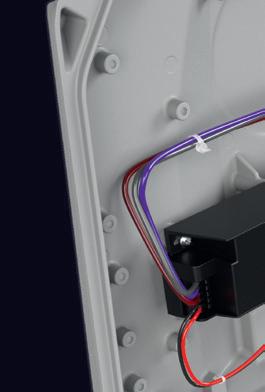


Quick release connections




Aligning spirit level


Removable luminaire head
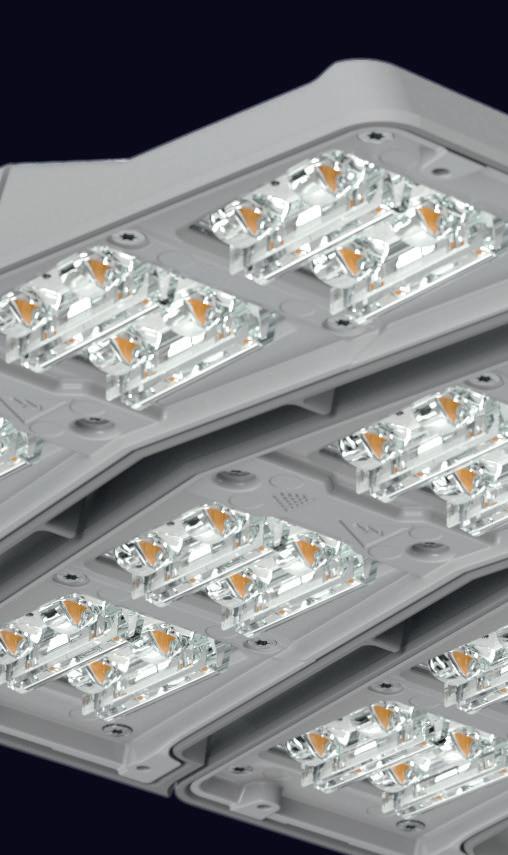




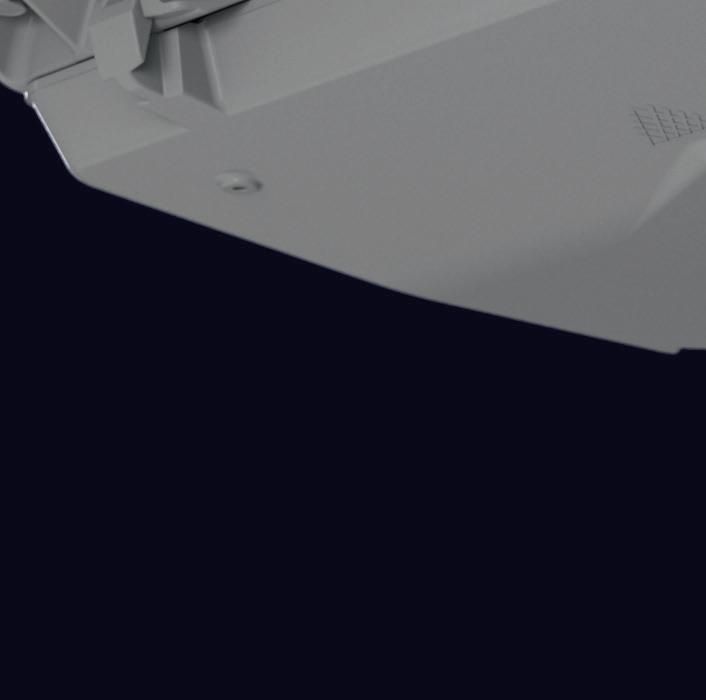

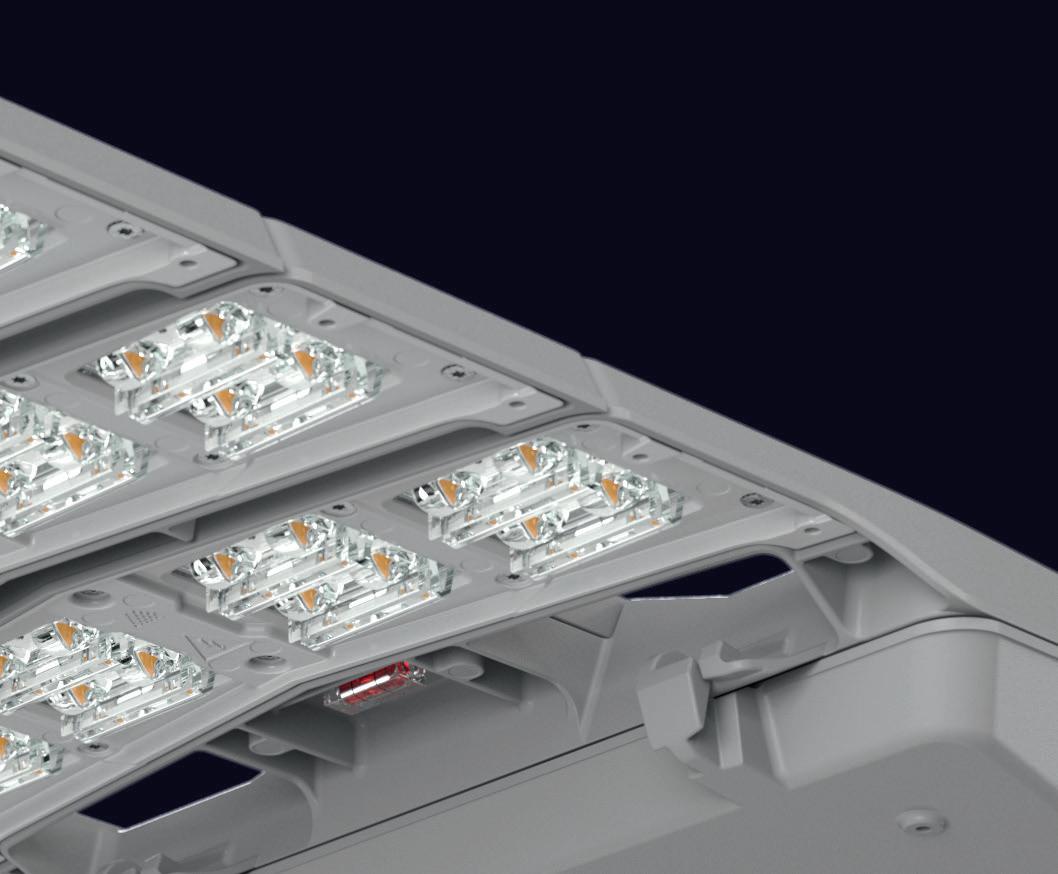

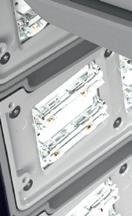

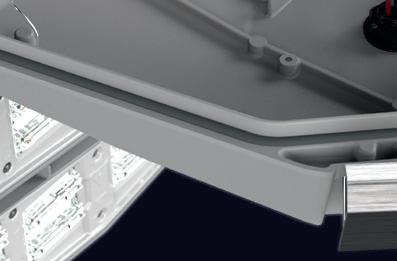
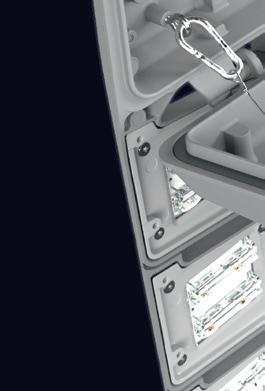
Preliminary TM66 score: 2.8 excellent circularity.


Contact us: info@holophane.co.uk www.holophane.co.uk TM THE ALL NEW
CONTRACTOR FOCUSED FEATURES
3 Capability to supply power to Slow, Fast and Rapid charge points.
3 Complete bespoke design service by expert team.

3 Can be pre-wired for your specific project.

3 Supplied tested & certified ready for installation.


3 Each pillar comes with full technical document pack.

3 New MEGA range designed to meet client demand for larger pillars.
DISTRIBUTION CABINETS FOR EV CHARGE POINTS
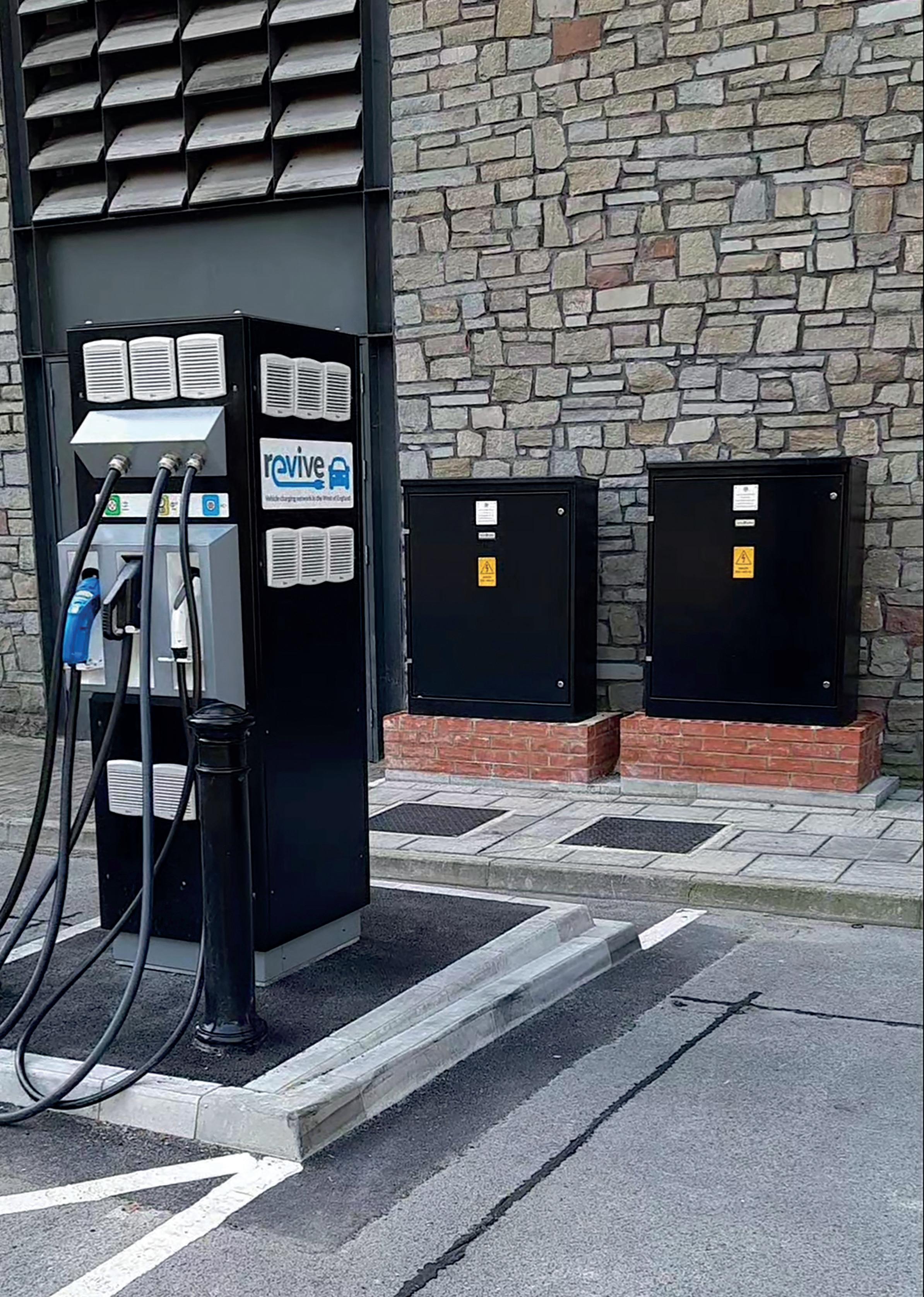
Wessex Way, Wincanton Business Park, Wincanton, Somerset BA9 9RR Reg no 1855059 England CharlesEndirect.com +44(0)1963 828 400 info@charlesendirect.com
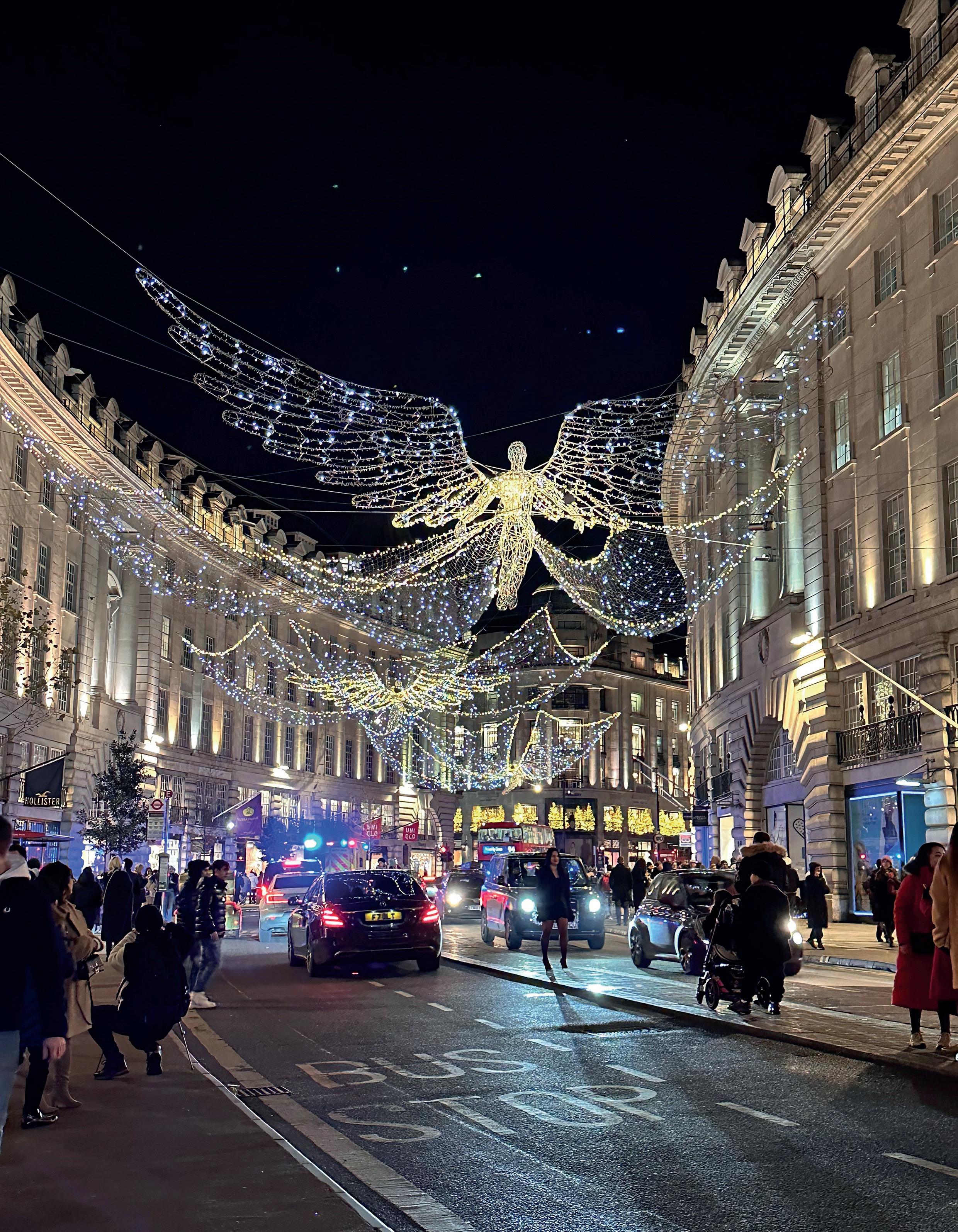




CharlesEndirect.com +44(0)1963 828 400 info@charlesendirect.com Wessex Way, Wincanton Business Park, Wincanton, Somerset BA9 9RR Reg no 1855059 England For a limited time we have up to 20% off Festive Isolators use code CEL20 when requesting a quotation offer expires 31st July 2023
CREATING A MORE ‘LEGIBLE’ PUBLIC REALM

A recent ILP event, ‘City Signs & Lights’, brought together academics and lighting professionals to consider how public realm lighting can be better integrated into – and even lead – urban design and placemaking
By Graham Festenstein
Earlier this year, the ILP collaborated with the Leicester Urban Observatory on ‘City Signs & Lights’ – the first of a series of events to discuss the lighting of public space from a planning perspective, with an emphasis on the integration of lighting with signage and wayfinding, along with the potential for public art to play a role in urban design and placemaking.
The Leicester Urban Observatory is a collaboration between urban practitioners at Leicester City Council and academics at three local universities: De Montfort, Leicester, and Loughborough.
It aims to establish and develop a combined centre of excellence in urban studies and planning for Leicester. Three speakers took part in the event: Grant Butterworth,
head of planning for Leicester City Council; Dr Sean Clark, a digital and multimedia artist who has an interest in community projects and illuminated work; and myself on behalf of the ILP (as I am a lighting designer and consultant specialising in urban lighting).
The evening was introduced by Dr Robert Harland, lecturer in visual communication
JULY/ AUGUST 2023 LIGHTING JOURNAL 24
and reader in urban graphic heritage at Loughborough Heritage. We were joined for discussion by an audience of lighting professionals, planners and architects.
LIGHTING TO SUPPORT PLACEMAKING
The importance and potential of lighting to support placemaking and wayfinding within the public realm is often overlooked, with an over-reliance on street lighting to comply with standards and a design brief. This, in turn, too often precludes proper integration with landscape, architectural design and way-finding strategies.
The ILP as an Institution promotes collaboration between designers, engineers and other consultants involved with public realm design to ensure all users of public space are served, so creating comfortable, legible and safe places that are easily navigated.

Traditionally, the dialogue between lighting designers and planners has been fairly limited, leading to priorities that often do not do justice to the life and community that goes on during the hours of darkness, darkness that in the winter can of course begin as early as 4pm in the afternoon.
Lighting is often seen as a technical engineering exercise executed at the end of a project rather than one integral to the design
Public realm lighting
from the start as it should be. The way a space looks, feels and performs at night is fundamental to success of our urban communities.
The purpose of this and the further events to follow is to bring together lighting designers and engineers with planners and the other disciplines involved in public realm design to better understand how lighting can be supported and strategies developed to achieve these aims.
LIGHTING FOR VISUAL AMENITY
Grant Butterworth started the evening with a discussion around the planning priorities for lighting for visual amenity, protection of the environment and ecology through sensitive and properly considered lighting and the economic benefits of lighting through marketing, tourism and business promotion.
He went on to consider the social benefits of lighting, community safety and the promotion of heritage, architecture and cultural engagement through community events and cultural festivals such as Diwali, which of course is especially pertinent in Leicester, and how all of these areas of discussion are interlinked and the role of the local authority in delivering and managing them.
Grant used examples of Leicester’s
architectural feature-lighting grant scheme to illustrate some of his points along with images of lighting in public spaces.
These included examples of poor lighting, in particular some digital displays demonstrating the potential harm that can be done through bad lighting and when it is not regulated properly through the planning process.
Grant’s concluding statements can be summed up as follows: ‘Lighting can generate and reveal beauty… It can be a valuable and valued community resource. It can protect… It can harm and annoy… So it does need to be managed. Understanding the design process from all technical disciplines is a key objective .’
LIGHTING AND FESTIVALS
Sean’s presentation, meanwhile, discussed a number of public art installations and installations for cultural festivals he has produced, many involving an element of community engagement and or interactivity.
In particular, he discussed his involvement in the ‘Light up Leicester’ light festival. Sean’s work is interested in using technology to explore connectedness, often in a simple yet innovative way and light, lights or illuminated elements figure prominently in much of his work.
www.theilp.org.uk JULY/ AUGUST 2023 LIGHTING JOURNAL 25
Public realm lighting
When working in the public realm, he explained, he is interested in how his lit installations, or the way people interact with his installations, respond to the space or environment they are located within. For example, how they may be connected to or lead people across the city or react to specific locations.
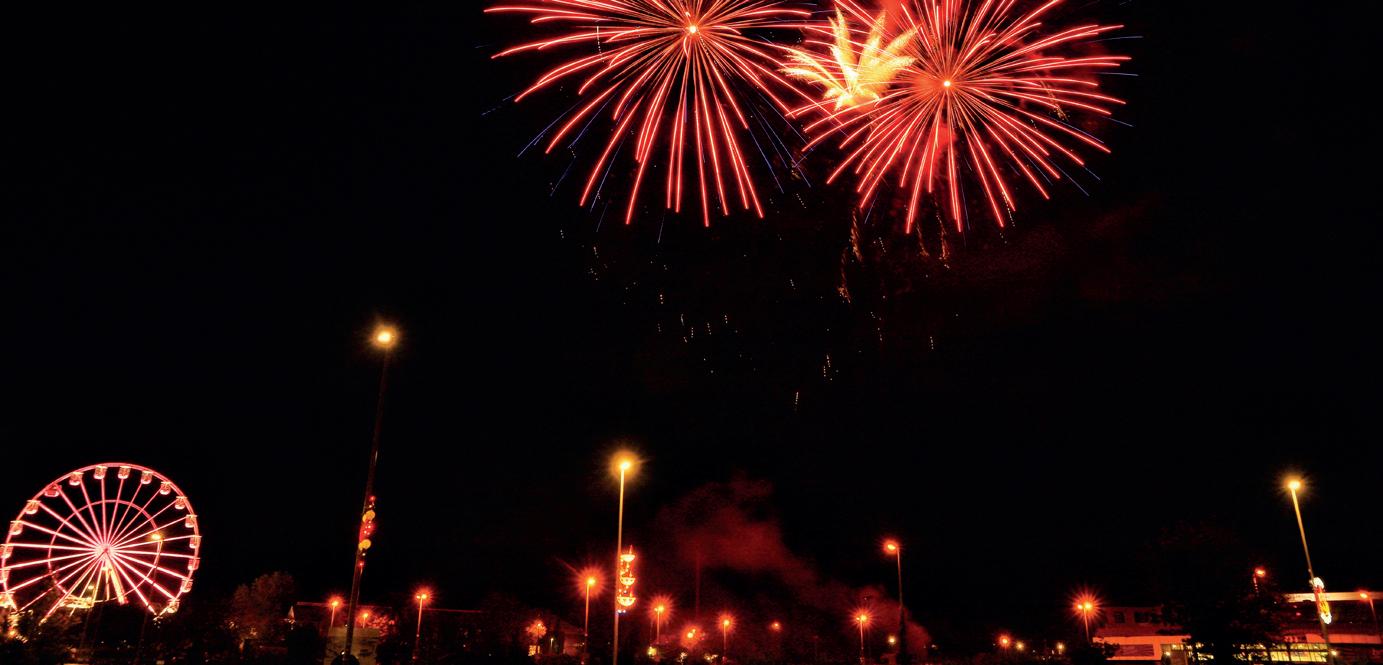
Sean outlined how he is very keen to explore the use of technology on a city-wide basis to create city-wide installations that connect people and places across the pubic realm. As he explained, in his artwork, he is inspired by systems’ theory, the nature of interactivity and creative explorations of flow, connectedness and communication.
LIGHTING AND URBAN SPACE
Finally, for my own presentation, I discussed the role of lighting in placemaking and creating what I termed as a ‘legible’ public realm at night.
In particular, my discussion brought together a number of themes from the other presentations to demonstrate how lighting can be better integrated with urban design. In essence, how using elements of architectural or landscape feature lighting, street and area lighting, public art and lighting for wayfinding can deliver public spaces that are more comfortable and easier to understand.
How, too, lighting can be used to make spaces more navigable, using visual cues to
orientate and create destinations that promote footfall and permeability.
My presentation highlighted the importance of vertical illuminance on building façades or other structures, either through controlled light spill or with designed architectural lighting; how this, again, helps legibility and how, without it, the sense of a space can be dissipated.
To my mind, an urban space is often defined by the buildings that surround it and, if this is lost, the character and identity at night can be lost. Lighting can benefit the night-time economy and can bring social benefits, so potentially reducing anti-social

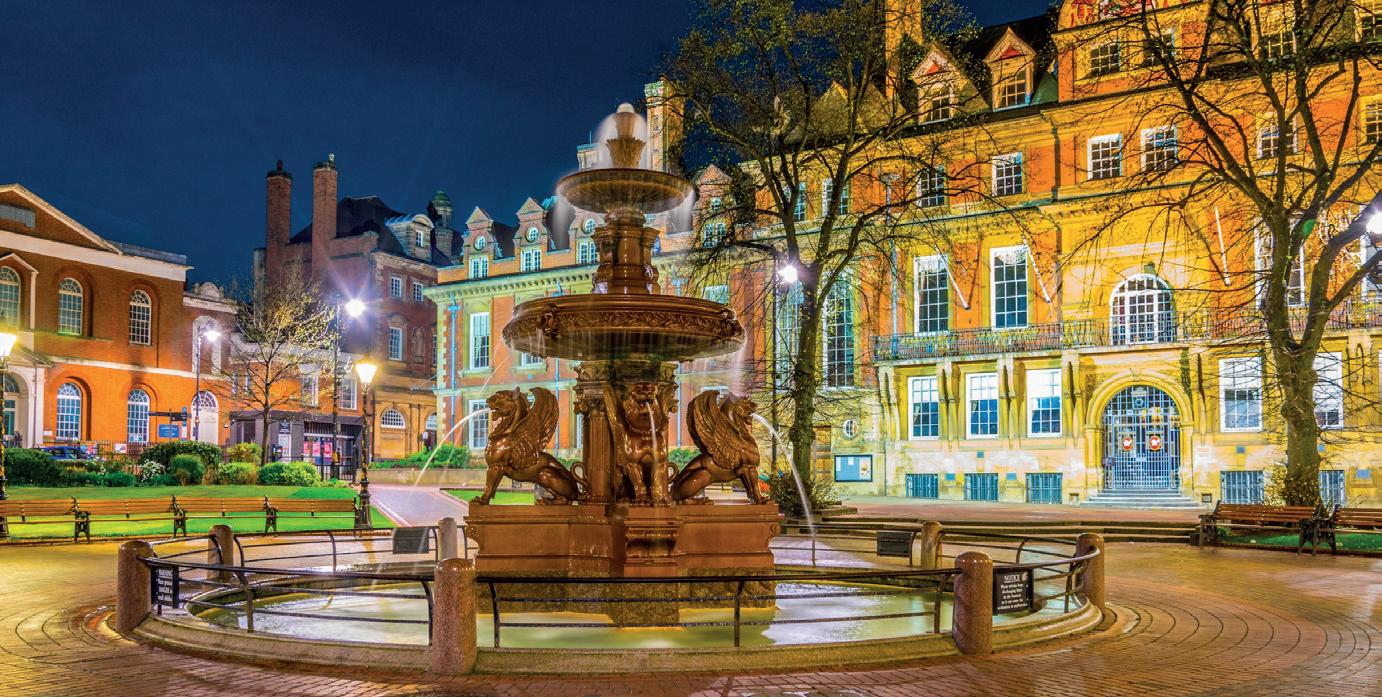
behaviour and promoting sustainability through community living.
I believe there is clear potential to develop design integration further through the use of lighting controls and smart city technologies. We need to be developing better strategies for urban lighting and using lighting masterplanning to draw together all of the threads discussed by all three speakers to create, ultimately, a much more cohesive approach to the design of public spaces at night.
The evening was then rounded off by a discussion with the audience that demonstrated the need to dig deeper into the interesting topics and differing perspectives raised. I certainly look forward to exploring these questions further as the collaboration between ILP and the Leicester Urban Observatory develops over the coming months.
But let me leave the final word to Robert Harland. The event, he argued, was a first for the Leicester Urban Observatory. ‘Conceiving the idea and making it happen with the ILP set in place not only the opportunity to hear from highly specialised lighting professionals and practitioners, spanning planning, design, and arts, but the event also provided a template for future events of this kind,’ he said.
‘These may involve other professionals who contribute to the way people and places interface. The academic underpinning of Stephen Carr’s CitySignsandLights policy study from Boston in the early 1970s underpinned the talks, and emphasised importance of lighting as a communication tool in cities,’ Robert added [1]
[1]
‘City Signs and Lights’, Stephen Carr, 1973, https://www.goodreads.com/book/ show/81760.City_Signs_and_Lights
Graham Festenstein CEng FILP FSLL runs Graham Festenstein Lighting Design and is the ILP’s Vice President – Architectural
JULY/ AUGUST 2023 LIGHTING JOURNAL www.theilp.org.uk 26
Leicester at night and (below) during Diwali

DECLARATION OF INTENT
LUCI, Lighting Urban Community International, marked May’s International Day of Light by publishing an ambitious ‘LUCI Declaration’ outlining how municipalities and lighting professionals may need to rethink their approaches to urban lighting over the next decade
 By Nic Paton
By Nic Paton
JULY/ AUGUST 2023 LIGHTING JOURNAL 28
This year’s UNESCO International Day of Light took place on 16 May and, as every year, saw events taking place around the world to highlight and celebrate the role light plays in science, culture and art, education, and sustainable development.
LUCI, Lighting Urban Community International, the international network of 70 cities that shares best practice and innovation on urban lighting, marked the occasion by publishing its ‘LUCIDeclaration’
This is a series of recommendations for how we might adapt – in fact may need to adapt – urban lighting strategies to climate change; to new patterns of work, leisure and mobility; to evolving technologies; and to respond to the growing pressures on the planet’s biodiversity over the next three, five to 10 years.

With the ILP being one of LUCI’s 40 partner members, it therefore seemed a good opportunity to look at how the organisation is suggesting lighting professionals may need to be responding to these challenges in the coming years. After all, as LUCI president and deputy chair of the City Board of Jyväskylä, has put it in the declaration: ‘We have an unprecedented opportunity to better light our cities together.’
SEVEN FUTURE GOALS
The declaration, first, sets out seven highly aspirational goals for the future of urban lighting. These are:
1. Embracing net zero lighting. This is making that point that, if we genuinely want to hit net zero – and soon – replacement to LED alone is not enough and a too narrow scope for the future of urban lighting.
Urban lighting of the coming decades, LUCI argues, will need to be about
Urban lighting
applying design and planning approaches that enable us to achieve more with less light. This will need to include developing sustainable lighting masterplans, preventing excessive private outdoor lighting, and using dimming strategies, such as dimming in response to traffic.
Equally, it may mean embracing offgrid solar lighting and the removal of light in particular time periods and areas, where socially acceptable. Circularity, too, will need to become a prerequisite within tenders.
2. Minimising light pollution for all living beings. Light pollution, the declaration recognises, is a growing issue worldwide and is affecting all light-sensitive species, people and animals alike.
Here, the solutions are likely to be more reduction in the number of sources, in on-time, in intensity and in tuning the spectrum. Limiting the use of ‘cold’ white LED light will become increasingly important. ‘Where traffic volumes are not predictable, adaptive dimming technology should be applied to provide light only when and where needed,’ it recommends. Dimming can (and probably should) become more widespread, especially as people often don’t notice or don’t mind.
‘At master plan level, applying dark infrastructure is commended. A design approach should help us translate these strategies into lighting schemes that work for both people and nature,’ the declaration says.
However, this will, it concedes, require a major change in mindset. ‘We need to reconsider existing lighting policies, to allow more customised lighting
scenarios that respond to our needs with as little light as possible. Finding new norms and standards that offer the right constraints with enough flexibility will help us change in a responsible and acceptable way,’ the declaration recommends.
3. Supporting health and wellbeing. This goal emphasises the role urban lighting has had for centuries as a key enabler of public social life after dark and preserving security. Too often, however, this has led to urban lighting that is harsh and glary, motivated by the assumption that more light equals safer spaces, yet in the process making urban spaces less inviting, accessible and pleasant.
Therefore, LUCI argues that the future of urban lighting needs to be projects and masterplans that find the right balance – a better balance –between safety and security considerations on one side and health and wellbeing on the other.
‘We should be open to ongoing research on the influence of light on our mental wellbeing. Let us closely follow research on the possible influence of light on sleep-wake cycles, and ensure urban lighting has minimal negative effects on our health in this respect,’ the declaration recommends.
‘We need to encourage projects and strategies where urban lighting aims to strengthen the bond between people and the places they share. For maximum benefits, light- and urban planners should collaborate more closely, and bring the night-time experience on equal footing with the day-time experience in the full urban planning process,’ LUCI adds.
www.theilp.org.uk JULY/ AUGUST 2023 LIGHTING JOURNAL 29
Urban lighting
4. Progressing through public dialogue. This goal is about recognising the inherent tension between public and private urban lighting. As the declaration makes clear: ‘We recognise that private lighting can contribute to urban nightscapes in a positive way. However, private, mainly commercial, lighting is also responsible for an important share of light pollution, for example from uncontrolled overly bright LED screen advertising.’
One solution, as LUCI points out, is having and using clear public design guidelines, or ordinances with maximum light levels. But an important ethical question then emerges: who has the right to light the city nightscape?
This, the declaration argues, is where cities should give precedence ‘to light expressions that are sustainable and relevant to the community’. It will also mean dialogue with communities, user engagement and co-design, and the need for commercial conversations to ensure cities get the best hardware, software, and services. ‘Cities are in the driver’s seat and we should become more explicit in asking the tools and information we require in our tenders,’ LUCI recommends.
5. Realising the full potential of community engagement. Taking goal four a step further, this is about emphasising the value of citizen participation and engagement. As the declaration makes clear: ‘Community engagement is an essential part of placemaking. Such involvement goes beyond our residents: it includes professionals active in public space as well.’
Community-led approaches, LUCI argues, will increasing need to be part of
LED replacement programmes (especially ones that change the lighting colour); the competing uses around public space for sleep, work and play; or the gathering of data by smart lighting systems.
6. Harnessing the transformative power of light art. This goal is about emphasising the increasingly important role that light festivals have within public spaces these days, especially during the darker winter months. ‘They delight us and bring us together literally and figuratively. Light art can mean even more for the city,’ the declaration outlines.
‘Light art festivals as well as permanent light art installations can serve as test-beds for new urban concepts and allow local communities to experience new dimensions of urban space. We are only at the beginning of exploring these modes of expression,’ it adds.

7. Creating synergies beyond lighting. This final goal articulates the need, especially in the future, to make urban lighting about much, much
more than just the lighting. As has already been highlighted, successful urban lighting strategies are about meeting net zero targets, reinforcing community cohesion and engagement, boosting the night economy, supporting innovation and so on
As the LUCI Declaration argues: ‘Lighting can and should be a key enabler of city-wide night-time strategies, and more. Given these diverse benefits, we should strive to connect lighting much more to other urban policies.
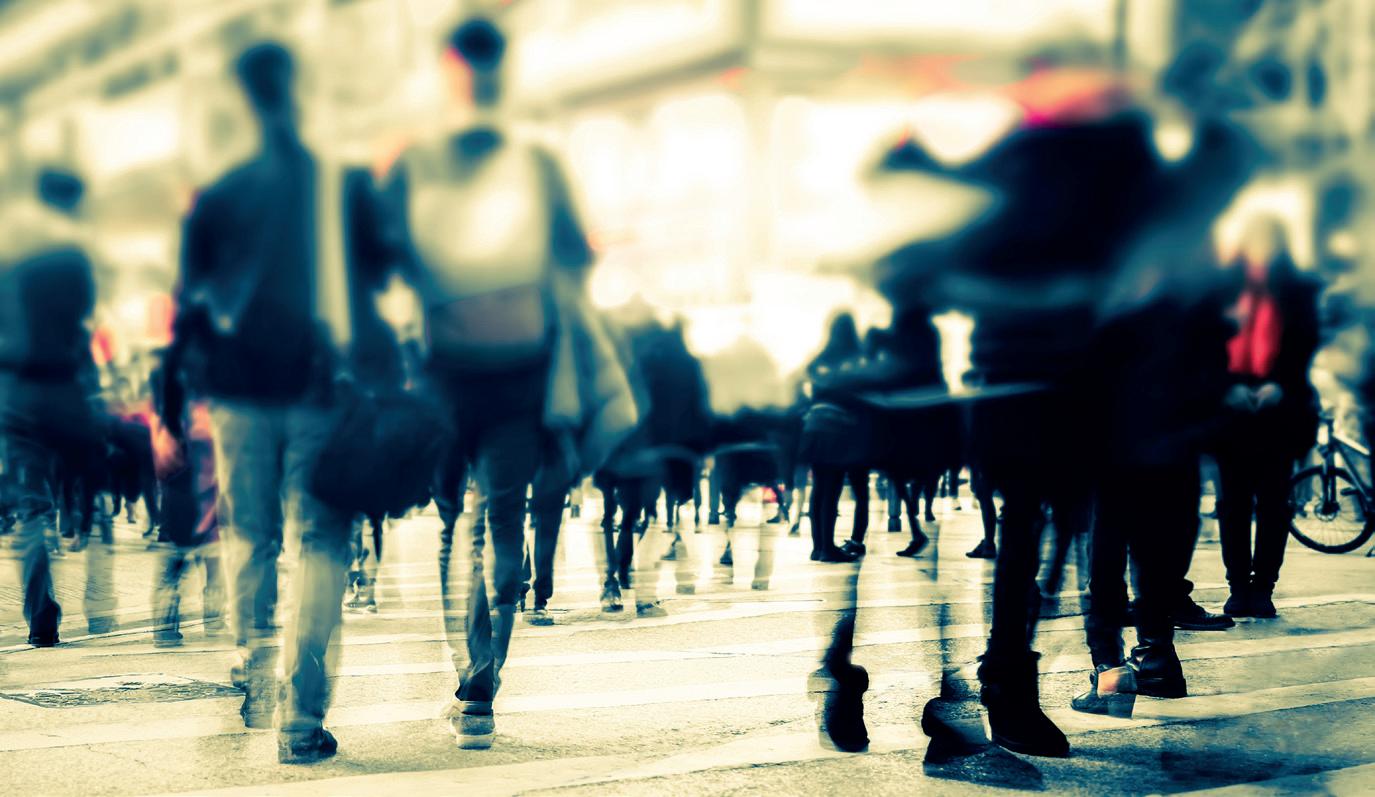
‘Done in the right way, new synergies can be found, also in terms of funding. The scope of urban lighting is becoming broader and broader. Disciplines involved in sustainable urban design, such as social sciences, information and communication technologies, urban planning, ecology and lighting professionals need to team up and collaborate more intensively,’ it adds.
This aspirational talk is all well and good, and eminently laudable, of course. But what this vision of the future for urban lighting actually look like in practice, on the ground? This is precisely what the second part of the declaration attempts to articulate, outlining a series of themed chapters on reducing light pollution, creating healthier and happier cities after dark, transitioning towards a community-driven approach, and outlining the possible future of light festivals.
There isn’t space here to look at all these in their totality, but let’s try to tease out a few of the key insights.
URBAN LIGHT POLLUTION
On light pollution, first, the declaration outlines how municipalities, lighting designers, engineers, planners and architects will all need to work on reducing the quantity of light sources, reducing on-time, focusing light to where it is needed, reducing brightness, and tuning the spectrum.
JULY/ AUGUST 2023 LIGHTING JOURNAL www.theilp.org.uk 30
These pages and main image previous page: light festivals in Amsterdam and (opposite) Nabano no Sata in Japan
It will require better selection of luminaires, ideally ones with a properly tailored light distribution to avoid spill light and waste of luminous flux. This will likely require work around optics, lenses, and suitable accessories, such as proper shielding. There will need to be a greater emphasis on designing for glare-free environments and environments with a generally lower level of light.
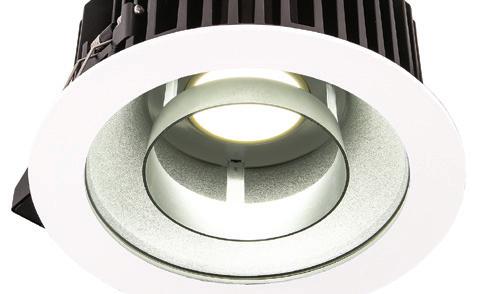
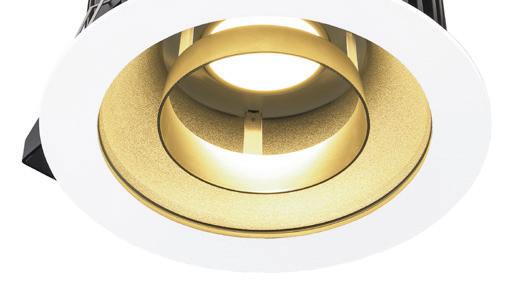
Within this, there will gradually be a greater need for more planning for dark infrastructure in the city, in other connected areas without light barriers, more integration of adaptive street lighting technologies, more (and more connected) trials and pilots, and the formulation of city-wide design guidelines to prevent light pollution.
HEALTH AND HAPPINESS
On creating happier and more healthy cities after dark, the declaration advocates for municipalities and lighting professionals to be closely following research about the extent of urban lighting’s impact on people’s sleep-wake cycles. This needs to include lighting from advertisements, indoor private lighting, and the increased exposure to
screens, as well as public lighting. As the declaration states: ‘It is the sum of all exposure that counts.’
Preventing light trespass into people’s homes is likely to become a more important urban lighting topic, LUCI predicts. ‘We have heard citizens ask for the “right for darkness” during night walks, and this signal should be taken seriously,’ it recommends. ‘We, as cities, have a role to play when it comes to raising awareness about the impact of lighting on health, for example through prevention programmes and public engagement. Co-design with citizens is a fruitful way to incorporate their needs and wishes for darkness in projects.’
CONNECTED COMMUNITIES
The third themed chapter, on transitioning towards a community-driven approach, emphasises the importance of seeing lighting as a social medium. ‘Good urban lighting helps provide a sense of place, by highlighting meaningful elements, creating atmosphere, and supporting activities,’ LUCI argues.
Yet, urban lighting is also in transition. ‘The great challenges facing cities in terms of carbon neutrality, reduction of ecological impact, and rising energy costs urge us to reconsider how we should light public space,’ the declaration outlines.
‘Social and economic trends in the city, such as changing work and leisure patterns, and demographic trends change the use of, and demands on, public space. At the same time, the tools for lighting are evolving. How can we give shape to urban lighting of the future in such a way that both the environment and local communities benefit?’ it asks.
One way is through greater, and genuine, community involvement. As LUCI argues: ‘We strongly advocate for involving the local community in the necessary changes in urban lighting. By local community we mean citizens and private actors including, for
Urban lighting
example, retailers, local associations, but also the professional stakeholders on the streets including law enforcement officers and social workers and others.’
Within this, night walks, ‘guerrilla lighting’ and temporary test set-ups for community evaluations can all be beneficial, as can be light festivals (on which more shortly). Virtual reality, too, is increasingly emerging as a valuable tool to show and discuss future lighting scenarios with residents and communities.
Engagement techniques such as the ‘Place Standard Tool’, forming citizen light committees, or even the innovative use of mobile apps can also be helpful in this context. ‘Moving forward with a community-driven approach requires us to reach beyond our discipline. The input of other professionals, such as social workers, urban planners, and process facilitators greatly increases the chances for success of a community engagement project that nurtures 24-hour liveable places,’ says LUCI.
NEXT-LEVEL LIGHTING FESTIVALS
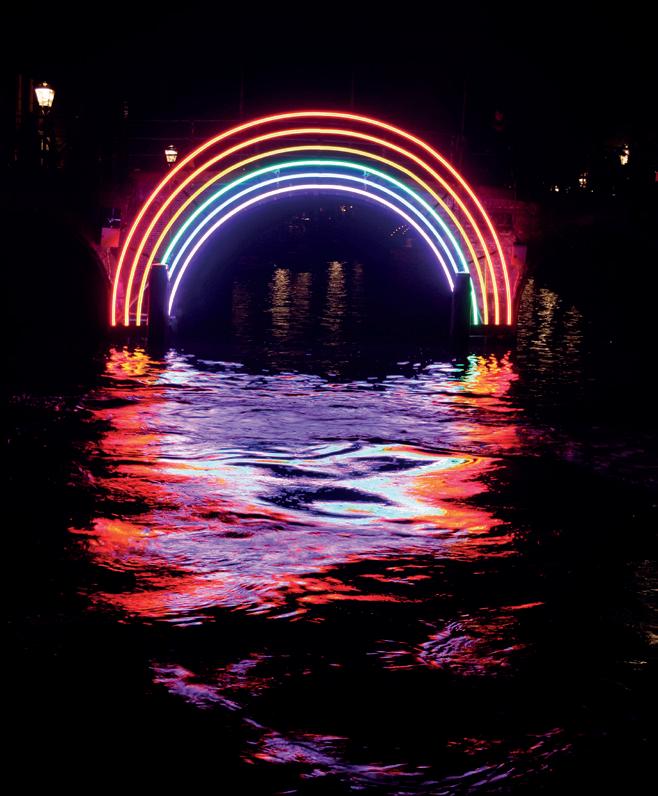

The final chapter addresses the future of light festivals. As we’ve already highlighted, light festivals have an important role in engaging communities in the role and potential of light, as well as showcasing what new technologies, techniques and creative approaches can do.
However, as the declaration explains, they need to be seen beyond their role as either temporary or permanent events or installations. ‘The catalysing power of light festivals reaches beyond light art. The focused presentation of lighting in the urban context can educate people about its value for public life and increase acceptance of new forms of urban lighting.
‘This can feed back into the city urban lighting policy. The ongoing advance of smart lighting is confronting cities with fundamental questions about future urban lighting, and light festivals can provide valuable input there. Light festivals can offer a testing ground, a temporary lab, for academic or other research, like social experiments, via the medium of light,’ it adds.
FIND OUT MORE
The LUIC Declaration for the Future of Urban Lighting can be found in its entirety at https://www.luciassociation.org/about-luci/ luci-declaration-for-the-future-of-urban-lighting/ www.theilp.org.uk
JULY/ AUGUST 2023 LIGHTING JOURNAL 31
ILLUMINATING INTERIORS AMBIANE™ AP anolislighting.com WARMING COLOURS & ADJUSTABLE WHITES
AGILITY AND DIVERSITY ARE KEY TO CU PHOSCO’S CENTENARY CELEBRATION

Celebrating 100 Years

In the fast-paced world of the lighting industry, where companies come and go, CU Phosco Lighting has managed to carve a niche, a testament to its resilience and adaptability. As their centennial year of 2023 unfolds, this family-owned business has firmly established itself by embracing diversification and innovation. Building upon the insights shared in last month’s article detailing the history of its relationship with the ILP, we invite you to take a deeper delve into its rich legacy, a remarkable journey of growth, and vision for the future.
THERE AREN’T MANY UK FAMILY-OWNED LIGHTING COMPANIES LEFT. WHAT’S SPECIAL ABOUT BEING A FAMILY BUSINESS IN TODAY’S LIGHTING INDUSTRY?
Being a family business in today’s lighting industry is increasingly rare but holds significant value. With a century-long legacy, CU Phosco Lighting has become a symbol of stability and longevity. Our status as a family business sets us apart from competitors and represents not only a source of pride but also a testament to our ability to adapt and flourish over time. Our teams feel part of the family and they work together as one, to support our customers with the best customer experience possible.
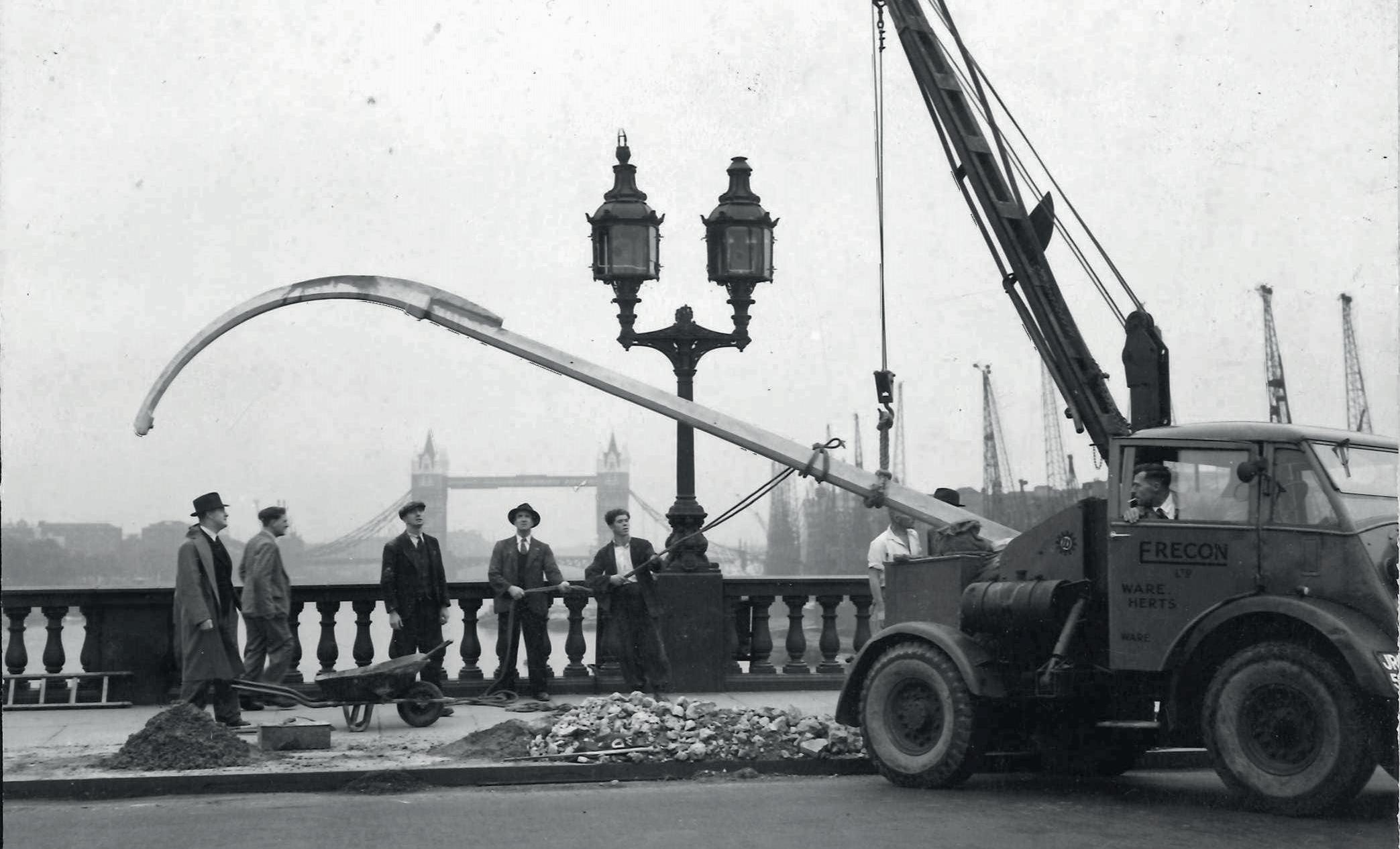 An interview with Matt Murray, Sales & Marketing Director of CU Phosco Lighting
An interview with Matt Murray, Sales & Marketing Director of CU Phosco Lighting
JULY/ AUGUST 2023 LIGHTING JOURNAL 32
WHAT DO YOU BELIEVE IS THE KEY TO SURVIVING 100 YEARS IN THE LIGHTING INDUSTRY?
Diversification has been the cornerstone of our success. Over the years, we’ve expanded beyond our initial focus on concrete lighting columns. During the war, we pivoted to make railway sleepers and air raid shelters before venturing into other concrete products such as bridges, pontoons, and prefabricated garages in the 50s and 60s. The 70s and 80s saw the company move to steel structures as well as developing its own range of luminaires and flood lights.
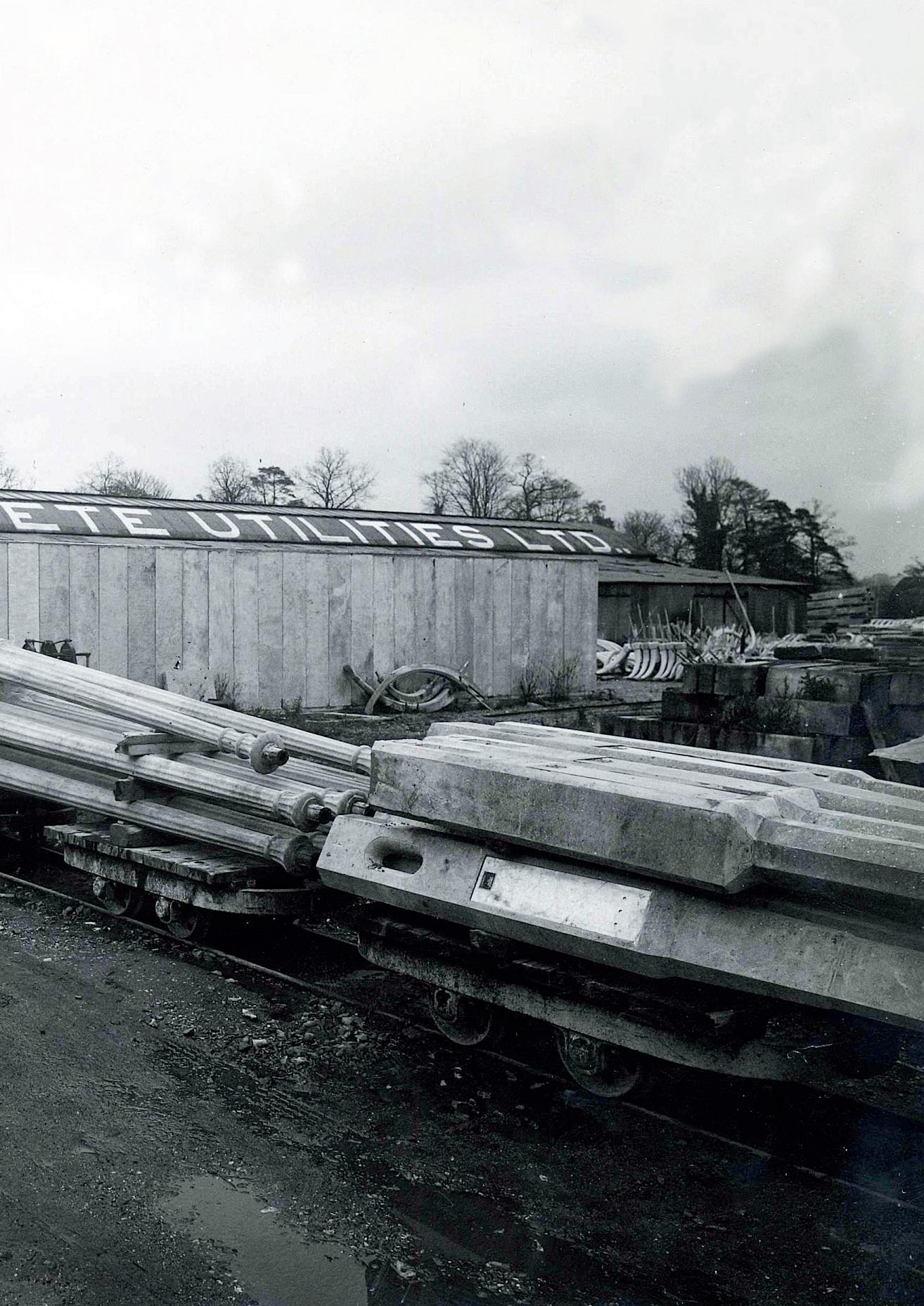
The expertise of structural design and manufacture lead the company to develop into areas such as wind turbine masts and telecoms masts in the 2000s. In the last 10 years, we have joined the LED revolution of street lighting products and have become one of the UKs leading manufacturers of LED exterior lighting products.
Our diverse capabilities position us as an innovation and product development leader. This diversification has been a crucial factor in our sustainability as a company, ensuring we have continued in business for as long as we have done.
Although UK born and based, our business isn’t just in the UK. In the 1960s, we expanded globally with our export sales and High Mast Installations Services. We even received the Queen’s Award for Export in the late 1970s. Today, this arm of the company continues to expand. It has an extensive list of major projects worldwide, including in Dubai, Australia, Hong Kong, and Western Europe, to name a few. Our self-preservation mindset and forward-looking approach have allowed us to identify emerging markets and adapt accordingly.
For example, the opening of our new entity in Australia earlier this year, separate from our holding operations, is the latest investment to support a broader business strategy to bring us closer to our customers internationally. Agility and foresight have been pivotal in our continued success.
Today, we operate internationally, offering a partnership approach, from design, specification and manufacture to installation and service of our luminaires, high masts, and columns range.
FROM INCANDESCENT TO LED AND GREEN ENERGY SOURCES, CU PHOSCO LIGHTING HAS SEEN A LOT OF CHANGE DURING ITS EXISTENCE. WHAT DOES THE FUTURE OF THE LIGHTING INDUSTRY AND CU PHOSCO LIGHTING LOOK LIKE?
The industry has seen many changes over the years, and the future, I believe, will bring greater focus on circularity and green energy sources based on the current buzz in the market. The protection of both our planet and our budgets will remain high on priority lists for a long time to come.
We have always endorsed customer feedback in product
development and excel at meeting these challenges. Our range of LED products, including Heritage, road, and floodlighting, are designed in collaboration with our customers and expert teams to the highest standards. The outcome has been to deliver a range of high-quality, cost-effective, energy-efficient, British-made exterior lighting products. This, coupled with our award-winning P86 range. Through customer focus and feedback, we developed a forward-thinking, circular-focused range which is now CIBSE CEAM TM66-accredited with our score of 2.8 for highways luminaires, another example of our vision to support the journey towards net zero.
Going forward, our industry organisations will be even more important in leading the direction of our industry. That’s why we will continue to build on our long-standing relationships from their conception such as the APLE (ILP) and HEMSA/ASLEC (HEA) and will continue to support, not only as members, but with invaluable contributions from many of our employees, in various roles, for the betterment of the industry.
As a family-run business, succession planning is crucial to the next 100 years. We are preparing for the leadership transition from Nicholas Marques to Philip Marques, and eventually to Chris Marques. As family members, they remain guardians of the brand, with the support of multidisciplined teams ensuring continued success.
Looking to the future, it has been of great importance for members of the family to learn all areas of the business before they take to the lead. Chris, for example, has worked in many different disciplines, including commercial and technical roles, including lighting design and product development. He has a deep understanding of our products, teams, and customers, which will be invaluable when he takes the helm.
AS A 100-YEAR-OLD LIGHTING MANUFACTURER, YOU’VE WEATHERED MANY STORMS. WHAT DO YOU THINK THE BIGGEST CHALLENGE FOR THE STREET LIGHTING INDUSTRY IS NOW?
The lighting and electrical industry needs to invest in a succession plan, now more so than ever. There is a severe skills shortage, and the industry needs to appeal to the younger generations. We have been collaborating with industry bodies like the Highway Electrical Association (HEA) and the Institution of Lighting Professionals (ILP) to shape our future. By working with these organisations, we aim to raise awareness about the lighting industry to a younger audience and make it a more attractive career pathway.
We also recognise the importance of modern-day apprenticeships, and we utilise them to cultivate the next generation of talent, ensuring the industry’s longevity, growth, and professionalism.
We currently have five apprentices in separate areas of the business, with more to follow, covering both commercial and operations roles. We support our apprentices with career and skills development planning, which in term, benefits our organisation by developing the next generation of talent for both us and the industry.
I am proud to be part of a British family-run business that has weathered various challenges throughout its history, including a world war, the recessions of the 70s and 80s, the financial crisis, and more recently, the Covid Pandemic and Ukraine-Russia conflict. All of these challenges have impacted the industry, but our ability to rise to the challenge has ensured that we are still a successful business today, as well as protecting our future.
FIND OUT MORE
If you’d like to learn more about CU Phosco Lighting’s history, check out their recent 100 facts about CU Phosco Lighting blog by scanning the QR code www.theilp.org.uk
WITH A CENTURYLONG LEGACY, CU PHOSCO LIGHTING HAS BECOME A SYMBOL OF STABILITY AND LONGEVITY
JULY/ AUGUST 2023 LIGHTING JOURNAL 33
Advertorial
WHAT ARE YOU LOOKING AT?
A research project is testing the assumption that, when researching lighting for interpersonal evaluations on subsidiary roads, we should focus on the face
By Khalid Hamoodh and Professor Steve Fotios
Some research projects have direct practical application. Others are more fundamental in nature and do not lead to immediate application. The research conducted by Khalid Hamoodh, a PhD student at the University of Sheffield, falls into that latter category –his work was an investigation about the design of experiments that might in turn have a message for direct application [1]
This work concerns road lighting in subsidiary roads, where the needs of pedestrians are a primary focus of lighting design.
To investigate the impact on pedestrians of a change in lighting, such as an increase or decrease in light level, we consider the effect of this change on individual tasks. One such task is interpersonal evaluations, or our judgements of the intent and/ or identity of the people we can see.
Consider that you are walking alone, after dark. If you see another person ahead, you will need to decide whether to keep walking towards them or instead to take avoiding action. Figure 1 is an example of this situation and illustrates how road lighting can affect our ability to discern features of the approaching person.
For lighting research, we need to know the critical visual cue for this evaluation. Different cues are likely to present different sizes and contrasts and thus affect the conclusions we draw about what happens when the light level (or another
parameter) is changed. Does an increase in light level allow us to see the approaching person better? Or does it not make much difference?
UNDERSTANDING VISUAL CUES
Potential visual cues for interpersonal evaluations include the face, hands (perhaps whether visible or not, or if holding something), gaze direction, gender, clothing, body posture, walking direction and gait of the person we are looking towards.
Previous studies have assumed it is the face that matters. Some have conducted experiments to determine if changes in illuminance or lamp spectrum affect a facial identification task.

This assumption is perhaps unsurprising, given that lighting recommendations make specific reference to facial recognition [for example references 2,3,4]. Others have instead investigated the ability to discriminate facial expression, a judgement of intent rather than identity, but this again assumes the face to be the critical cue.
The focus of Khalid’s PhD research was therefore to determine whether the face is indeed the important visual cue. This was done through two experiments, one using subjective evaluations and one using objective evaluation.
In the first experiment, test participants were asked to evaluate (using a category
JULY/ AUGUST 2023 LIGHTING JOURNAL 34
Lighting and perception
rating scale) perceived safety when observing a series of images. These images presented pedestrians in different poses. It was assumed that the change in pose leading to the greatest reduction in perceived safety would be the most critical visual cue.
In the first stage these were variations in the gender, walking direction (towards or away from the observer), group size
(alone or in pairs) of the approaching person and whether they were front-lit or back-lit.
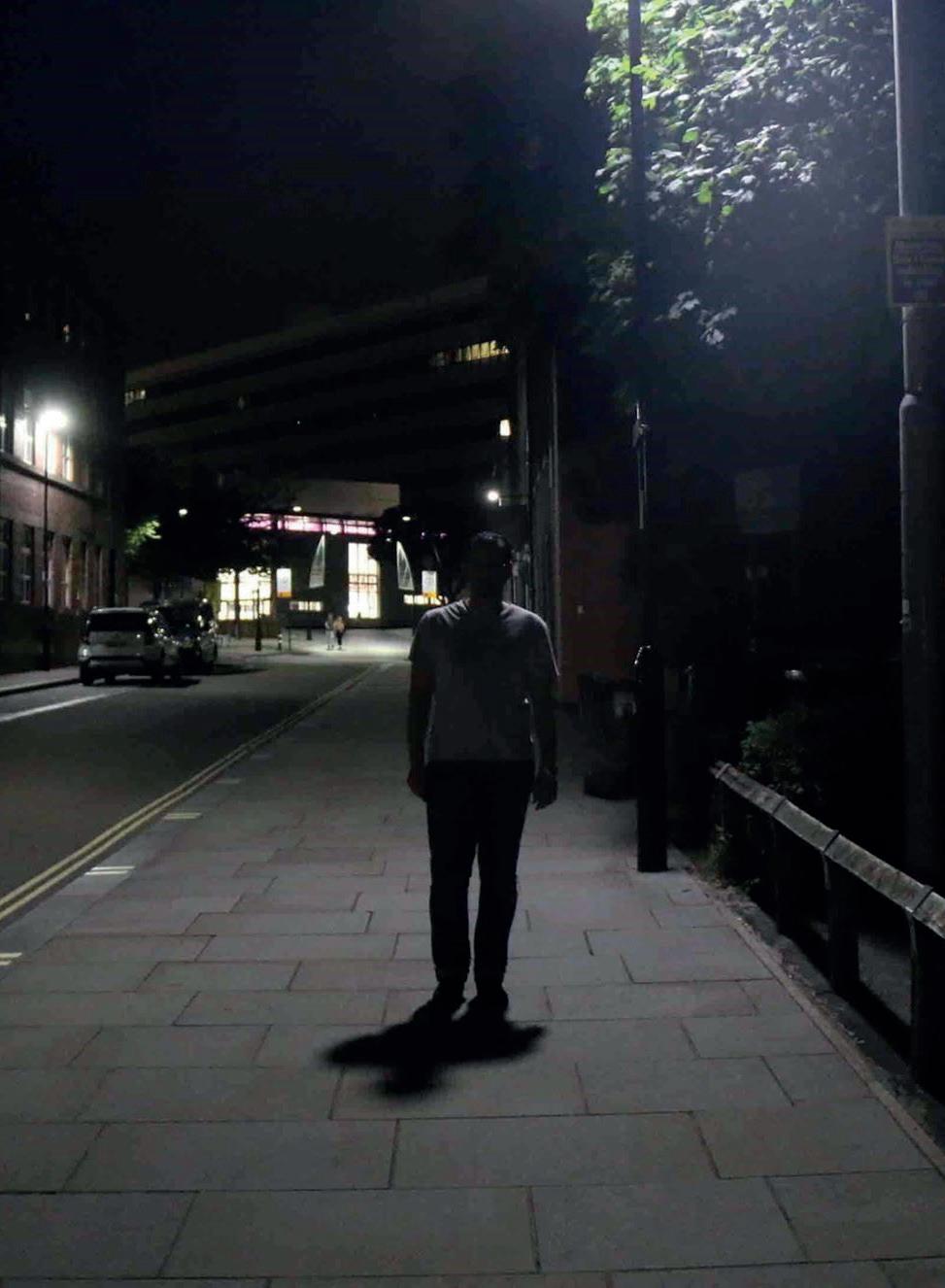


These variations were developed from the cues suggested by a female lighting design colleague. The results indicated that the face and hands was the greatest determinant of perceived safety, but the experiment did not enable the contribution of each to be distinguished [5]
The second stage therefore focused only on the hands and face, with these features either exposed, or partially or fully hidden. For the face this was achieved using a scarf and/or a hat and sunglasses; for the hands this was done with the hands either visible, behind the back or in pockets (see figure 2). The results suggested the face to be a more important cue than the hands [6]
When considering any research findings, an important question is the degree to which the results are credible. We sought evaluations of repeated images to determine if participants gave similar responses: this tests order effects.
In the second stage we also used a second experimental procedure (paired comparisons) to evaluate the same set of images, and in this work we reached the same conclusions.
Nevertheless, it is still possible to question the validity of those results.
For example, did test participants respond with a low level of perceived safety when observing a concealed face because that is the response they thought the experimenter might want to hear?
EYE-TRACKING EXPERIMENT
The second experiment therefore used an entirely different
(a) (b)
www.theilp.org.uk JULY/ AUGUST 2023 LIGHTING JOURNAL 35
Figure 1. Illustrations of an approaching pedestrian after dark. Image (a), front-lit: many details are visible. Image (b), back-lit: most details are not visible
Lighting and perception
approach, eye tracking, repeating an experiment previously reported by Fletcher-Watson et al [7]. The test images were a set of images of pedestrians embedded into a range of background scenes, presented individually for three seconds (figure 3).

It was assumed that the more important visual cue would be that upon which the test participant tended to look first, and for the longest duration. Steps taken to check the validity of these results included varying the position of the person in the scene (left, centre, and right), variations in the target person (gender and age), and inclusion of distracting objects such as dogs, other people and vehicles.
The results of this experiment suggested the face to be a more important cue than the body, the background, or other objects in the scene [1]
The results from these experiments led to the same conclusion: that the face is the more important visual cue when evaluating other pedestrians.

On one hand, that might be considered as a trivial conclusion because it was the assumption already widely held. On the other hand, one aim of research is to test assumptions. After all, they may be wrong.
IMPLICATIONS FOR LIGHTING DESIGN
So, what does this mean for lighting design? First, it supports the relevance of research using the face as a target in interpersonal evaluations.
Having reached that conclusion, the next question is what evaluation should be made? Early research focused on facial identity recognition (for example name the celebrities shown in a series of images). But that approach is limited because familiar faces are recognisable even when the image is of a low quality, or when the lighting is poor [8]. Later work has instead focused on recognition of facial expression (for example happy, sad, or angry), a cue to intent, because the influence of familiarity is largely removed [9].
Rather than asking test participants to make judgements of facial identity or facial expression, an alternative approach is to predict the effect of a change in light level using a model of visual performance.
This was done in a follow-up study using the model known as ‘Relative Visual Performance’ (RVP) [10] . This model
accounts for the age of the observer, the adaptation luminance, and the size and contrast of the target.


With this model we were able to examine two factors largely absent in existing experimental work: we included elderly observers (aged 65 years) and target faces of different skin tones.
The results are astounding. Compared with existing studies, which tend to use
young observers evaluating Asian or Caucasian faces, this work revealed severely impaired visual performance when the observer is elderly or the observed person has a dark skin tone.
Interpersonal Evaluations: Is the Face the Critical Cue?’, PhD thesis, University of Sheffield, 2022 [2] British Standards Institution. BS 5489-1:2020. Design of road lighting Part 1: Lighting of roads and public amenity areas – Code of practice. London: BSI, 2020, [3] British Standards Institution. BS EN 13201-2:2015. Road lighting Part 2: Performance requirements. London: BSI, 2016, https://landingpage.bsigroup.com/LandingPage/Undated?UPI=000000000019976358 [4] Commission Internationale de l’Éclairage. ‘Lighting of Roads for Motor and Pedestrian Traffic’, CIE 115:2010. Vienna: CIE, 2010, http://cie.co.at/publications/lighting-roads-motor-and-pedestrian-traffic-2nd-edition [5] Fotios S, Hamoodh K, Clanton N. ‘What are you looking at? Testing Nancy’s rules for pedestrian interactions’. Proceedings of the 29th CIE Session in Washington DC USA 2019 Jun; 1669-1674, available at: https://eprints.whiterose.ac.uk/147921/ [6] Hamoodh K, Fotios S, Cheal C. ‘Visual cues to interpersonal evaluations for pedestrians’, Lighting Research and Technology. First posted online 15 November 2022, as https:// doi.org/10.1177/14771535221093470 [7] Fletcher-Watson S, Findlay J, Leekam S, and Benson (2008). ‘ Rapid detection of person information in a naturalistic scene. Perception ; 37: 571-583, https://pubmed.ncbi.nlm.nih.gov/18546664/ [8] Burton A, Wilson S, Cowan M, and Bruce (1999). ‘Face recognition in poor-quality video: Evidence from security surveillance’. Psychological Science ; 10(3): 243-248, https://journals.sagepub.com/doi/10.1111/1467-9280.00144 [9] Fotios S, Johansson M (2019). ‘Appraising the intention of other people: Ecological validity and procedures for investigating effects of lighting for pedestrians’. Lighting Research and Technology ; 51(1): 111-130, https://journals.sagepub.com/doi/10.1177/1477153517737345 [10] Fotios S, Mao Y, Hamoodh K, Cheal C. ‘Using relative visual performance to predict performance of an interpersonal evaluation task with variation in adaptation luminance, observer age, skin tone, pavement reflection and interpersonal distance’. Lighting Research and Technology first posted online 04 August 2022, as doi.org/10.1177/14771535211069027.
 [1] Hamoodh K. ‘Lighting for Pedestrians’
Figure 2. Test images show how the covers are applied to the face and hands. Image (a): face and hands are visible. Image (b): face and hands are not visible – face covered with a scarf, hat, and sunglasses; hands covered by placing them behind the back
Figure 3. Example of a test image observed by a participant while wearing eye-tracking glasses. The white dashed circle (here shown inside the bold red circle) shows a fixation point – or the point towards which they were looking. Here the participant was looking at the body of the person
[1] Hamoodh K. ‘Lighting for Pedestrians’
Figure 2. Test images show how the covers are applied to the face and hands. Image (a): face and hands are visible. Image (b): face and hands are not visible – face covered with a scarf, hat, and sunglasses; hands covered by placing them behind the back
Figure 3. Example of a test image observed by a participant while wearing eye-tracking glasses. The white dashed circle (here shown inside the bold red circle) shows a fixation point – or the point towards which they were looking. Here the participant was looking at the body of the person
(a) (b)
JULY/ AUGUST 2023 LIGHTING JOURNAL www.theilp.org.uk 36
Khalid Hamoodh is a PhD student in the School of Architecture at the University of Sheffield. Professor Steve Fotios, is professor of lighting and visual perception at the University of Sheffield
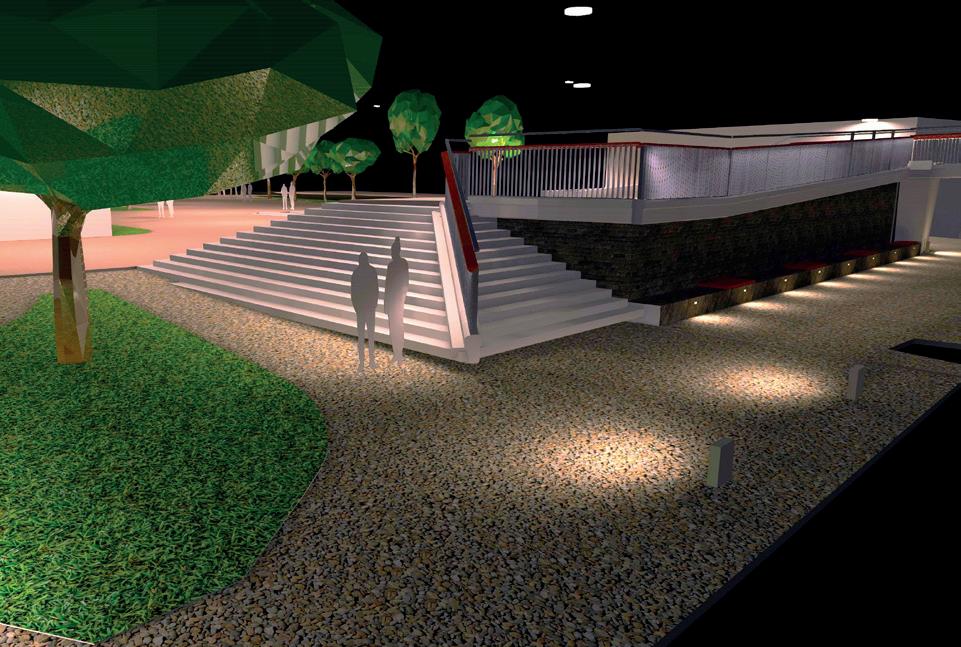
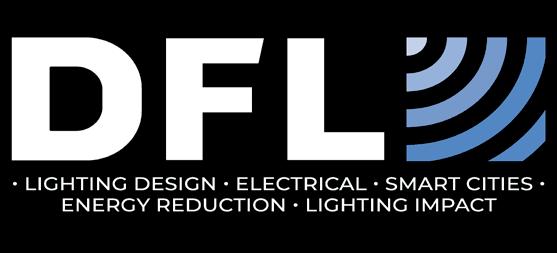



• • • • • T HE P OW ER T O M AK E LIGH T WORK
SIMPLY RED
Millennia of evolution have shaped how we see, perceive and think about red light. Understanding this will allow us all better to integrate and balance red artificial light within the built environment and public realm, a recent ILP ‘How to be brilliant’ concluded
 By Nic Paton
By Nic Paton
Back around the turn of the millennium, with lighting on the cusp of the coming LED revolution, there was much debate about why, from a lighting perspective, London was rapidly turning blue.
As Colin Ball, lighting director at BDP, recalled at a recent ILP ‘How to be brilliant’ event in the capital: ‘It was very much a millennial thing. Through the 1990s and around the 2000s blue was the most expensive colour to achieve. You’d achieve it by pumping extra wattage through 3% transmission glass; so twice as many fittings, double the wattage. I used to have schemes 125W per m2 but that was a normal thing at the time of the millennium. We wanted more light; we wanted to celebrate.’
The event at the end of April, effectively the launch of the ILP’s 2023 ‘How to be brilliant’ programme, was in fact not about blue at all, but the colour red. Entitled ‘Red shift
JULY/ AUGUST 2023 LIGHTING JOURNAL 38
– the growth of red saturated light since 2000’, it was a joint presentation between Colin and Lora Kaleva, associate lighting designer at BDP.
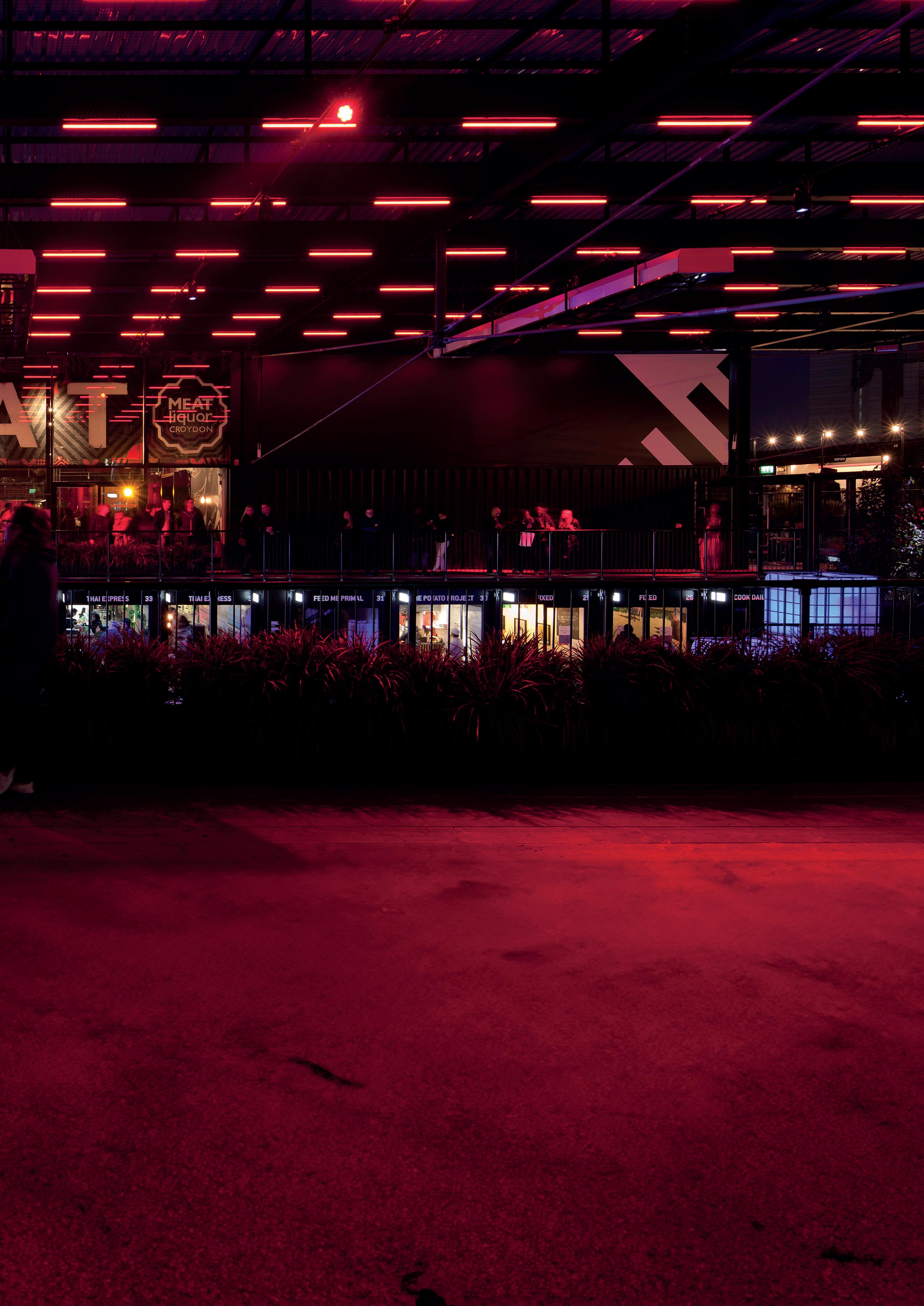
‘How to be brilliant’, as most ILP members will be well aware by now, is the ILP’s programme of free, informal talks, presentations and lectures designed to connect successful, senior lighting designers with students, juniors and new entrants to the profession.
However, as we shall see, Colin and Lora’s presentation was anything but entry level, roaming as it did across art, science, physiology, and philosophy, along with complex questions around the intangibility of perception and the evolution of colour vision itself.
It was also a follow-on to the How to be brilliant lecture Colin and Lora gave back in 2019, albeit delayed by the small matter of a pandemic. This had focused on the colour
blue and blue light (‘Saturated colour: why the blues?’). As Colin put it: ‘We gave that blue talk and then said to everyone, “see you in six months” and of course the world turned upside down. So, it has taken nearly three years for us to come and actually present part two.’
PROPERTIES OF RED (AND BLUE)
However, as Colin made clear, you really can’t talk about red without also talking about blue and, of course, yellow and green.
The blue tiles of the Blue Mosque in Istanbul, for example, are full of red pigment. Equally, the stained glass of the Chappelle St Denis in Paris may be saturated blue but, in fact, has more red within it. ‘Red sits in the material, but blue hangs; it disperses,’ as Colin put it.
‘The conclusion that we came to within our blue paper is that there is a specific property within the eye; our eyes have evolved to
specific wavelengths so they allow blue to hang, to diffuse. But red, we discovered while looking into the research, also has a lot of distinct properties. That’s why we had to come back and talk about red,’ he explained.
Lora Kaleva then delivered a brief overview of how our vision works and, in particular, why we are one of the few animals –along with apes and ‘Old World’ monkeys – to have highly developed colour vision.
Much of this is likely to be familiar to ILP members but she outlined the role of the retina’s fovea, rods and cones in creating scotopic and photopic vision. ‘The visual sensitivity of the two types of vision shifts towards the shorter wavelength end of the spectrum. So when it’s dark visual acuity shifts towards the short wavelengths in the spectrum peaking at 507nm roughly. Visual acuity during the day is about 550nm,’ Lora explained.
‘One thing we found is that the wavelengths specific to blue light are on the edge
www.theilp.org.uk JULY/ AUGUST 2023 LIGHTING JOURNAL 39
The ILP’s ‘How to be brilliant’ events
The ILP’s ‘How to be brilliant’ events
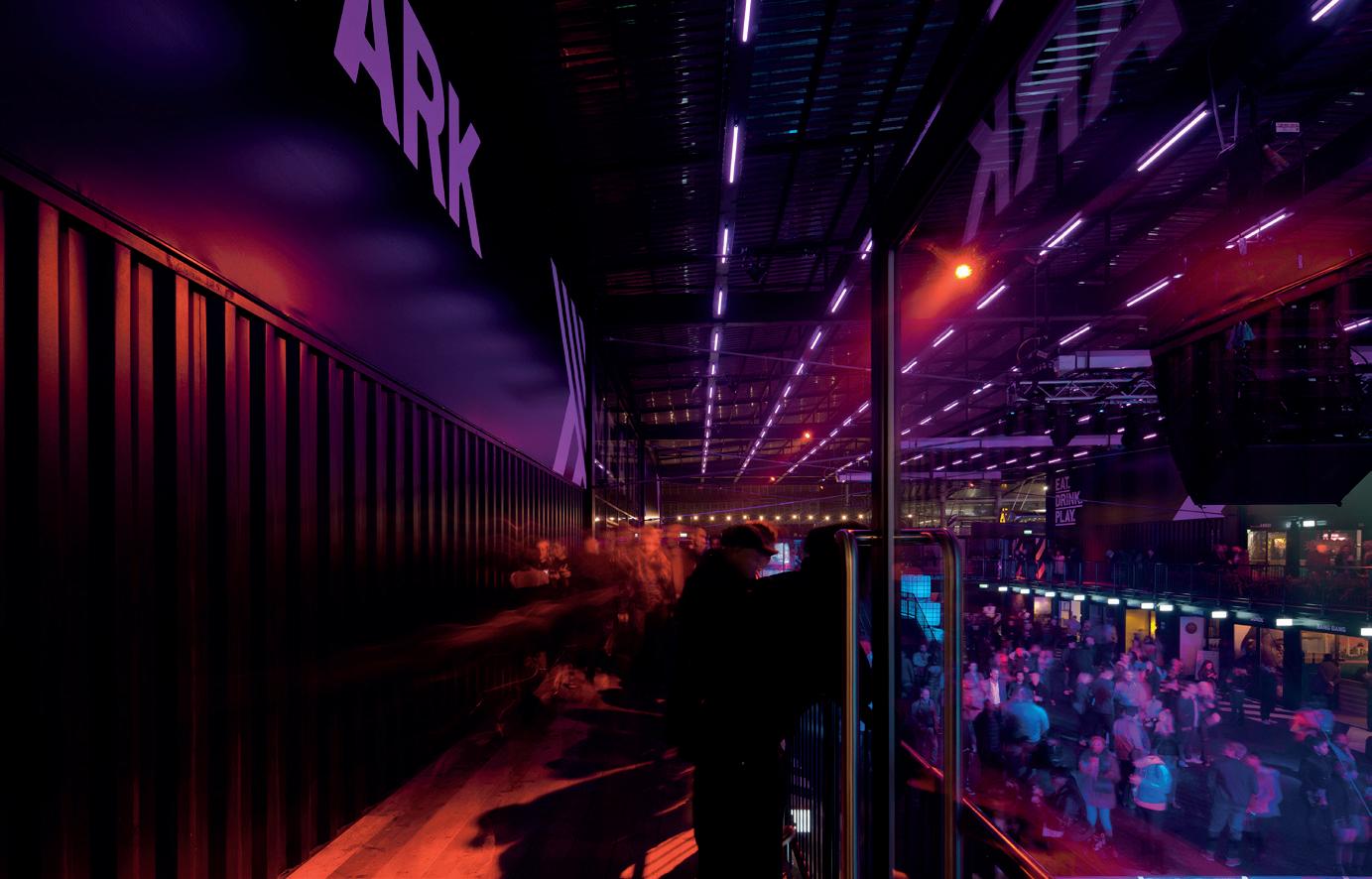
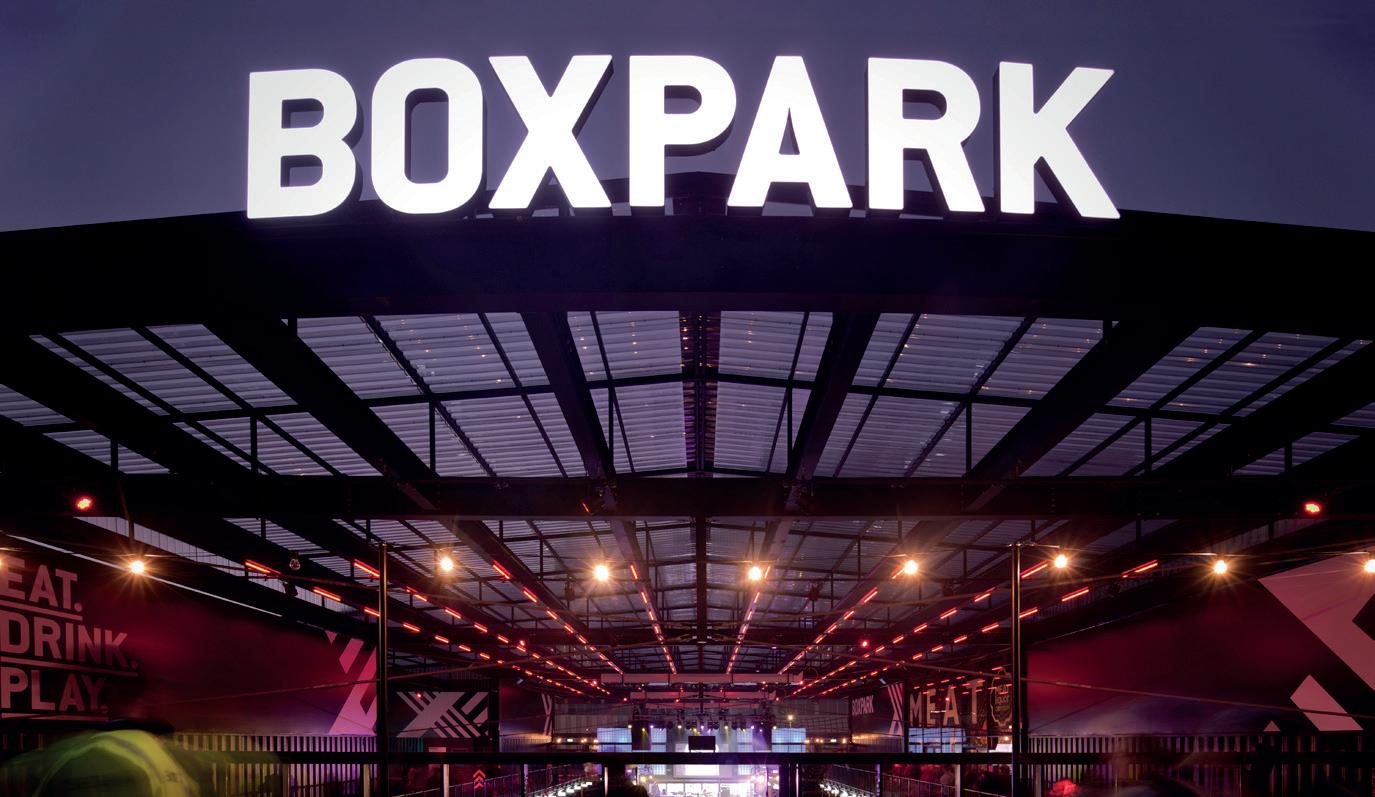
of the fovea, not in the middle,’ agreed Colin. ‘This was something discussed when blue LED signage was produced and it was suddenly “oh god, what’s wrong with my glasses?”. You simply cannot focus on the pure blue light. Because the centre of your fovea doesn’t have any blue receptors at all; so blue is ambient, it hangs.’
Just 2% of our cones (out of 100) respond to blue. By comparison, green or medium-wavelength sensitivity is at 32% and then 64% – the majority – are sensitive to the longer end of the spectrum, so red light essentially. ‘But red, I feel, also very much hangs on evolution. How did human vision evolve? Why do we even need colour vision?’ Lora questioned. ‘Everyone can watch a black-and-white movie and understand what is going on. So why do we have colour vision?’
EVOLUTION OF COLOUR VISION
When primates evolved from nocturnal animals to diurnal animals, we became more and more dependent on colour vision and acuity, Lora pointed out. ‘Why is that? It was mostly, it is thought, because of the need for survival in the form of improved foodfinding skills.
‘It gives our eyes the possibility to discern nice, ripe reddish berries on the background of greenish foliage. That is where our eyes are the most sensitive, and it helped our monkey ancestors to find the right food.
‘On top of that, research suggests that in seasons when berries were not in season those primates would use young, tender leaves as a source of nutrition, which are again slightly reddish in their tinge. So being able to see all that enhanced the ability of our species to survive. It also enhanced our ability to see toxic substances,’ Lora added.
Having trichromatic vision also helped primates and early humans encode another
major signal (as it still does today): skin tone modulation. ‘All trichromatic primates, in other words humans, monkeys and apes, have exposed faces or patches of skin elsewhere visibly on the body exposed. This allows us to “read” that,’ said Lora.
This, in turn, allows us to read changes in haemoglobin and oxygen saturation, so blushing and blanching for example. It allow us to read emotional signals: desire and lust, anger and threatening behaviour and so on. ‘We are wired really, to read that red so very well,’ said Lora.
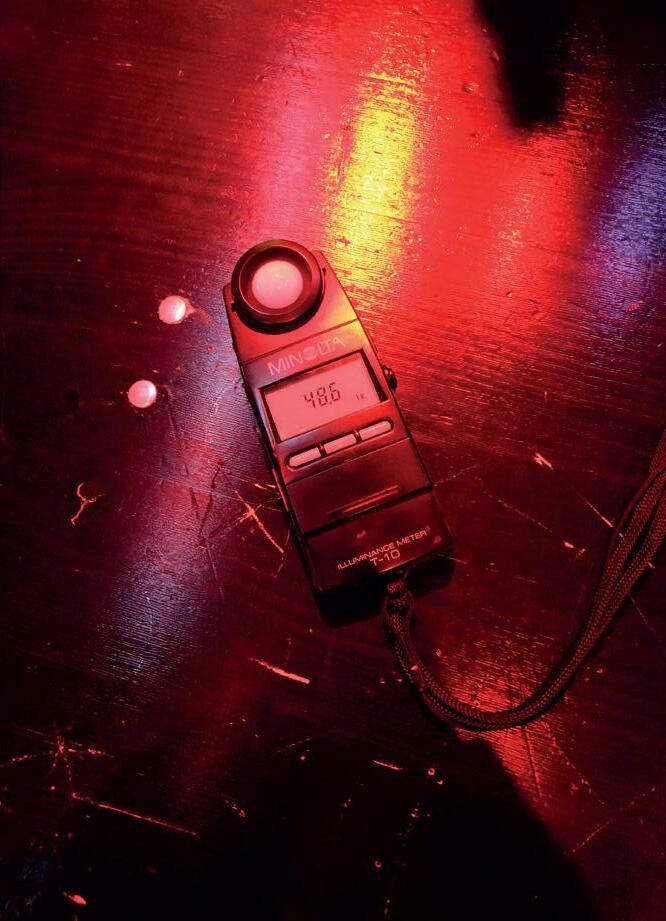
But what infactare we seeing when we see red? Colin and Lora at this point took us on a journey through art history, linguistics, memory, philosophy and colour perception. For example, much of what we learn in school about primary colours is flawed, Colin pointed out.
Isaac Newton’s assertion that there are only three primary colours was simply an expression of the trinitarian nature of God. ‘He also said there were seven colours of the rainbow because he wanted to match them to the stars and the planets. It is alchemy; none of this is true,’ Colin said.
Colin then discussed the work of Swiss Bauhaus painter Johannes Itten, especially his work around colour saturation. Itten identified seven fundamental categories of contrast: hue, light-dark, cold-warm, complementary, analogous, saturation, and extension. ‘You blend two colours together, if you’re using light, it becomes positive; you get a paler colour, you don’t get the midpoint between the two colours, you go up. But if you’re painting, you’re decreasing the light, you’re absorbing more light, so between the two colours you drop down,’ Colin explained.
‘So in actual fact, there are no three primaries at all. It all depends on where you start and whether you’re moving down or up
 A light meter showing the lux levels at Boxpark Wembley, as photographed by Lora Kaleva
A light meter showing the lux levels at Boxpark Wembley, as photographed by Lora Kaleva
JULY/ AUGUST 2023 LIGHTING JOURNAL www.theilp.org.uk 40
Boxpark Croydon (including main image on previous page and bottom), showing its ‘even carpet’ of 30 lux of pure red light. Photographs by David Barbour
SYSTEMS-LED INFRASTRUCTURE ENGINEERED WITH INTEGRITY


Combining Tier 1 strength with Tier 2 agility, VVB designs, delivers and maintains Mechanical, Electrical, Fire and Telecommunication services for Infrastructure Projects.
SECTORS WE WORK IN SERVICES
y Design
y Installation
y Testing & commissioning

y Assurance & handover
y Maintenance
PROJECT PHASE
y Temporary works

y Enabling
y Permanent works
Visit our website: www.vvb-eng.com


Follow us on: Linkedin
SURGE PROTECTION in street lighting columns and feeder pillars
What are surges?
A voltage surge (or spike) is a short burst of energy (a transient event) which typically last between 1 and 30 microseconds (a millionth of a second).
Voltages ranging between 1 - 10 kV can be experienced with smaller spikes occurring each day.
Causes
The causes vary but are commonly:
• A direct lightning strike to a power line
• A ground lightning strike into a supply cable
• The switching on, or off of a motor which can cause surges through the main power network
• An unplanned cable cut such as those that occur during construction or maintenance works when an unidentified cable is severed
• Nuclear electromagnetic pulses
• Electrical faults
Effects
Built-in surge protection can become degraded or fail without prior indication. Surges can degrade wiring insulation and destroy electronic devices; for street lighting this could affect relays and other electronic protective devices in the feeder pillar.
In the street lighting column, the LED drivers and lamp fittings are at risk of being damaged.
Street lighting and highway equipment are critical infrastructure and failure could cause interruption to service, e.g. failure of lighting on a busy motorway, or in a busy city centre with potential risk of serious injury or loss of life.
BS 8771:2018 18th edition IET wiring regulations
Why do we need Surge Protection for street lighting and highway infrastructure?
The current wiring regulations state: “Protection against transient overvoltages shall be provided where the consequence caused by overvoltage could result in:

• Serious injury to, or loss of, human life,
• Failure of a safety service, as defined in Part 2. (Part 2 defines “safety service” as “an electrical system for electrical equipment provided to protect or warn persons in the event of a hazard, or essential to their evacuation from a location”),

• Significant financial or data loss.


Protecting assets
Well-designed Surge Protection can safeguard:
3 Older generation lighting assets: wire wound and electronic ballasts
3 Modern lighting assets: LED luminaires, LED drivers
3 Other assets: CMS connectivity, CCTV cameras
3 Detectors and monitoring devices
3 Electrical equipment in feeder pillars
Installing surge protection, whether in isolators fitted within the lighting column, or on a distribution board situated in a feeder pillar, is far more cost effective than replacing the assets themselves.
Additional benefits of surge protection
3 Reduced maintenance costs
3 Simple installation and replacement procedure
3 Easy visual indication for maintenance teams
Surge protection devices (SPDs) can be fitted within isolators which can then be installed into street lighting columns. The example shown is an open isolator unit fitted with a SPD, two fuse carriers (CEL1132) and a switch (CEL1232).
Below shows a distribution board fitted with two SPDs, eight fuse carriers (CEL1132) and a double switch.
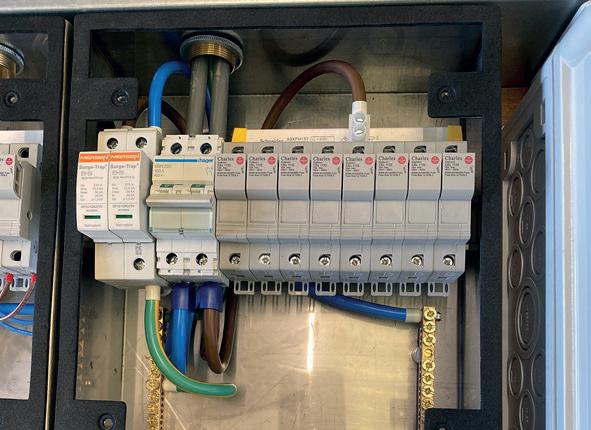

RAIL HIGHWAYS TUNNELS POWER TEMPORARY WORKS
you would like a quotation or wish to find out more about our products, e-mail:sales@charlesendirect.com or call +44 (0)1963 828 400 Wessex Way, Wincanton Business Park, Wincanton, Somerset BA9 9RR Company Reg No 1855059, England Premier Member Advertorial Premier Member Advertorial
If
The ILP’s ‘How to be brilliant’ events

when you’re mixing your colours.’
German artist Josef Albers’ studies of a square, over many decades, showed the complexities of colour interaction. ‘Every time you see one colour, that colour is transformed by the colour next to it,’ Colin highlighted.
COLOUR IN OUR MINDS
There is also then the question of how we process and perceive colour in our minds and, in turn, the language we use to describe it. A can of Coca Cola, for example, which we would probably describe as simply ‘red and white’, actually has 40,000 shades of red within it.
‘Our language can’t cope to describe vision, and the most recent studies over the last 10 years have revealed that one of the best examples is the Himba tribe in Namibia, and there are other isolated tribes too, which have developed a different colour perception system according to their language, not just their environment,’ Colin highlighted.
‘When you have all factors the same, you find that at these peripheral points, where one colour just turns into another – and you haven’t got the language to describe it – you can’t see it.
‘Every year there are more and more papers published on the linguistic nature of what is going in your brain and which is not immediately obvious. Linguistics influences our vision. What we think we’re seeing is as important as what we’re seeing,’ Colin added.
The vast majority of languages articulate light and dark, he pointed out. ‘The first colour ever described is red; it doesn’t matter which part of the world you’re in, red will be the first. Then comes green or yellow. But the other consistent thing is that blue is the last primary colour that gets described.’
Temples in Greece, for example, were partly decorated with blue pigment, yet
there is no word for blue in Ancient Greek as a language. Rather than blue, Homer described the sea as wine red or dark. ‘Red is always, the vast majority of the time – 99% –the first colour,’ Colin emphasised.
‘Humans have used colour to decorate themselves, their environment ever since we were around,’ Lora continued. The use of red pigment is the first one documented, being found in in South Africa from 270,000 years ago, as well as in the famous cave paintings of Chauvet and Lascaux. The oldest known jewellery, found on sites in Morocco, Israel and Africa, is nail shells painted in red ochre, as well as red haematite etched in geometrical patterns. They are 75,000 years old.
Red, Colin and Lora pointed out, has long been the colour of fire, sunset and sunrise; it has often been used to symbolise passing to the world beyond, the passing between reality and the spiritual world.
Returning to art, Colin highlighted the links between red and blue throughout art history. Cezanne, for example, always started with a blue background, with the warmth of the colour emerging from the blue background. ‘The shock of Pablo Picasso was that he allowed that blue into the body, and created the first really modern, contemporary, disturbing paintings,’ Colin said.
Red runs through the more contemporary, and even more disturbing, art of Francis Bacon, too, and in fact is the basis for much of the disturbing imagery within his work. ‘He conveys that in the intensity of the red. He is using a sense of violence of the modern world, a sense of despair, a sense of our mortality,’ Colin said. Equally, red is central –instrumental even – to the work of artists such as Chiharu Shiota and James Turrell.
‘But it is with the invention of electric lighting and this sudden boost of red everywhere, in the evening environment, that you get an explosion of red in paintings. Often,

again, associated with “women of the night”. You have, for example, Toulouse-Lautrec and the night-time economy, let’s say, of Paris of LaBelleÉpoque,’ said Colin.
CULTURAL PERCEPTIONS AND ASSOCIATIONS
This, in turn, brought us to a discussion around the role – and perception – of red as a colour of temptation and love, as well as sex, carnality and lust. ‘There is a reason why it is the “Red light district” because red light is reflecting the inner-most part of your translucent skin. Blue light bounces off the top. Where are all your scars and creases and age lines? On the top. Red light gives you perfect skin, from your innermost layer. But we also have a cultural association for that in the West,’ Colin said.
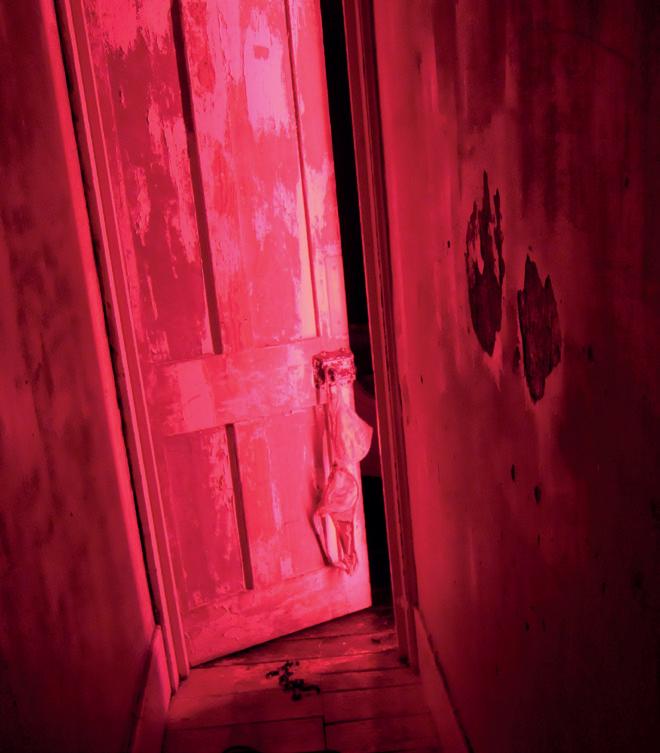
Alongside this, it needs to be recognised that the use and perception of red differs between cultures. Red, for example, tends to be used much more prevalently in the Far East – think of all the red you see in Chinatowns – and will often have different associations, such as around luck, good health and spirituality.
What about, then, red within artificial light? Colin and Lora pointed to a number of recent studies that have shown a link between coloured light, red especially, and the limbic system in the brain. Lora, for example, highlighted an Ohio State University study that linked chronic light exposure during the night with depression in
The UCL Wilkins Refectory, showing the suspended 10m-diameter circular pendant and matching 2.4m diameter pendants. Photograph by Tom Niven
JULY/ AUGUST 2023 LIGHTING JOURNAL www.theilp.org.uk 42
Lora Kaleva’s ‘Lust’ for the IALD’s ‘Seven deadly sins’ challenge in 2014, and (right) London’s red crane skyline
hamsters [1]. Blue light had the strongest effect, followed by white light. ‘The hamsters that showed the least level of depression were sleeping under red light or no lighting at all,’ she explained.
The Lighting Research Center (LRC) in the US has also carried out studies into red light and alertness [2]. Exposure to red light at night can reduce self-reported sleepiness and improve mood, studies have shown. Shining red light into eyes of sleeping subjects reduced symptoms of sleep inertia and improved performance straight after wakening, something that could be valuable for shift workers or for emergency workers on call in the night who need come to full alertness very quickly.
As an aside, the LRC has also found in its studies that red light does not disrupt the body’s melatonin production – and by extension our circadian rhythm. This, in the scheme of things, is arguably quite important in that it differentiates red from blue light quite significantly.
Returning to Colin and Lora’s presentation, Colin pointed out: ‘As a result of these studies, they have already started installing red light in control towers in airports.’
This also helps to explain why hazard lights are red at night. ‘It is for the pilots, because they can see the red. Their peripheral vision says “oh it’s red over there”, they’re not having to turn their head. That’s also why police lights are blue, because you want to check what the blue is, your eyes are excited, but your peripheral vision is not excited by red. So night has very special properties in red,’ Colin emphasised.
Now in fact, rather than London ‘turning blue’, when you drive into London from the M25, the predominant colour you will see is red, Colin highlighted. ‘London has become draped in this beautiful net of red LEDs, from all the cranes and buildings. Since we started looking at this paper, when we said “oh London has turned blue”, it is now blood red, from a distance.
‘At the same time that we have got more cranes and hazard lights, the red lights are now LEDs; it is a pure red. It is travelling further; the long wavelengths actually travel further at night through the air.
‘But, also, we’ve switched off all the other lights. For example, we as lighting designers used to have a third of our portfolio in external façade lighting. There are very few external lighting schemes now; in fact, between 2010 and 2012 I finished quite a few external façade lighting schemes and the client said, “thank you very much” and switched them off! They then said, “oh we use them on special occasions; we don’t want to look profligate”. Our societal conscience has changed, which we can see in lighting,’ Colin added.
RED WITHIN ARTIFICIAL LIGHTING
As the talk came to its conclusion, Colin and Lora looked at the use of red light within various projects, including, first, his work on the Magna Science Adventure Centre in Rotherham from Colin’s time at Speirs & Major, as it then was.
‘The association with red was to show it was back alive; this was originally a disused steel plant. We inserted “pavilions” for air, fire and water and the façade was a translucent red plastic. In that low-level environment you could still walk around safely in the red light, but you could still see all the darkness of the steel because your eyes had adjusted to the red; your iris was still very wide,’ Colin explained.
Red had even been central to the very first scheme Colin completed (whilst at Speirs &
Major), a one-mile-long coking plant in Essen, Germany, in 1999. ‘This was filtered red light on to the red, rusting, decaying industrial plant. We had to double the wattage at that time, though that wouldn’t be a consideration now,’ Colin said.
‘But we also had to include one element of blue because, similar to what we discovered with Josef Albers, your eye adjusts according to the colours it sees. If you put red everywhere, within a minute or two minutes, you can’t see any red any more, it’s gone; your eye adjusts. So you put the blue in to keep the red visible.’
‘We’ve now got much, much better quality in terms of light sources. It allows us to inject a level of subtlety into our lighting schemes, which would not have been possible before LED was invented,’ added Lora.
She, in turn, highlighted BDP’s work at the UCL Wilkins Refectory. Here, because of the extended opening hours, the lighting needs to give the space very distinct day and evening atmospheres. A key feature of the interior is a suspended 10m-diameter circular pendant and matching 2.4m diameter pendants in the orangery wings.
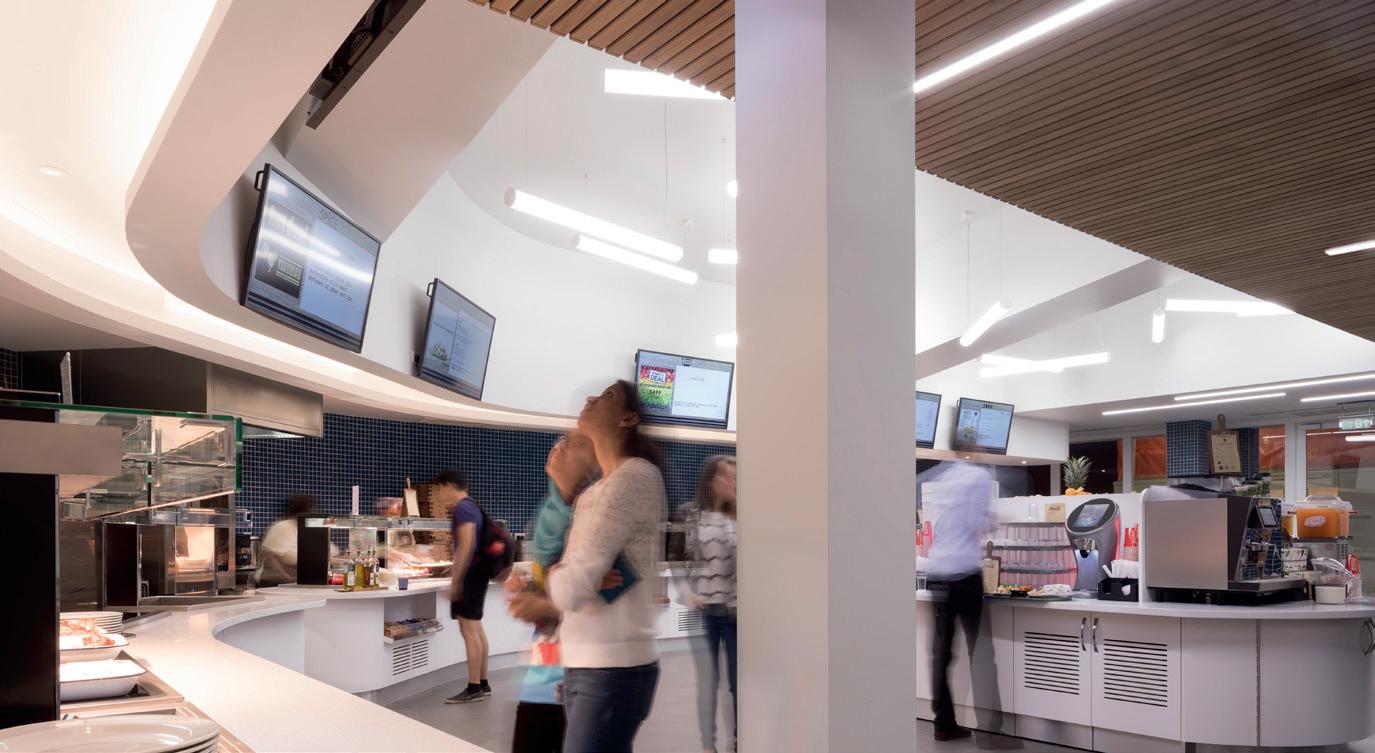

The main interior lighting is provided by a series of lit ‘rafts’, which make the whole ceiling glow. In the evening, the ceiling lighting dims and small pendants provide warm pools of light to the seating, while floor-recessed uplights accent the arches of the large columns.
‘We used very subtle shifts in the ceiling, the soffits are illuminated with uplighting, 4000K. And then every downwards detail was 3000K or even 2700K. So the downward accent on to the people is warm, but you still have that pleasant brightness from above,’ Lora explained.
‘These little subtle changes allow us to create comfortable spaces that work both during the day as well as during the night. During the day we accept and accentuate the ceiling and the brightness and the crispness
www.theilp.org.uk JULY/ AUGUST 2023 LIGHTING JOURNAL 43
The refectory servery is flooded with 4000K white light apart from a 2700K cove detail in the counter. Photograph by Ben Blossom
The ILP’s ‘How to be brilliant’ events
The ILP’s ‘How to be brilliant’ events

of the 4000K LED. In the evening that gets dimmed right down, and then the warmth of the downward illumination starts coming through, so we can create a pleasant shift from a daytime to an evening-time space, which is still not over-stimulating,’ she added.
Even the servery area was well-considered from a lighting perspective. ‘The majority of the space is flooded with 4000K white light, just to keep it bright, to keep it crisp. However, along the servery counter there is a cove detail and that’s 2700K, just to make sure that the food still looks nice and appealing,’ Lora said.
‘Again, we are emulating that desire for berries at the point of your purchase,’ Colin added, to laughter.
Turning to the exterior terrace area, this is very much an area treated as an extension of
the refectory and has a higher lighting level, yet one achieved without dedicated down lighting.
‘There is not a single bollard, there is a not a single floodlight; there is nothing lighting this terrace apart from reflected light from the adjacent façades and accents to where the changes of level are happening. Because of course it is good practice to highlight changes of level!’ Lora explained.

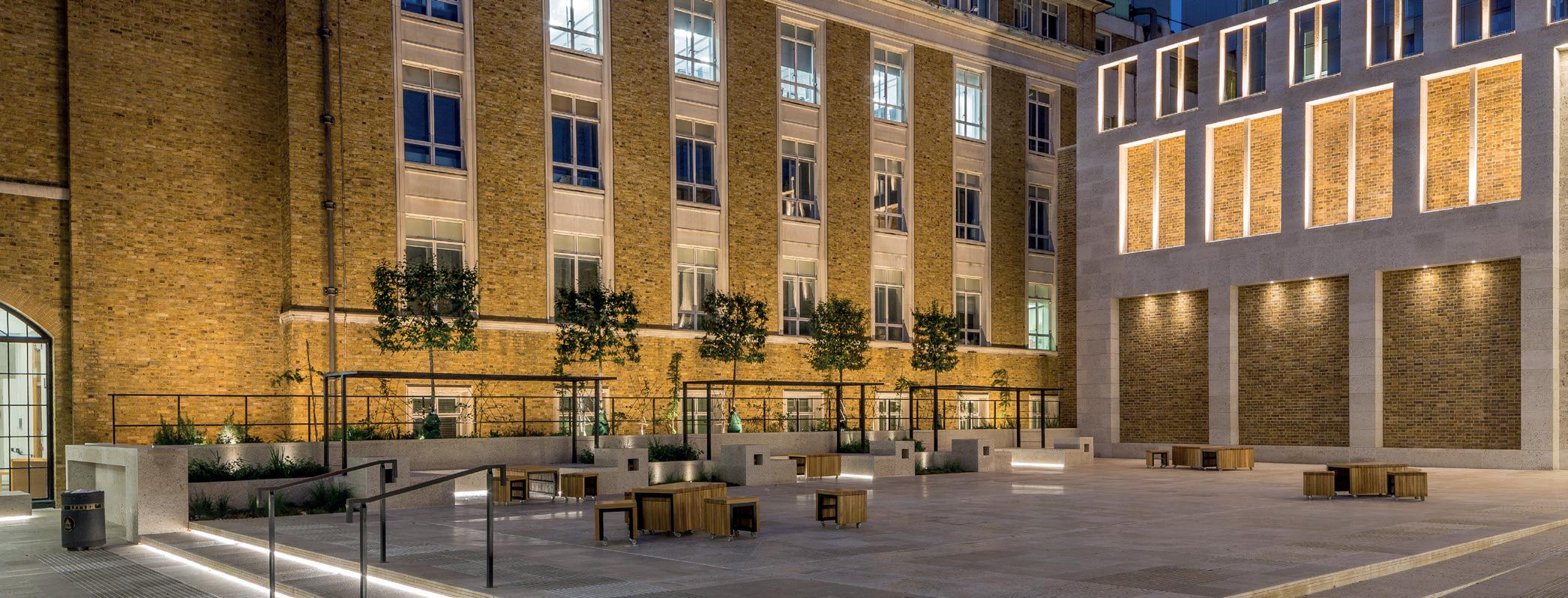
‘But everything else is pretty much left to balance and to celebrate the warm brick and the lovely warm-white Portland stone that the architect specified,’ she added.
‘As long as all light is reflecting from the material, your eye adjusts to the level. As long as you’ve removed glare and controlled contrast, it doesn’t matter what the light level is. And that’s how we were able to keep the space as clear as it was,’ Colin added.
BDP is also working on the various Boxpark ‘piazza’ street food, drinks and entertainment venues in places such as Croydon, Wembley, and Shoreditch and Liverpool, among others. ‘It is intended as a night-time event space. This is an entirely black space that has an even carpet of 30 lux of pure red; so people “glow” in this black background,’ Colin explained.
‘There is still white, there is contrast; you’re aware of the red because of the spill light from the perimeter. But the red is actually the people glowing in the space.
‘It is all about supporting the idea that we have evolved, our bodily, night-time circadian system is to be under a sky during the day and in front of a fire in the evening. We’ve done that for tens of thousands of years. Go figure! It really is that simple,’ Colin added in conclusion.
FIND OUT MORE
You can find out when and where the next How to be brilliant events are taking place by going to https://theilp. org.uk/events/how-to-be-brilliant/ How to be brilliant 2023 is kindly being sponsored by BEGA, which allows the ILP to maintain it as a series of free-to-attend, fun and friendly sessions.
How to be brilliant is open to all, with an emphasis on allowing less experienced students and staff to meet renowned industry experts face to face in a confidence-building atmosphere of encouragement and inclusion. All sessions include continuous professional development time.
[1] ‘Rodents
at night, but it can be reversed’, Science Daily, July 2012, https://www.sciencedaily.com/releases/2012/07/120724104432.htm [2] ‘Light and health’, Lighting Research Center, https://www.lrc.rpi.edu/programs/lighthealth/LightAlertness.
2019, LEDs Magazine,
seem depressed from dim light
asp; ‘New studies show cycles of blue and red light promote circadian entrainment’, December
https://www.ledsmagazine.com/lighting-health-wellbeing/article/14073357/new-lighting-research-center-studies-show-blue-and-red-light-cycles-promote-circadianentrainment
JULY/ AUGUST 2023 LIGHTING JOURNAL www.theilp.org.uk 44
The UCL Wilkins terrace area. The light comes from reflected light from the adjacent façades and accents to where the changes of level are happening. All photographs on this page by Tom Niven
At WSP, we are proud to offer comprehensive electric vehicle infrastructure design and consultancy services to cater to your specific needs for both on-street and off-street charging.
At WSP, we are proud to offer comprehensive electric vehicle infrastructure design and consultancy services to cater to your specific needs for both on-street and off-street charging.
Our experienced team understands the critical importance of well-designed charging solutions in driving the success of electric mobility. With a focus on collaboration and innovation, we work closely with you to create comprehensive solutions that seamlessly integrate charging stations into urban landscapes and optimize off-street charging networks. Our consultancy services prioritise scalability, futureproofing, and a user-centric approach, ensuring an easy and efficient charging experience.
Our experienced team understands the critical importance of well-designed charging solutions in driving the success of electric mobility. With a focus on collaboration and innovation, we work closely with you to create comprehensive solutions that seamlessly integrate charging stations into urban landscapes and optimize off-street charging networks. Our consultancy services prioritise scalability, futureproofing, and a user-centric approach, ensuring an easy and efficient charging experience.
Trust WSP to shape the future of electric mobility through our expertise in design and consultancy for on-street and off-street electric vehicle charging infrastructure.
Trust WSP to shape the future of electric mobility through our expertise in design and consultancy for on-street and off-street electric vehicle charging infrastructure.

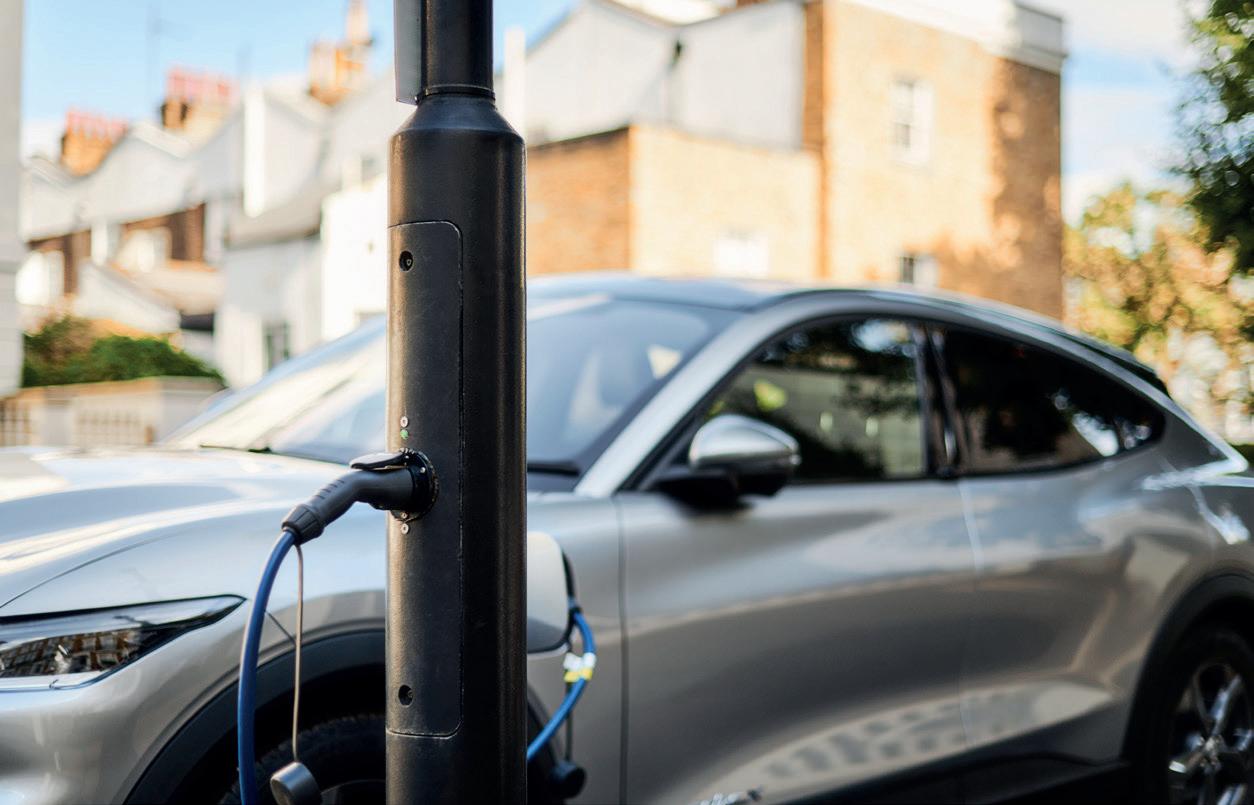
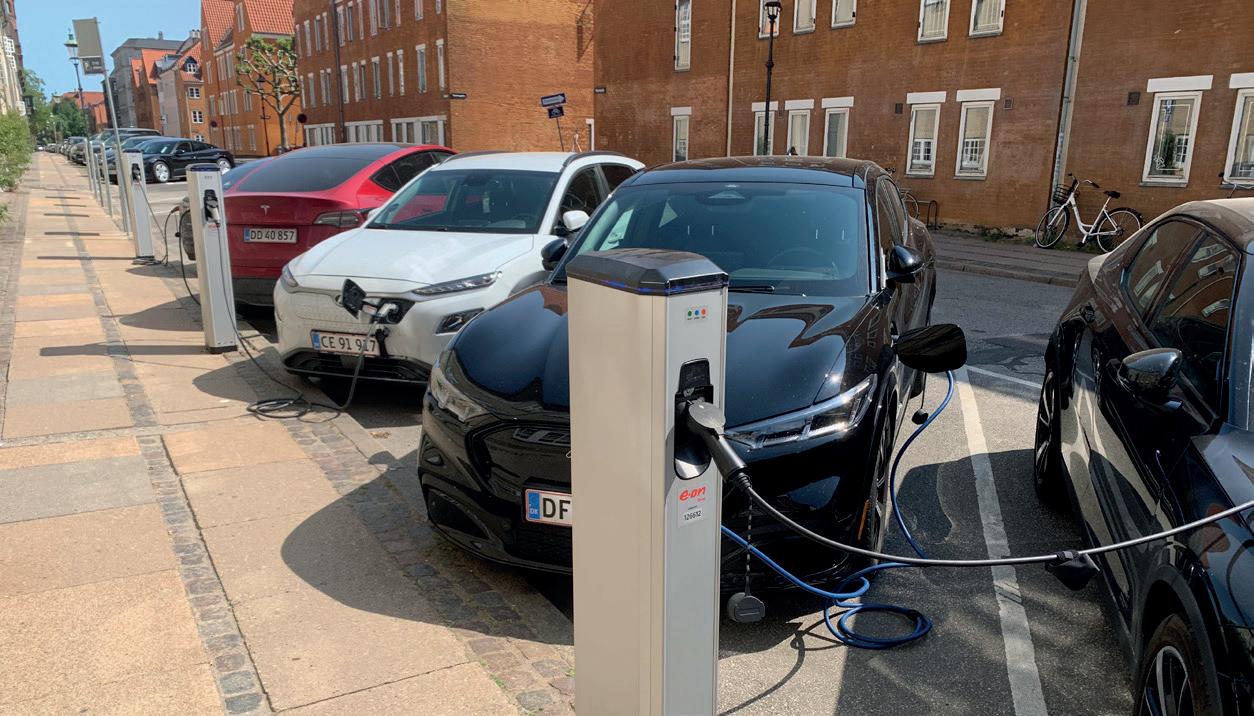
For further information contact:
For further information contact:
Daniel Scolari
Daniel Scolari
Electric Vehicle Charging Capability Lead Lighting & Energy Solutions
Electric Vehicle Charging Capability Lead Lighting & Energy Solutions




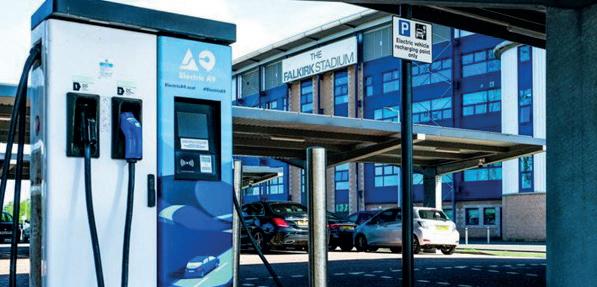
Daniel.Scolari@wsp.com
Daniel.Scolari@wsp.com
© Photo Credit: Ubitricit y UK
© Photo Credit: Ubitricit y UK Premier Member Advertorial Premier Member Advertorial
PEARL IN THE SHELL
The new lighting scheme for 80 Strand, formerly Shell Mex House, in London draws inspiration from its Art Deco heritage while also bringing a contemporary cohesion to its communal spaces
By Nic Paton
Probably still better known to Londoners and visitors to the capital alike by its old name, Shell Mex House (or just Shell House), 80 Strand is the landmark building that dominates your view across the Thames between Embankment and Temple when you’re walking down the South Bank.
Located at (no surprise) 80 Strand, the Art Deco Grade II-listed building was originally opened in 1932 and designed by the architect Frances Milton Cashmore.

It was for many years the London headquarters of Shell and BP (or technically a joint venture between the two imaginatively called Shell-Mex & BP) until it was sold in the 1990s, with most of its 12 floors now occupied as commercial office space by the publisher Pearson.
The building has recently undergone a root-and-branch refurbishment, encompassing its 226,000sq ft of office space, main reception area, communal spaces and facilities.
This has, naturally, included a new lighting scheme, developed by Speirs Major and which includes a series of bespoke luminaires that, the practice has argued, celebrate the building’s heritage while contributing to an elegant and contemporary working environment.
The Speirs Major scheme has focused on redesigning the lighting for the building’s linked communal spaces, with its design centred around a series of custom pieces.
GLOWING SURFACES
Drawing out key Art Deco characteristics such as geometric shapes, frames and grids and working with a balance of translucent and solid materials, the practice collaborated with architects PDP, interior designer
JULY/ AUGUST 2023 LIGHTING JOURNAL 46
Architectural lighting
Hannah Carter Owers, and landscape designer Andy Sturgeon to create a series of beautifully integrated designs.
As Speirs Major senior partner Keith Bradshaw explains: ‘We drew inspiration from lighting designs from the period and then streamlined and contemporised those ideas, carefully considering how each detail would integrate within each space.
‘Interestingly, while the characteristic large, glowing surfaces give the impression of creating a bright and airy space, in most cases we also added subtle additional lighting to balance the composition and boost the light levels without detracting from the visual impact of the statement pieces.
‘This approach feels naturally harmonious with the heritage architecture while delivering a vibrant office environment. In all, we created five exquisitely detailed bespoke designs for the various spaces, with commonality in their design language that adds to the sense of cohesion as you travel through the building,’ Keith adds.
So, to details. The entrance from the
Strand is through a colonnade. As darkness falls, an even soft wash of light to the vaulted ceiling now creates an enticing street presence, argues Speirs Major, punctuated by the ‘glowing orbs’ of the refurbished original pendants.
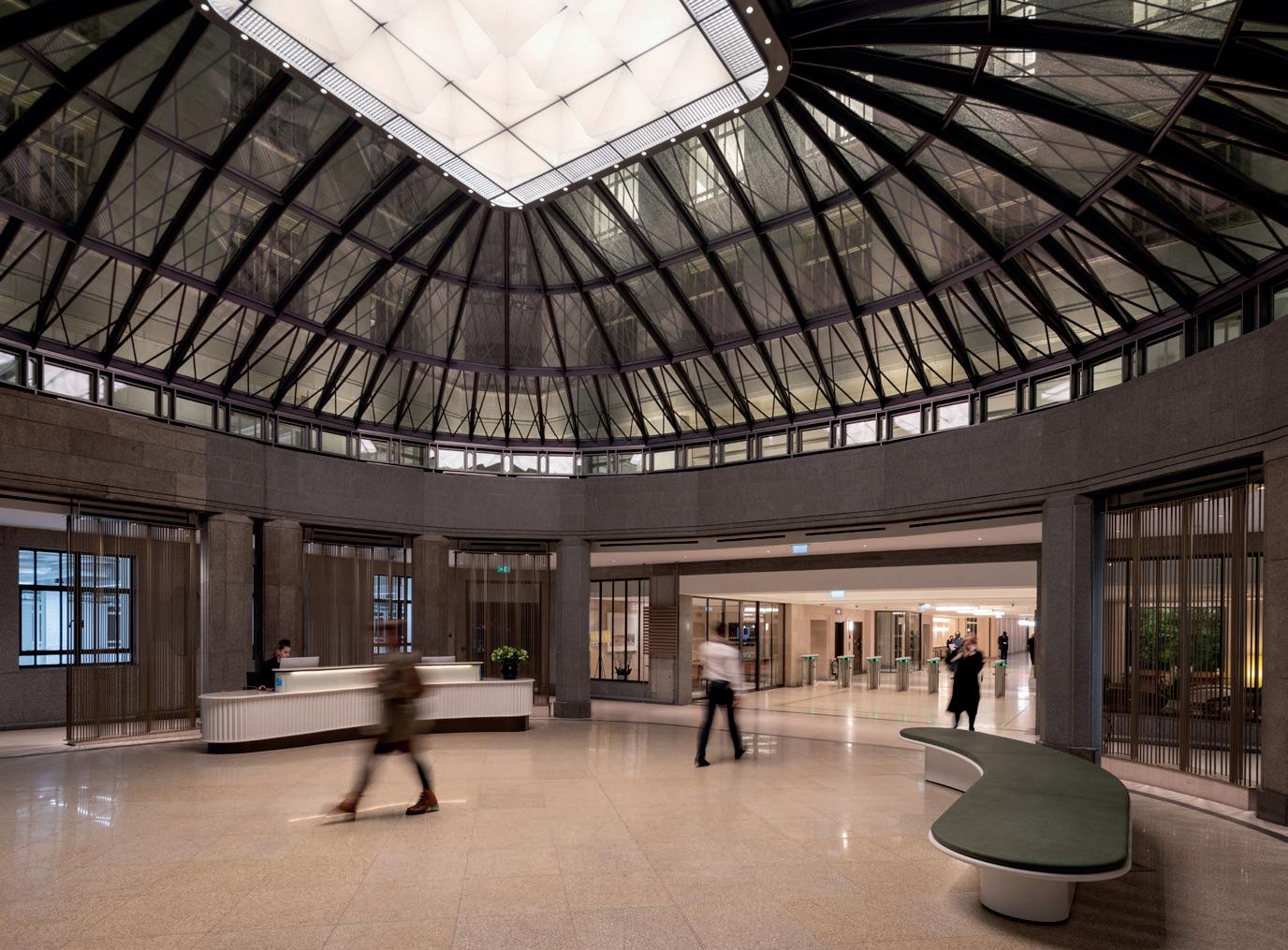
Emerging into an internal courtyard, workers and visitors enter the building through a dramatic new glass entrance pavilion. The fact that minimal quantities of natural light penetrate this area meant that getting the artificial lighting right for this space was crucial to a great first impression.


STATEMENT PIECES
Inside, set beneath the apex of the pavilion roof is the first of the design’s statement light pieces. The 5m x 5m laylight features a series of backlit inverted pyramids set within a grid frame and ringed by downlights, creating a beautiful graphic lit effect.
Soft washes of light then highlight the courtyard façades, the screens behind the
www.theilp.org.uk JULY/ AUGUST 2023 LIGHTING JOURNAL 47
The new Speirs Major lighting scheme at 80 Strand, all images Speirs Major and James Newton. Main image left: the bespoke statement luminaire at the apex of the entrance pavilion. This page, above: the soft uplighting to the building façades, with (below) a render from the design. Bottom: another view of the entrance pavilion
Architectural lighting
reception desk, and the desk frontage, all helping to frame the space and aid navigation.

In the double-height reception area, an arrangement of beautifully detailed fluted glass and bronze wall lights is complemented by a series of suspended grid-patterned light boxes leading to the lift lobbies.
Carefully positioned to reinforce the rhythm and geometry of the architecture, the practice argues, these details create a welcoming atmosphere and help visually define the different functional spaces, aiding wayfinding

The lighting design journey continues into the upper level of the newly added Glasshouse Garden, a flexible breakout space located in a former light well.
Double-height glass-framed spaces flank the upper and lower corridors with vaulted ceilings, all lit by warm, custom spherical pendants.
With natural light, again, unable to reach ground level, highlights to planting and uplighting to the façades and green walls create a soft surrounding glow. Additional task lighting helps shape a hospitable atmosphere, ideal for meeting, networking, and socialising.
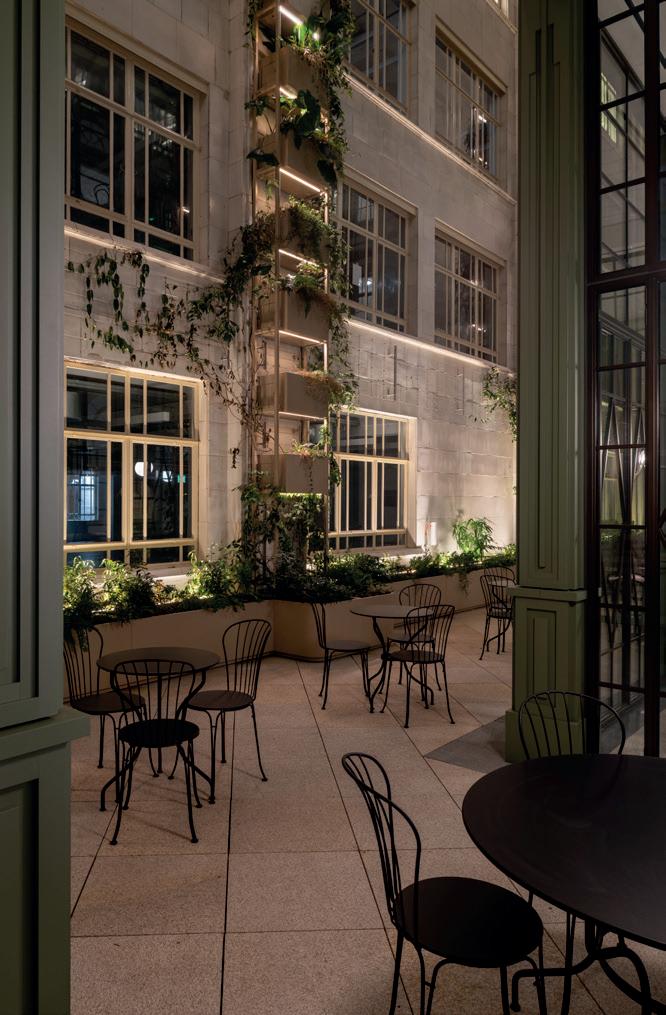
From the lower corridor of the Glasshouse, a colonnade then leads out towards the Embankment entrance reception area.
Here, the original pendants, refurbished and upgraded, cast light on to the vaulted ceiling to keep this transition area feeling bright and spacious.
The entrance area was previously lit with an assortment of downlights and uplights that gave it a harsh yet flat appearance. Now, a neat bespoke lozenge-shaped lightbox detail delivers, what the practice describes as ‘a soft and welcoming quality of light while also acting as a beautiful feature detail of the ceiling’.
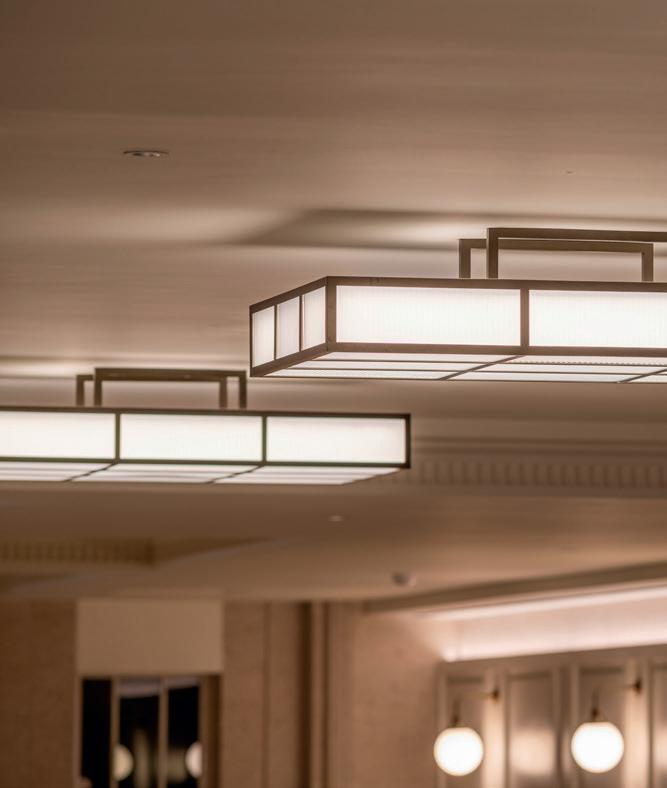
As Keith Bradshaw summarises: ‘Creating a contemporary feel to the light while drawing on heritage features is not as easy as it sounds. We are really happy with the way the light looks within the Art Deco heritage of the building, whilst providing a sharper, luxury feel for its re-energised image.’
PROJECT CREDITS
Client: Strandbrook
Architect: PDP London
Interior Design: Carter Owers
Lighting design: Speirs Major (Keith Bradshaw, Jaime Fuentes McGreevy, Jungwon Jung, and Marina Andronescu)
Landscape architect: Andy Sturgeon
Custom luminaires: DAL
Photography: James Newton
JULY/ AUGUST 2023 LIGHTING JOURNAL www.theilp.org.uk 48
Clockwise from top: the bespoke Art Deco-inspired luminaires within the lobby spaces; the lozenge-shaped luminaire within the Embankment entrance area; a detail of the lobby lightbox luminaire; and Glasshouse Garden breakout space, showing the mix of soft light to planting and task lighting
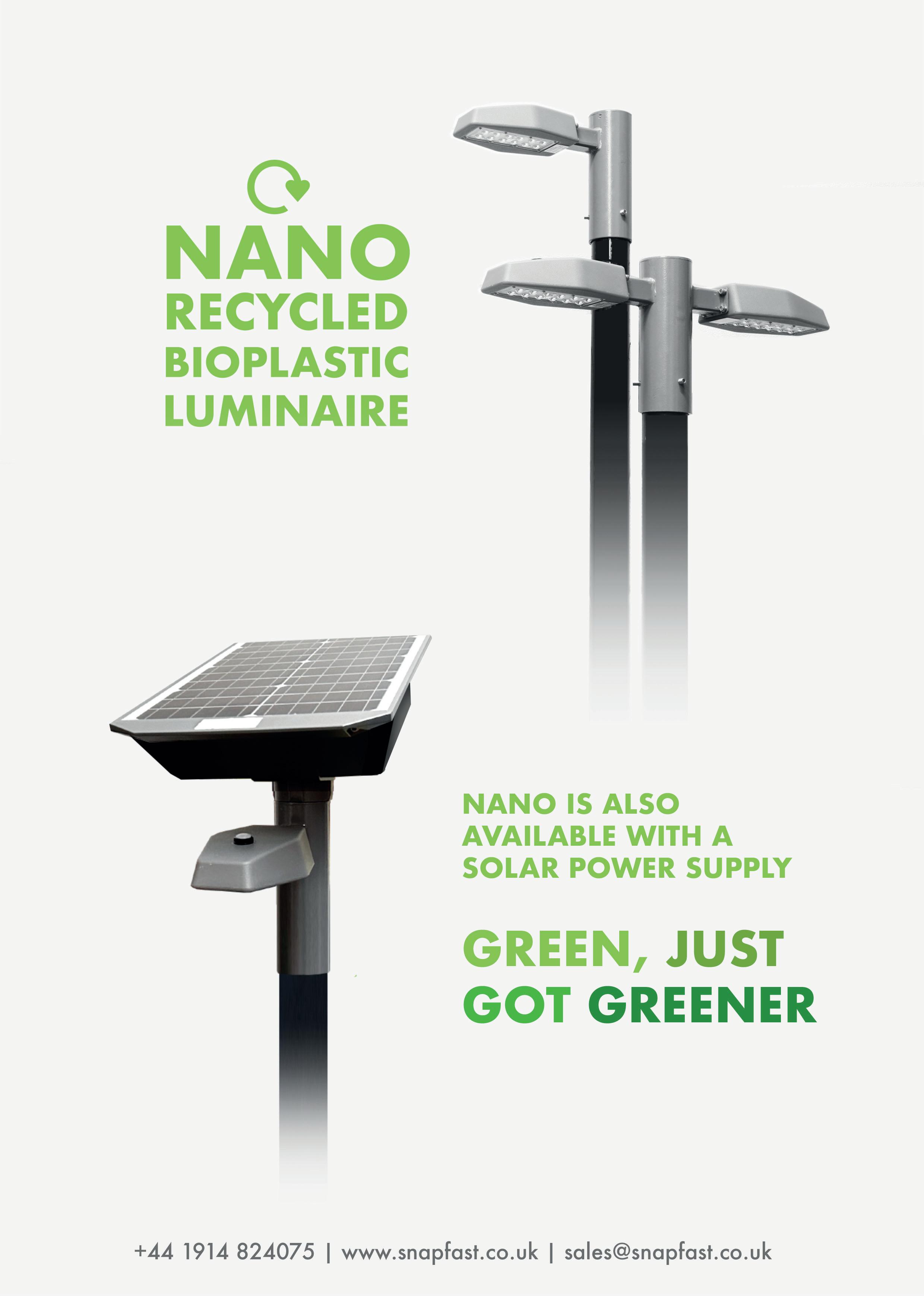
SKILLED WORK
With an ageing workforce and not enough young people choosing it as a career, the highway electrical industry is facing something of a skills crisis. Making better use of apprenticeships, especially the highway electrical apprenticeship, needs to be an urgent priority for the industry
By Greg Jarvis
As the infrastructure demands of our modern world continue to grow, the need for skilled professionals in the construction industry has never been greater.
However, this sector is currently facing a critical skills shortage, with an ageing workforce leaving the industry and a limited number of young people entering it.
This is especially true in the highway electrical industry, where the development and maintenance of critical infrastructure such as street lighting and traffic signals is essential to the safety of our roads.
One of the most effective ways to address this skills gap is through apprenticeships. Apprenticeships offer a structured learning programme that combines on-the-job training with classroom instruction, providing an excellent foundation for the development of new skills.
UNDERSTANDING APPRENTICESHIPS
Apprenticeships offer a clear pathway for young people to enter the industry, with the added benefit of paid employment and the potential for career progression. Yet, despite these clear benefits, the
construction sector has still struggled to attract new talent.

This is partly because of a lack of awareness among young people about the opportunities available in the industry. The pandemic had a significant impact on the sector, with many construction sites forced to close, and apprenticeships put on hold. This only served to exacerbate the existing skills’ shortages, making it even more crucial to find effective solutions.
In the UK, apprenticeships are a highly structured and regulated training programme that can range from Level 2
JULY/ AUGUST 2023 LIGHTING JOURNAL 50
(equivalent to GCSE) to Level 7 (equivalent to a master’s degree). An apprenticeship usually lasts between one and four years, depending on the level of apprenticeship.
In the highway electrical industry, the skills shortage is particularly acute. The industry is highly specialised, and there are relatively few training programmes available to provide the necessary skills and knowledge. This means that apprenticeships have an even greater role to play in building a new generation of skilled professionals to meet the industry’s needs.
One of the unique features of the apprenticeship system is that apprentices receive on-the-job training in addition to classroom instruction. This means that apprentices can learn the practical skills required for their chosen profession by working alongside experienced professionals. The on-the-job training component of an apprenticeship typically makes up around 80% of the training, with the remaining 20% being classroom instruction.
Another key feature of the latest apprenticeship system is the end-point assessment (EPA). The EPA is the final test that apprentices must pass to complete their apprenticeship.

The EPA is a rigorous test that assesses the apprentice’s skills, knowledge, and behaviours, and ensures that they are fully
competent in their chosen profession. The EPA is designed and conducted by an independent assessor, who has no affiliation with the employer or training provider.
FUNDING AN APPRENTICESHIP
Companies whose wage bill exceeds £3m a year have to pay into the Apprenticeship Levy. Previously, only these levy fee-paying companies could draw out monies from that fund to pay towards apprenticeships.
However, because of the lack of uptake, this has now been changed so that even those companies who don’t meet the levy salary threshold can now access some of the necessary funding to take on new staff.
Essentially, the government will contribute to the classroom instruction part of the apprenticeship while the employer pays for the apprentice’s salary and provides the on-the-job training and mentoring.
The level of funding provided by the government depends on the apprenticeship being taken with higher levels receiving more funding.
CHOOSING A TRAINING PROVIDER
When choosing a training provider for an apprenticeship, it is important to consider several factors.
The provider should offer high-quality training and support, with experienced
Lighting and skills
and qualified trainers who have an in-depth understanding of the industry.
The provider should also have the necessary resources and facilities to deliver the training, such as workshops, equipment, and training materials. They should be able to offer a range of training options, including classroom instruction, practical training, and online learning.
It’s also important to ensure that the apprentice is enrolled on the correct programme that meets their skills and interests.
The training provider should have a clear understanding of the apprenticeship programme, including the required qualifications, the structure of the programme, and the assessment process. They should also consider the apprentice’s interests, career aspirations, and skill level when recommending a programme.
Being on the wrong programme can have serious consequences for the apprentice. They may not receive the training they need to succeed in their chosen profession, and they may struggle to complete the apprenticeship.
This can lead to lower retention rates and higher dropout rates, which can have a negative impact on the apprentice, the employer, and the industry as a whole.
Additionally, being on the wrong programme may result in the apprentice being unable to achieve the necessary
www.theilp.org.uk JULY/ AUGUST 2023 LIGHTING JOURNAL 51
Lighting and skills

qualifications or meet the industry standards, which can limit their employment opportunities in the future.

THE HIGHWAY ELECTRICAL APPRENTICESHIP

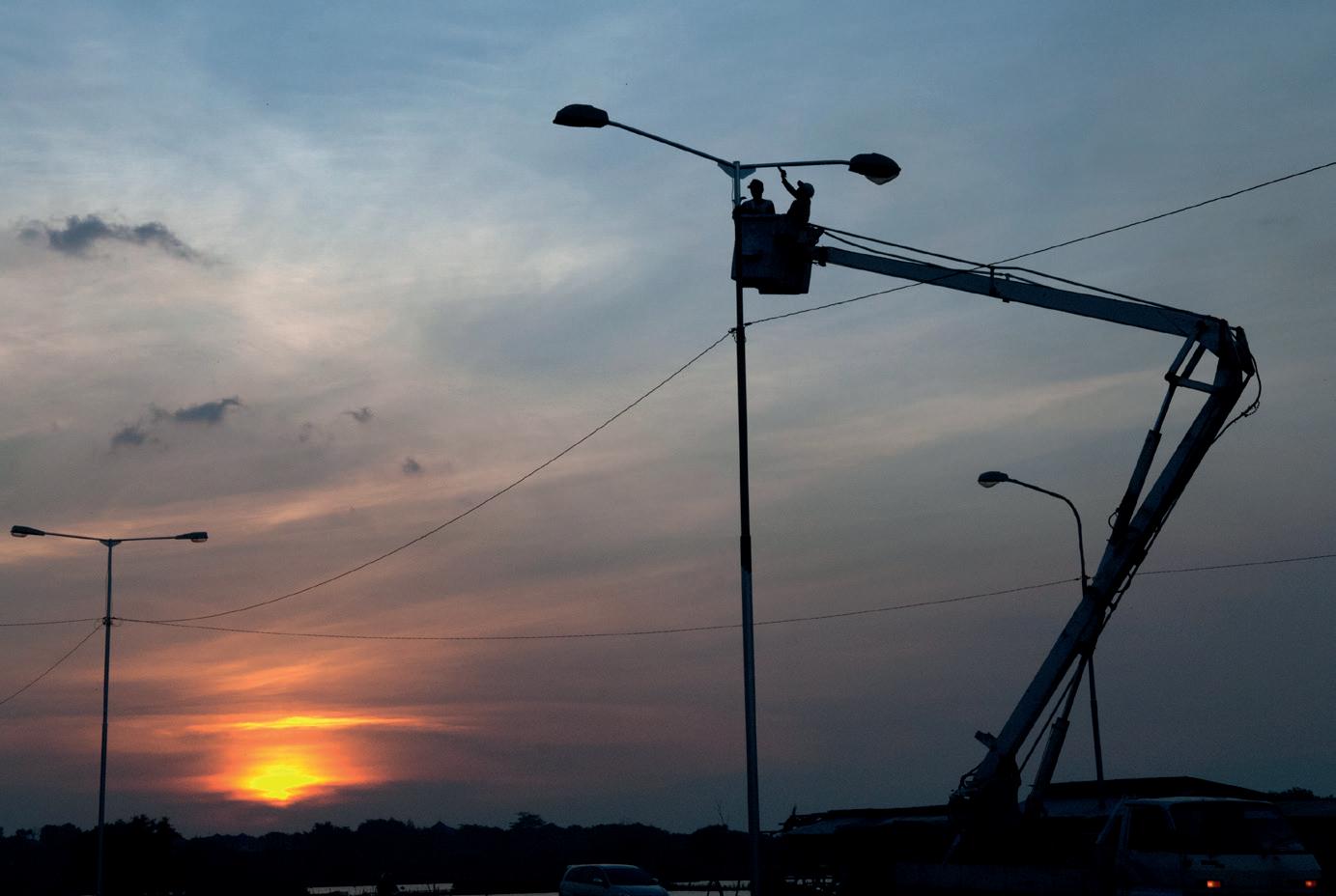
The Highway Electrical Maintenance and Installation Operative (HEMIO) apprenticeship is designed for those interested in working in the highway electrical industry.
The programme has a duration of 24 months and includes on-the-job training as well as classroom instruction. The
apprenticeship standard will specify the minimum number of hours of on-the-job training per week, which is then provided by the employer.
This training involves hands-on work experience in the installation and maintenance of highway electrical systems.

The off-the-job training generally makes up at least 20% of the apprenticeship and is provided by a training provider.
This classroom instruction covers topics such as health and safety, electrical principles, and highway electrical installation, giving the apprentice the knowledge and qualifications needed for the highway electrical industry. This classroom knowledge can then be put in to practice on site with their mentor.
The apprenticeship includes an EPA, which is conducted by an independent assessor. The assessment for the highway electrical apprenticeship includes a practical assessment, a vocational test, and an interview, and is designed to ensure that the apprentice has the necessary skills and knowledge to work as a highway electrical maintenance and installation operative.

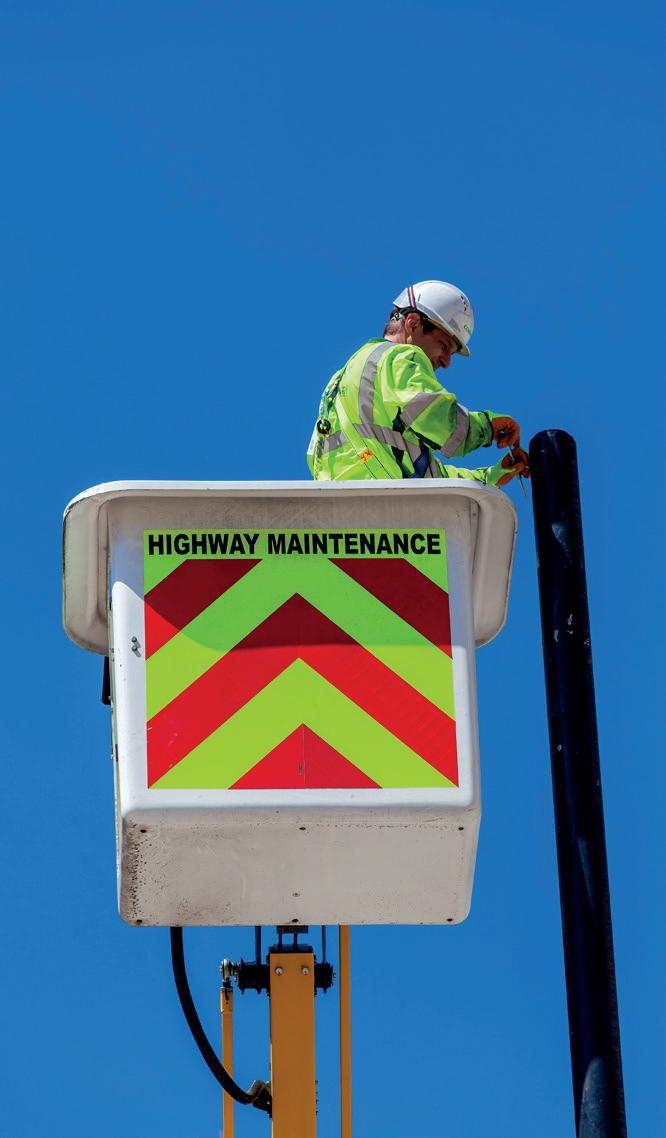
The HEMIO apprenticeship requires the apprentice to achieve a Level 2 NVQ and Technical Certificate in highway electrical systems.
Those operatives who are eligible can also undertake the Level 3 highway electrician or service operative apprenticeship. There is no maximum age for the apprenticeship, so it is also an opportunity for older learners who are eligible to change from their existing profession to something new.
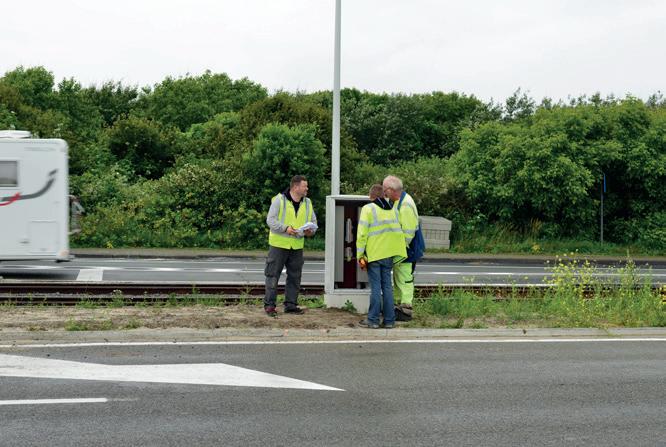
CONCLUSIONS
Overall, the apprenticeship system in the UK provides an excellent opportunity for young people to enter the construction industry and develop the skills and knowledge necessary for success.
The on-the-job training component of the apprenticeship ensures that apprentices learn practical skills from experienced professionals, while the end-point assessment ensures that apprentices are fully competent in their chosen profession.
The funding provided by the government, combined with the Apprenticeship Levy, ensures that employers have the necessary resources to take on apprentices and provide them with the training they need to succeed in the industry.
Ultimately, by taking advantage of the apprenticeship system, we can build a new generation of skilled professionals to meet our infrastructure demands and the workforce and leaders of tomorrow.
FIND OUT MORE
You can find out more about the Highway Electrical Maintenance and Installation Operative (HEMIO) apprenticeship here: https:// apprenticeshipguide.co.uk/ apprenticeships/ highway-electrical-maintenance-and-installation-operative-apprenticeship/
JULY/ AUGUST 2023 LIGHTING JOURNAL 52
Greg Jarvis is connections sales manager at Electrical Testing Ltd as well as chair of the Employers’ Trailblazers Group for Highway Electrical Systems
THE ARCHITECTURE
anolislighting.com
OF LIGHT
Bee Seen CROSSAFE RETRO quickly upgrades a standard non illuminated 76mm Belisha beacon post into a fully illuminated post in less than 15 minutes.
Quickly converts a standard 76mm post into a 114mm illuminated post

No excavation or disconnection/ reconnection costs
High performance LED lighting

Adjustable daytime white band illumination brightness
Night-time dimming

IP 65 sealing to lighting elements



ZEBSTAR or ZEBSTAR+ beacon options

Reflective white bands
Aluminium construction
CROS SAFE RETRO ..be Safe



Requiring no ground works or re-cabling the down time to the crossing is kept to a minimum.
Adjustable daytime lighting makes sure the crossing is visible to drivers even in bright sunlight.
For more information

www.portlandtraffic.co.uk call us on 01922 666725 or email sales@portlandtraffic.co.uk Portland Traffic are a division of Portland Lighting and are part of the FW Thorpe PLC group of companies, working in partnership with TRT Lighting. ISO 45001
EURO VISION
With 2,500 luminaires, two kilometres of LED tape, 17,500 individual light sources, 37 immersive lighting environments and 79,000 individual lighting cues, May’s Eurovision Song Contest in Liverpool was a massively complex lighting and technical challenge
 By Nic Paton
By Nic Paton
The Eurovision Song Contest returned to the UK in May for the first time since in 25 years, after Britain’s Sam Ryder came runner-up in the 2022 contest to Ukraine’s Kalush.
As probably most people will well know by now, the fact it wasn’t safe to host the event in Ukraine, because of the ongoing war with Russia, meant the May contest was switched to the Liverpool M&S Bank Arena for the night.
While the music is of course at the heart of Eurovision, the spectacle, glamour and (often) sheer silliness and fun are all hugely important. For the Liverpool Arena, that meant the creation of a stunning light show by the award-winning lighting designer Tim Routledge.
Tim’s lighting CV includes illuminating shows by Beyonce, Florence and the Machine, Stormzy, Sam Smith, the Spice Girls and many others.
For Eurovision, Tim worked with set designer Julio Himede, acclaimed for his work on major music broadcast shows such MTV’s Video Music Awards, although for both it was a Eurovision first.
Preparing for the contest included four weeks at lighting equipment contractor Neg Earth Lights’ studio ahead of getting on site in Liverpool, where each delegation’s lighting show was evolved and finessed.
JULY/ AUGUST 2023 LIGHTING JOURNAL 54
UKRAINIAN LIGHTING DESIGNER
Importantly, the front-of-house team included Ukrainian lighting designer and programmer Zhenya Kostyra – a regular at Kyiv-based rental company Alight – who worked as the overnight associate lighting designer when on site, alongside overall lighting design associate James Scott.
Seven students on stage and lighting design and technical courses at two locally based academies – the Liverpool Institute of Performing Arts (LIPA) and Cheshire College – also had the opportunity of working on Tim’s crew for the duration the event.
Speaking to Rolling Stone magazine just before the extravaganza, Tim highlighted how showcasing this diversity of talent – and
Event lighting
especially showcasing Ukrainian talent –had been important to his and Julio’s vision for the contest. Tim also illuminated last year’s Concert for Ukraine.
‘One of my big things when creating my team was that I wanted it to be really diverse,’ Tim said.
‘We’ve done a lot of things to encourage more people into the lighting industry that aren’t just white males and we wanted to extend those arms out even more.
‘So I’ve employed a Ukrainian lighting designer (Zhenya Kostyra) who is going to be one of my associates on the show. He’s lit the Eurovision selection show for Ukraine a couple of years before the war started and he’s worked on The Voice over there too.

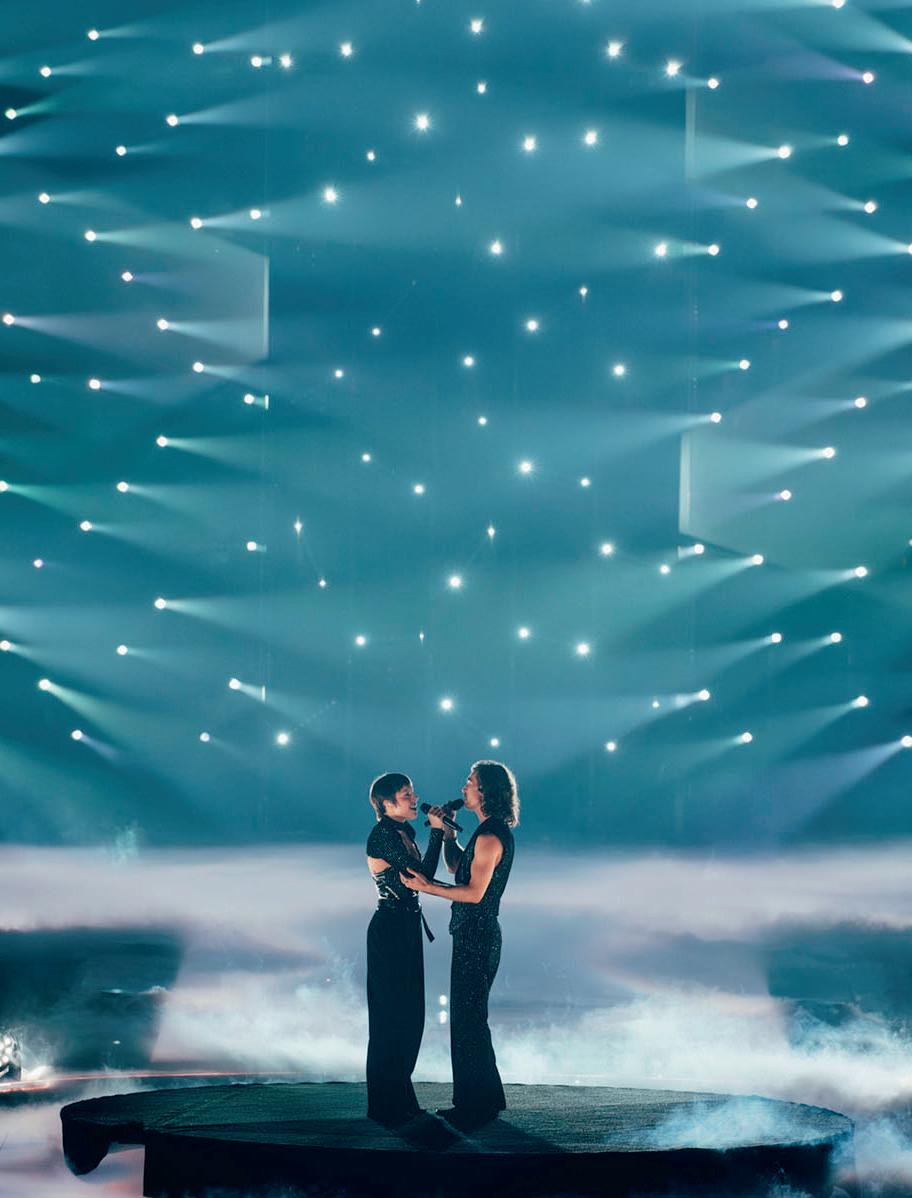
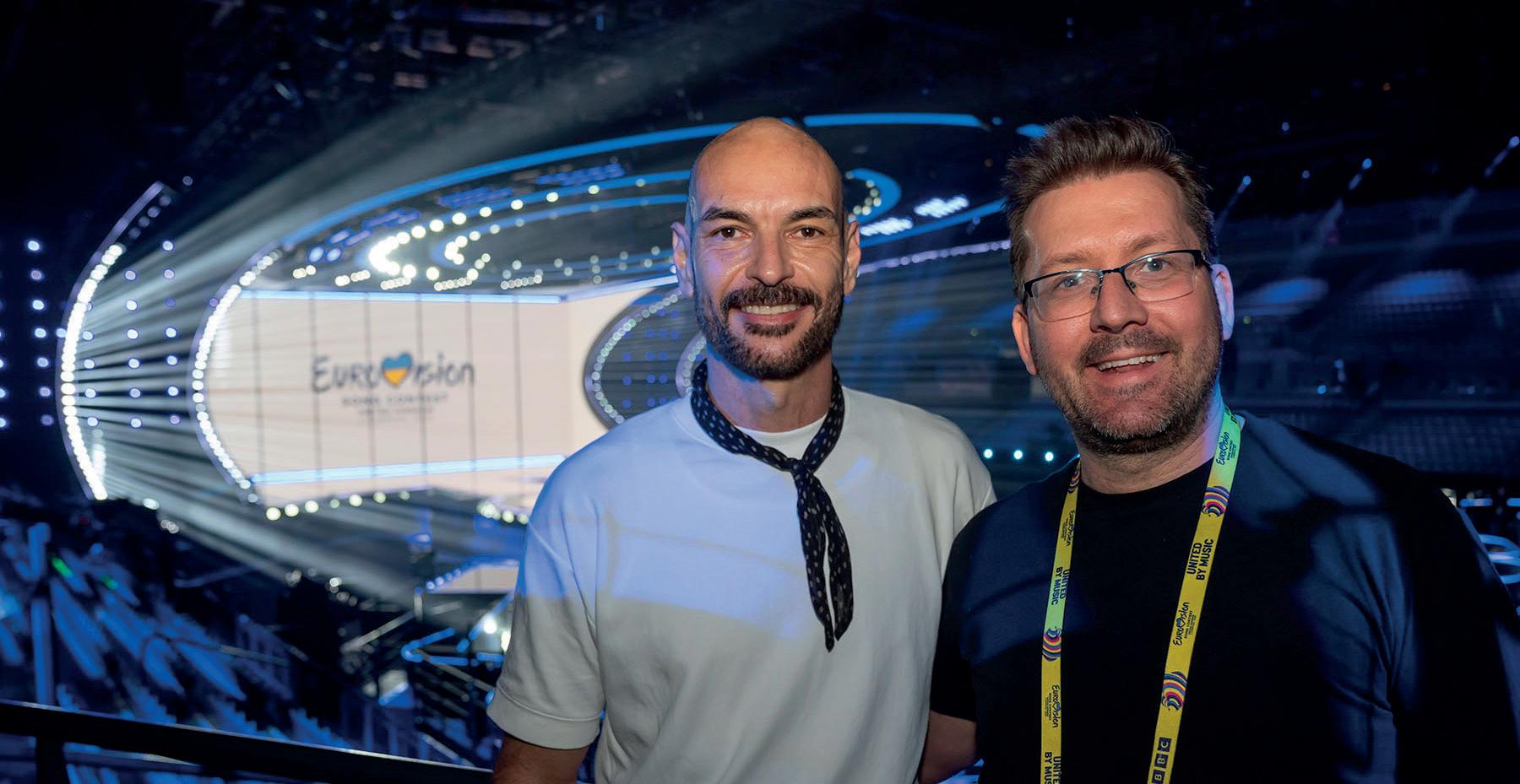
Just by incorporating people and bringing them in, we’re saying it’s not just all lighting UK lighting crew,’ Tim added.
THIRTY-SEVEN LIGHTING ENVIRONMENTS
The design used some 2,500 luminaires plus two kilometres of LED tape. In all, approximately 17,500 individual light sources were used, when counting the individual pixel cells of the various fixtures, all supplied by Neg Earth Lights.
A total of 37 unique immersive lighting environments were created to showcase each delegation’s songs, with lighting needing to be changed between acts in a matter of seconds. Each performance also had to be animated, fluid and energised, with Tim and the team curating lighting and video interactively and simultaneously.
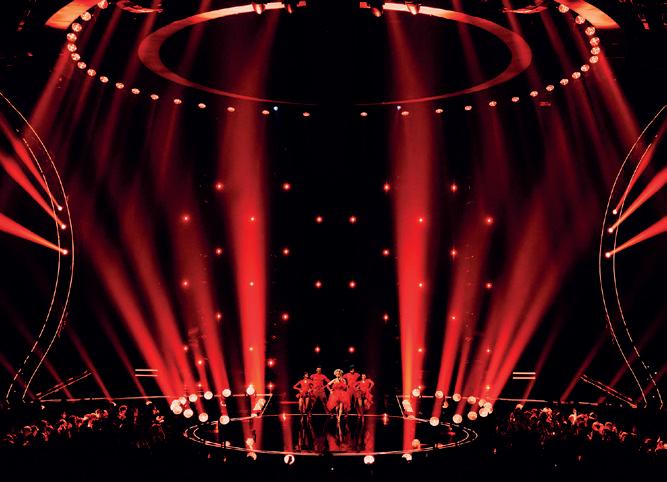
This meant that around 79,000 individual lighting cues had to be programmed into the consoles over the course of the two live broadcast shows on 9 and 11 May and then leading up to the final show on 13 May.

More than 600 moving lights from Robe were also used for the event, including the company’s 15-way RoboSpot remote-follow system, plus its ‘LED Beam150’, ‘FORTE’, ‘PAINTE’, ‘Spiider’ and TetraX brands, among others.
Julio explained how combining the identities of both Ukraine and the UK was at the forefront of his set concept.
‘Ukraine and the UK both have such rich cultural histories, so we really looked at how to embody the traditional side such as manmade crafts and embroidery of Ukraine, but also the rich dynamic musical history of Liverpool,’ he said.
‘We spent a lot of time looking at how we could translate that to a visual form, how that translated into a set design that we could cater for,’ he added.
www.theilp.org.uk JULY/ AUGUST 2023 LIGHTING JOURNAL 55
Julio Himede (left) and Tim Routledge on the Eurovision set
AS GOOD AS OLD
For too long, lighting has been obsessed with promoting and selling new product and has shown little interest in repurposing fittings or caring what happens to them. That has to change; lighting now has no choice but to wean itself off ‘new’ as the default solution
 By John McRae
By John McRae
It is now common knowledge that the built environment is responsible for a staggering 40% of annual global CO2 emissions [1]
Within this figure, building operations account for 27% of total emissions, while building and infrastructure materials and construction (known as embodied carbon) account for an additional 13%.
Construction is a significant contributor to carbon emissions and waste. For too long, we have prioritised the concept of ‘newness’, leading to the frequent stripping out and replacement of buildings, regardless of cost or conscience. However, over the past five years, this mentality has started to shift.
By 2040, approximately two-thirds of the global building stock will be made up of existing buildings. Without widespread decarbonisation efforts across the globe, these buildings will continue to emit CO2 emissions, making it impossible to achieve the Paris Agreement’s target of limiting temperature increases to 1.5°C.
Achieving zero emissions from the existing building stock will require leveraging building intervention points to accelerate the rate of energy upgrades. This includes increasing energy efficiency, eliminating
JULY/ AUGUST 2023 LIGHTING JOURNAL 56
on-site fossil fuels, and procuring 100% renewable energy.
CRUCIAL ROLE OF EMBODIED CARBON
As we look ahead to the construction projects set to take place in the next two decades, it becomes clear that embodied carbon will play a crucial role in achieving zero emissions by 2040. While operational carbon emissions can be reduced over time, embodied carbon emissions are locked in as soon as a building is constructed. To reach our emissions goals, we must take action to reduce embodied carbon now.
There are three principles that will be integral to achieving zero embodied emissions: reuse, reduce, and sequester.
This includes renovating existing buildings, using recycled materials, and designing for deconstruction, as well as selecting lowto zero-carbon materials and designing carbon sequestering sites.
Just three materials – concrete, steel, and aluminium – are responsible for 23% of total global emissions (most of this used in the built environment). There is an incredible opportunity for embodied carbon reduction in these high-impact materials through policy, design, material selection, and specification.
According to the World Bank, more than 100 billion tonnes of raw materials are extracted annually and roughly 90 billion tonnes of materials are discarded as waste [2]. As a result, product designers are arguing that adjustments to the linear model of ‘take-make-use-waste’ need to be radical, with manufacturing methods rethought from the outset.

When you consider material shortages, extended lead-in times and inflationary costs, is it any wonder that we are starting to see construction elements such as steel, glass, internal partitioning, raised floors and ceiling tiles being disassembled and repurposed either within the same building or held in a database to be used by others on their development?
A great example of this is the Fabrix ‘Roots in the Sky’ project, where steel from 2 Broadgate in London has been carefully removed, refinished, and will be assembled as part of the project thus capturing the embodied carbon that already exists. So why not the lighting industry?
For too long, the lighting industry has been obsessed with promoting and selling product and has shown little interest in repurposing its fittings or caring what happens to them. It has in the past offered to relamp or replace fluorescents lamps with LED versions, but often swapping existing fittings with new.
With the continued shortage of materials because of global disruption, inflation and
prolonged lead-in times, now is as good as any to take control of using what we have. I would like to see the industry acknowledge the value in what already exists, take responsibility for what it has created and repurpose it for future use.
It is important to understand why such waste exists and, I would argue, there are two main scenarios in the London office market. First, where new or nearly new fittings are installed as part of a ‘Cat A’ (or basic finishing) open-plan fitout and then replaced by the occupier because they don’t like them. Then, second, where there is a major lease event at year five, 10 or 15 years and the fittings are often replaced as they are nearing the end of their life cycle.
RETHINKING ‘CAT A’ FIT-OUTS
Why do we deliver to Cat A in the first instance? The fundamental reason it is undertaken is to secure leasing of the office space to occupiers via agents and/or developers.
It is very difficult for lay occupiers to understand a space and its qualities when a building is only delivered to a shell and core.
Whilst techniques such as computer-generated image, virtual reality and augmented reality are used, visiting the space will be required.
Arguments are made for fitting out one floor and not the entire building but this is only part of the challenge because changes are often made once an occupier has
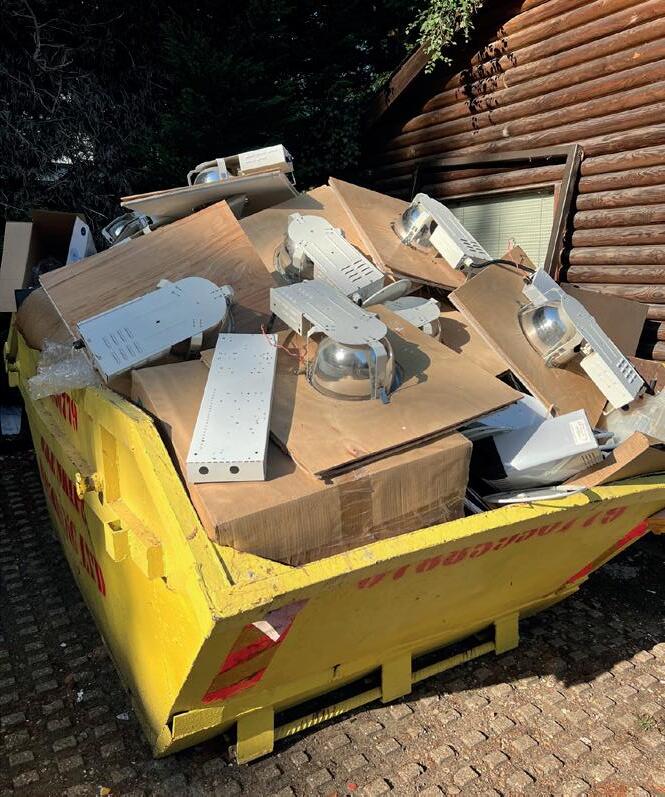
Embodied Carbon Building Fabric Measure Measure Review Reduce Review Propose Propose Action Action NE T ZERO Operational Carbon Building In Use
www.theilp.org.uk JULY/ AUGUST 2023 LIGHTING JOURNAL 57
Lighting and sustainability
Lighting and sustainability
completed the lease. Why is this? Cat A is often designed as open-plan, with little acknowledgment of the target occupier and little flexibility to adapt to a fitout.

The occupier may not like the aesthetic of the ceilings/fittings but often it is the lack of flexibility and adaptability that means most of it ends up in a skip. What can we do about this?
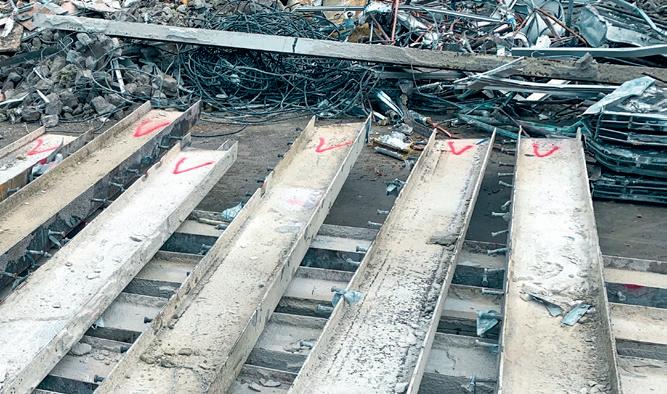
Firstly, we need to see a greater engagement between designers and the lighting industry to ensure adaptability and disassembly are integrated from the outset.
Understanding and planning out scenarios around different occupiers can ensure a high degree of future adaptability is designed in, which makes it easier for the occupier once they are on board. Better still, can the lighting manufacturers be an integral part of this process by providing a fully circular service for the entire life of a fitting?
Being more closely aligned with building owners, the manufacturers can be part of the design, supply and installation of the new fittings but also the ongoing upgrading, maintenance and adaptation to suit the different occupiers.
Then, at a major lease event, take them back, remanufacture and warrant them for return to the same project or provide for another. This circular approach retains value in the fitting and provides ongoing income for the original manufacturer and reduces waste significantly.
Alongside this, another opportunity is leasing the light fittings for the Cat A to help marketing in the knowledge that they will be returned when an occupier takes a lease, unless they want to retain them. This would mean fittings are used for an element of time for a purpose, then returned to the manufacturer for onward use.
LIGHTING AS A SERVICE
The most valuable light fitting is the one that already exists. It is estimated that 100,000 light fittings per week (circa five million per year) are removed from sites across the UK, of which only 7% are recycled and just under 1% are repurposed. Therefore, immediate action is required.
There are three questions that I would challenge clients, designers and the lighting industry to especially consider when undertaking their next project that puts circularity at the forefront:
1. Can the light fitting be retained on site and be upgraded in situ?
2. If not, then can the light fitting be carefully removed from site either to be moved on, by the likes of Recolight
free of charge, or to a manufacturer to be repurposed? There are a few companies emerging that will take them, repurpose and re-warranty as new.
3. If it is deemed that new fittings are required, can they be sourced from Circular Place (https://circularplace.fr/en/) , a recently launched French platform that takes unwanted new stock from lighting manufacturers and passes them on?

Whilst these are plausible options that can be implemented now, I would like to see a more fundamental shift that considers lighting as a service.
The concept is based upon the premise that the relationship between landlord/ developer and lighting manufacturer is direct and not via contractors and sub-contractors. Its vision is to create a service contract where supply, maintenance, adaption – and repurposing of the fitting – lies with the originator of the fitting through a 10-15 period.
The lighting manufacturer would be responsible for everything to do with the fitting and for its circularity should it be removed from its original building.
The income would not solely be from the capital sale of the fitting but the ongoing upkeep via a paid service agreement. This provides an alternate business model that could smooth the peaks and troughs of demand and recessions.
The benefits do not stop at the landlord and lighting manufacturer but include the occupier of the space.
They would be able to tailor their space, have the lamps and fitting upgraded through the lease of the space and therefore benefit
from the reduced energy and costs through the entirety of the lease. At the end of the lease the landlord/developer will have a ready-to-lease space which potentially reduces rental void and time taken to refresh the space.
SUMMARY
The business guru and author Oren Harari is famous for saying: ‘The electric light did not come from the continuous evolution of the candle.’
We have seen household names within the construction industry create new businesses around the circularity of steel, glass partitioning, raised floors and partitioning.
If the lighting industry is serious about tackling the climate emergency, then you have to work more cleverly with what you have and wean yourselves off ‘new’ as the default solution.
This is an opportunity for the lighting industry to reinvent itself, to align directly with landlords, developers and occupiers and to be trailblazers in how circularity can be applied and celebrated.
Imagine if in five years there are only 50,000 light fittings removed form UK sites – but 50% were repurposed and 50% recycled?
This would go a long way to reducing waste, embodied carbon and improving operational carbon. It would be a win for all parties but most of all of course the planet.
[1]
‘The Built Environment’, Architecture 2030, https://architecture2030.org/why-the-building-sector/ [2] ‘World Bank Releases Its First Report on the Circular Economy in the EU, Says Decoupling Growth From Resource Use in Europe Achievable Within Decade’, World Bank, December 2022, https://www.worldbank.org/en/news/press-release/2022/12/06/world-bank-releases-its-first-report-on-the-circular-economy-says-decoupling-growth-from-resource-use-in-europe-achievab
JULY/ AUGUST 2023 LIGHTING JOURNAL www.theilp.org.uk 58
John McRae is director of designer and architect Orms

EMERGENCY PLANNING
The phasing out of fluorescent lamps during this year is likely to put a renewed impetus into LED retrofit projects. As one manufacturer argues, while clients are thinking about upgrades and perhaps have labour on site, it makes sense also to be talking to them about the importance of revisiting their emergency lighting
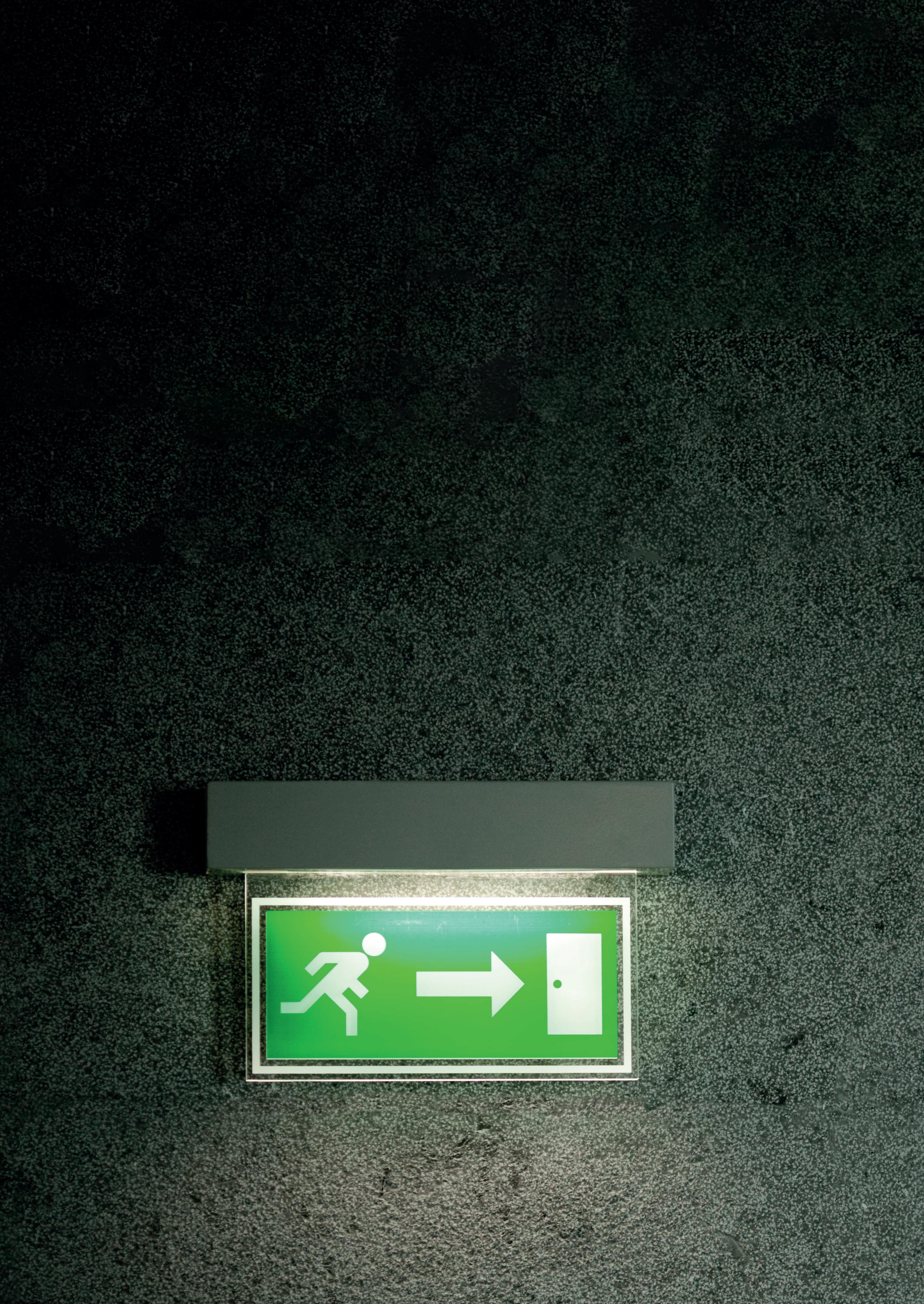 By Andy Davies
By Andy Davies
JULY/ AUGUST 2023 LIGHTING JOURNAL 60
Emergency lighting
Back at the start of the year, the ILP’s Technical Manager Guy Harding outlined in these pages how the European Union’s Restriction of Hazardous Substances Directive will mean the majority of fluorescent lamps are due to be phased out during this year (‘Farewellfluorescents’, vol 88 no 1).
His was an important message for the profession to hear and, hopefully, take on board and respond to. In this article, I’m going to make the case that there is an important emergency lighting argument that can sit alongside this.
To be clear, my point, first, is not about fluorescent emergency lighting. The vast majority of emergency lighting will –should – have already been switched over to LED by now. Yes, we at Mackwell do occasionally still see fluorescent emergency lighting in situ, but it is quite rare.
If, as an ILP member, you do happen to working with a client who is still using fluorescent emergency lighting then, clearly, there’s a very simple message here: get on with persuading them to transition out to LED – and quickly.
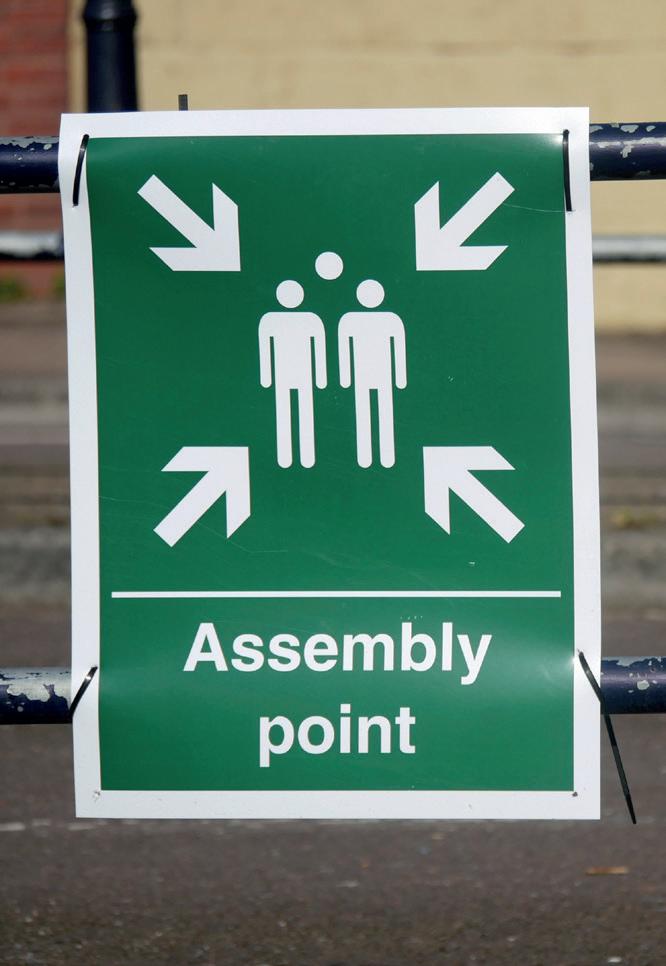
SECONDARY FLUORESCENT OPPORTUNITY
No, my wider point is there is potentially an important secondary opportunity in the context of emergency lighting as we move through this transitionary phase and fluorescent becomes a memory.
To my mind, the phasing out of fluorescent means there is going to be, generally, a renewed focus on and impetus to LED retrofit projects. Of course, retrofitting traditional light sources such as fluorescent to LED is not new.
The past few years have seen a rapid
switch away from old lighting technologies across the board, whether fluorescent or other, to LED – what I tend to call the ‘low hanging fruit’ of LED retrofit.
What with the pandemic, Brexit and simply the fact a lot of this work has now been completed, this phase has, I feel, slowed a bit in recent times.
What we have instead now is rising energy prices focusing the minds of potential clients to revisit what they’re doing in terms of lighting, and, on top of that this year, the realisation that, if they still have some legacy fluorescent lighting, that needs to be dealt with.
As building owners and facilities managers move to upgrade their lighting to reduce their dependence on fluorescent lighting, it is therefore the ideal time also to upgrade their emergency lighting.
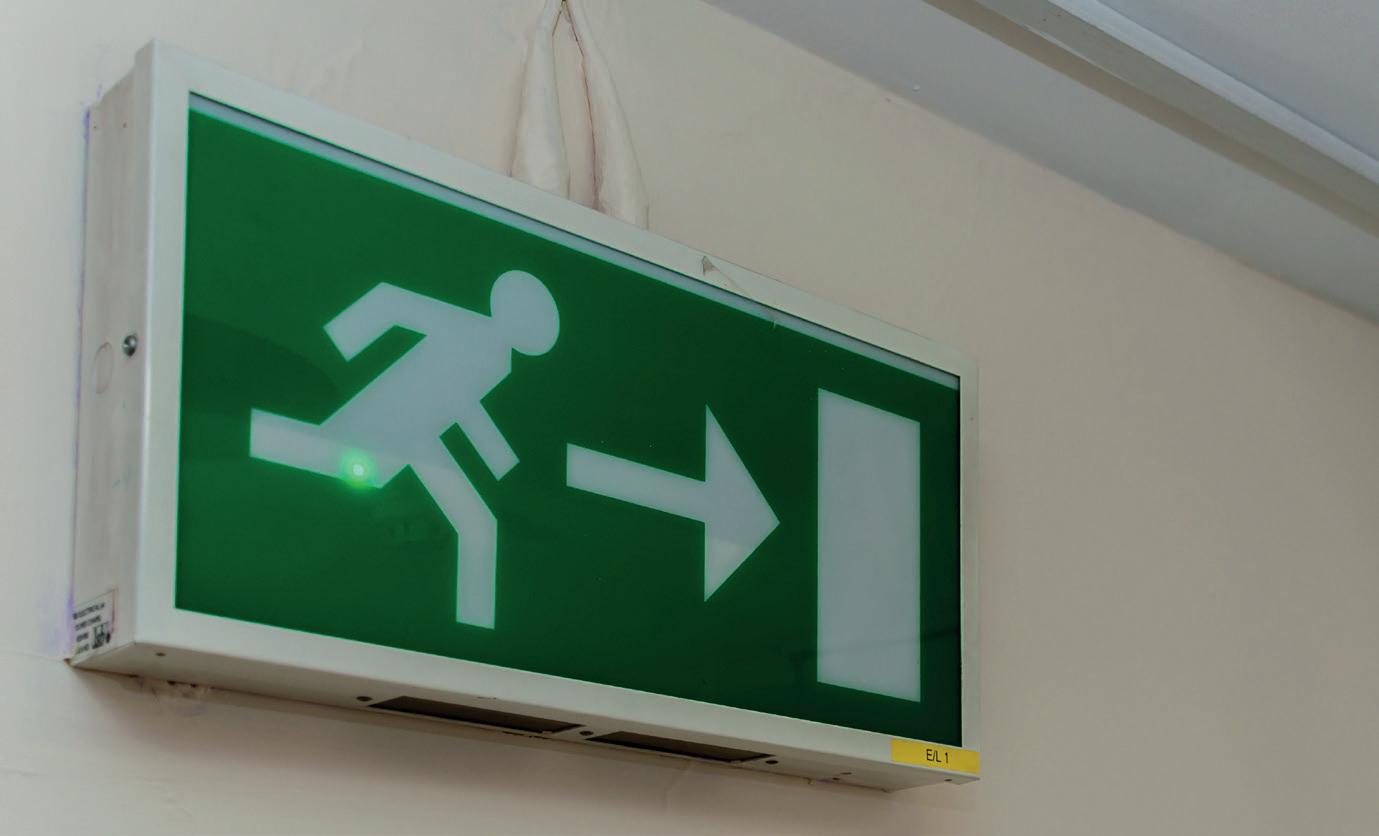
A third factor to consider within this is labour (itself of course an increasing cost). If an organisation is going to have teams on site to do LED retrofit work, there is a golden opportunity to be encouraging clients also to be considering whether it makes sense to revisit their emergency lighting.
This not only reduces the amount of disruption when works are going on, it offers economies of scale as contractors will be on site anyway.
MAXIMISING NEW TECHNOLOGIES
A further important point is that LED retrofits these days are undoubtedly going to be about a whole lot more than just LED. Clients will be introducing all sorts of smart systems, wireless controls, Internet of Things, sensor networks and more. So, you can revisit the emergency lighting alongside that context as well.
While reviewing, evaluating and upgrading emergency lighting is, yes, first and foremost about ensuring compliance,
that nowadays is not the whole story. It also needs to be about maximising the advances we have seen in emergency lighting technology in recent years.
There is an opportunity, for example, to put in products that have the latest battery and battery management technologies, which allow you to get longer life and better reliability. Or you can look at the viability of upgrading to automated test systems, wired or wireless, depending on what else you have in that building. Or how about Cloud-based remote monitoring?
My point here is very simple: if you have clients who are now thinking (perhaps on your prompt) about their fluorescent lighting, why not also get them thinking about their emergency lighting?
If a client is having to do LED retrofit work anyway, there is a massive advantage and potential cost saving in also reviewing and updating their emergency lighting to ensure it is delivering the correct lux levels and correct uniformity; that is being managed correctly; and that it has the correct discipline in place for regular testing and monitoring and logging of test data.
Ultimately, if a client has gone to the trouble, labour and expense to carry out a retrofit project to ensure their general lighting is now compliant, but they haven’t also revisited the compliance and functionality of their emergency lighting system, that is very much a missed opportunity, at least to my mind.
This is a conversation that, as a responsible lighting professional, I’d argue you need to be having with your valued clients. Good luck!
www.theilp.org.uk JULY/ AUGUST 2023 LIGHTING JOURNAL 61
Andy Davies is commercial director at Mackwell
BEING ABLE TO MAKE A DIFFERENCE TO PEOPLE AND PLACES THROUGH LIGHTING’
It is the turn of the YLP’s new chair Ryan Carroll to put himself in the Lighting Journal spotlight, discussing his route into the industry and how others can be encouraged to follow suit
By Ryan Carroll
TELL US ABOUT YOURSELF
I’m Ryan Carroll and I have been working in the lighting industry with DFL for coming up to eight years. I have the privilege of leading DFL’s Lighting Impact and Planning team, working with a fantastic group of likeminded people who are all passionate about lighting.
More recently, this summer I have taken on the role of YLP chair from Toby Penter and so I am looking forward to supporting the YLP committee, along with the wider membership over the coming year.
HOW DID YOU GET INTO LIGHTING?
From a young age (secondary school age) I enjoyed the lighting of theatre shows and live events.
When the time came to decide whether or not I wanted to progress into further education, the decision was made easier because there were few companies in the south west specialising in entertainment lighting.
This encouraged me to go to university to study lighting design, as I was certain this approach would lead me into my post-
graduate journey in starting my career.
I therefore chose to study lighting design and technology at the University of South Wales because the degree was science-based. I am generally more technically able than I am artistically, so this suited me well.
I was also keen to ensure that the course content was adept enough to give me a sound technical and scientific understanding of lighting, as well as how to effectively design lighting in practice.
It was during my degree that I had the opportunity to explore environmental lighting design, which I loved, and have not looked back since deciding that was the avenue for me back in the second year of my degree.
WHY LIGHTING?
I appreciate art and have always wanted to be able to pick up a paint brush and create a masterpiece. However, what ends up on the paper is something that even my five-yearold daughter would laugh at.
So, for me, I chose lighting because I see it as my ‘paint’, with the project/
JULY/ AUGUST 2023 LIGHTING JOURNAL 62
‘I ENJOY
environment the canvas on to which ‘the masterpiece’ will be created.
I enjoy being able to make a difference to people and places through lighting, as well as having the ability to ensure that lighting does not detrimentally affect people and places too. For me, this is of crucial importance.
HAVE YOU BEEN INVOLVED IN ANY PROJECTS YOU ARE PARTICULARLY PROUD OF, AND WHY?
Since starting with DFL in 2015, I have been fortunate enough to be involved in and lead a large number of projects. Whilst they are all special in their own right, there are a few projects that stand out for me.
One project would be the lighting of a new car park for an end-of-life hospice in Bath (Dorothy House Hospice).

This was a complex project because of the ecological sensitivities and the proximity of residential receptors from the site boundaries. The project was met with significant objection, from planning officers and residents near the site.
Working with the client team, consultant team, residents and local planning authority, I managed to persuade those who were most sceptical of the proposals that the scheme would in fact be environmentally sensitive.
Following commissioning of the scheme, the lighting installation was commended by the Commission for Dark Skies – and local objectors who had originally been opposed to the scheme actually commented on how subtle the installation was.
For me, this was a huge achievement because the outcome was as intended from the start of the project.
WHAT BARRIERS ARE THERE FOR YOUNG PEOPLE TO ENTER THE INDUSTRY?
Education is the key challenge or barrier for young people entering the industry in my opinion.
I say this because there does not seem to be a wide pool of courses available at A Level or college that would help a young person to embark on a career in the lighting industry.
The closest courses tend to be electrically focused, with a small lighting element within them, rather than a syllabus that is focused on the scientific and technical fundamentals of light.

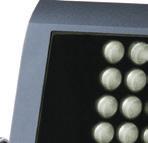


With this in mind, the lack of education in this area is also damaging to the industry itself, as there are fewer young or new individuals entering the industry with a sound basic understanding of light and lighting.
This therefore puts the industry under pressure to ensure that suitable levels of lighting competency are being maintained or instilled.
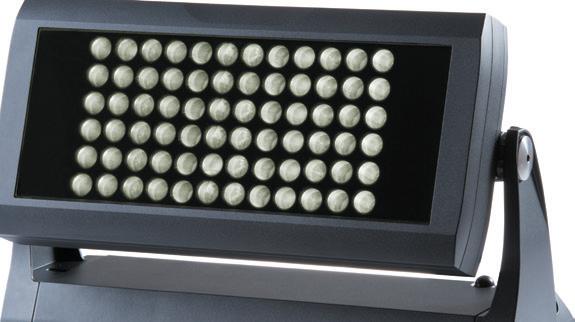
Thankfully, there are the courses that the ILP and fellow industry organisations run to ensure education is coming from within the industry. However, my concern is this is not enough to sustain the industry because this alone will not generate interest in the industry and the profession amongst potential future industry professionals.
HOW HAS THE ILP HELPED YOU ON YOUR

LIGHTING ‘JOURNEY’?
The ILP has helped me by inviting me to volunteer at events, present technical papers and be involved in committees such as the Technical Committee, where I have been
Young and new lighters
able to meet with a group of hugely knowledgeable and highly respected members of the industry.

In particular, the YLP has been a vital stepping stone and support network of people who are of a similar age and at a similar point in their career as me. I daresay the friendships forged through my involvement in the YLP will carry on such as we’ll all be sat at retirement parties in 30+ years’ time!
The ILP’s support over the years has really boosted my confidence and made me feel like a valued member of the Institution.
WHAT WOULD BE YOUR MESSAGE TO OTHER PEOPLE THINKING ABOUT A CAREER IN LIGHTING?
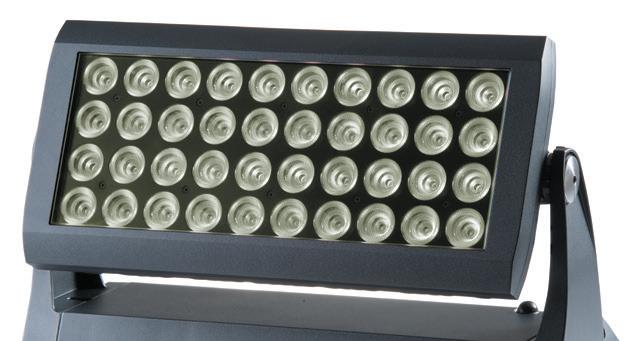
Go for it! If you are looking for an industry that is different, fun, opens opportunities to multiple niches within it then you are certainly looking at the right industry to join. I would say don’t worry about what you don’t know.
Talk to people as much as you can and do not hesitate to get involved in industry events as these will help you to understand the direction you would like to take within the industry.
Don’t be afraid to ask questions if you don’t know and don’t be afraid to share the knowledge you do have with others, as this typically leads to wider conversations and helps to fill in knowledge gaps between peers.
Finally, go to YLP events and get involved in the YLP committee. There is a big network of friendly, like-minded people ready and waiting to catch up with you at a technical event or raise a glass with you at an industry social or networking session!
GET IN TOUCH
Don’t forget, if you’re under 35 or new to the industry and would like to tell your story during 2023, simple email LightingJournaleditor Nic Paton on nic.cormorantmedia@outlook.com

We’ll then send you a questionnaire to fill in and return with a photograph. Simple!
 Ryan Carroll is department lead, Lighting Impact and Planning, at DFL and the current chair of YLP (Young Lighting Professionals)
Ryan Carroll is department lead, Lighting Impact and Planning, at DFL and the current chair of YLP (Young Lighting Professionals)
www.theilp.org.uk JULY/ AUGUST 2023 LIGHTING JOURNAL 63
The Dorothy House Hospice car park, a complex and sensitive DFL project of which Ryan {inset) is particularly proud
anolislighting.com UP CLOSE... FAR AWAY DIVINE™
CLIVE LANE 1943-2023
Former Institution President Clive Lane sadly passed away in May. Here, his widow Sheila reflects on his life and significant contribution to lighting over many years
By Sheila Lane
My husband Clive Lane was born in London on 26 April 1943, but soon moved to Leigh-on-Sea in Essex, where he grew up, and where we met when he was 17.
Clive qualified as a civil engineer at King’s College London in 1965, inspired by his hero, Isambard Kingdom Brunel.
We married in 1965, and Clive started his career at G Maunsell & Partners, London, where he was involved in the design of motorway bridges, notably Westway in
London, and checking the design of the Yarra Bridge in Melbourne, Australia, among other things.
In 1971, Clive joined the Civil Service Road Construction Unit in Aylesbury, continuing with the design of road and motorway bridges and site supervision.
In 1973, just as he was tiring of civil service life, Clive was approached by Concrete Utilities Ltd of Ware, Hertfordshire (now CU Phosco) to start their concrete footbridges division.
This led to him working on concrete pontoons and lighting columns, and later aluminium and steel lighting columns were added.
This, in turn, led to us, with our young children Nicola and Tony, moving to live in the tiny village of Berden in north-west Essex, where we became involved in the lively village community for the next 43 years.
At this time, Clive also joined the Ware Round Table, and was involved in various charity and social events. Subsequently, as technical director, he travelled abroad to lecture and visit customers in India, Malaysia, Taiwan, China, Hong Kong, Japan, Canada and the US, as well as in the UK.
TWO-TIME ILE PRESIDENT

A member of the Institution of Lighting Engineers, as the ILP then was, from approximately 1986-2000, Clive lectured on the design of lighting columns at courses and conferences in UK and Ireland. He was twice President of the ILE, in 1997-98 and in 1999-2000.
Clive was on the BSI and European Standards Committees for lighting columns, with meetings involving travel to many European cities from approximately 1978-1997. He chaired the European Committee for nine years, honing his diplomatic skills to keep the meetings of numerous nationalities in order!
He was a Liveryman of the Worshipful Company of Lightmongers from 1997, until ill health forced him to retire, and a Freeman of the City of London.
During this time, he was still involved in Berden life, including chairing the village hall committee and helping to run the popular tombola stall at the fete.
Our family during this time grew to include son-in-law Paul and daughter-inlaw Kate, and grandchildren Thomas, Emilia and Olivia.
Following our Golden Wedding in 2015, we moved to Halstead on the Essex/Suffolk border, until moving very recently to live with Nicola, Paul and Tom. He will be deeply missed by the whole family.
Clive Lane BSc AKC CEng EurIng FICE FIHT Hon FILE, 1943-2023
• A celebration of Clive’s life was held on 7 July at Cam Valley Crematorium in Greater Chesterford. Donations in his memory can be made to Royal Papworth Hospital Charitable Trust, HASAG Asbestos Support Group, and Mesothelioma UK via ‘Clive’s Memory Page’ at www.peasgoodandskeates.co.uk/ donate-in-memory/
JULY/ AUGUST 2023 LIGHTING JOURNAL www.theilp.org.uk 64
Obituary
Kirium Pro S Scaled to fit your needs.
A more sustainable lighting solution designed to meet the needs of both people and the environment. Now available in a range of sizes to suit your project requirements.
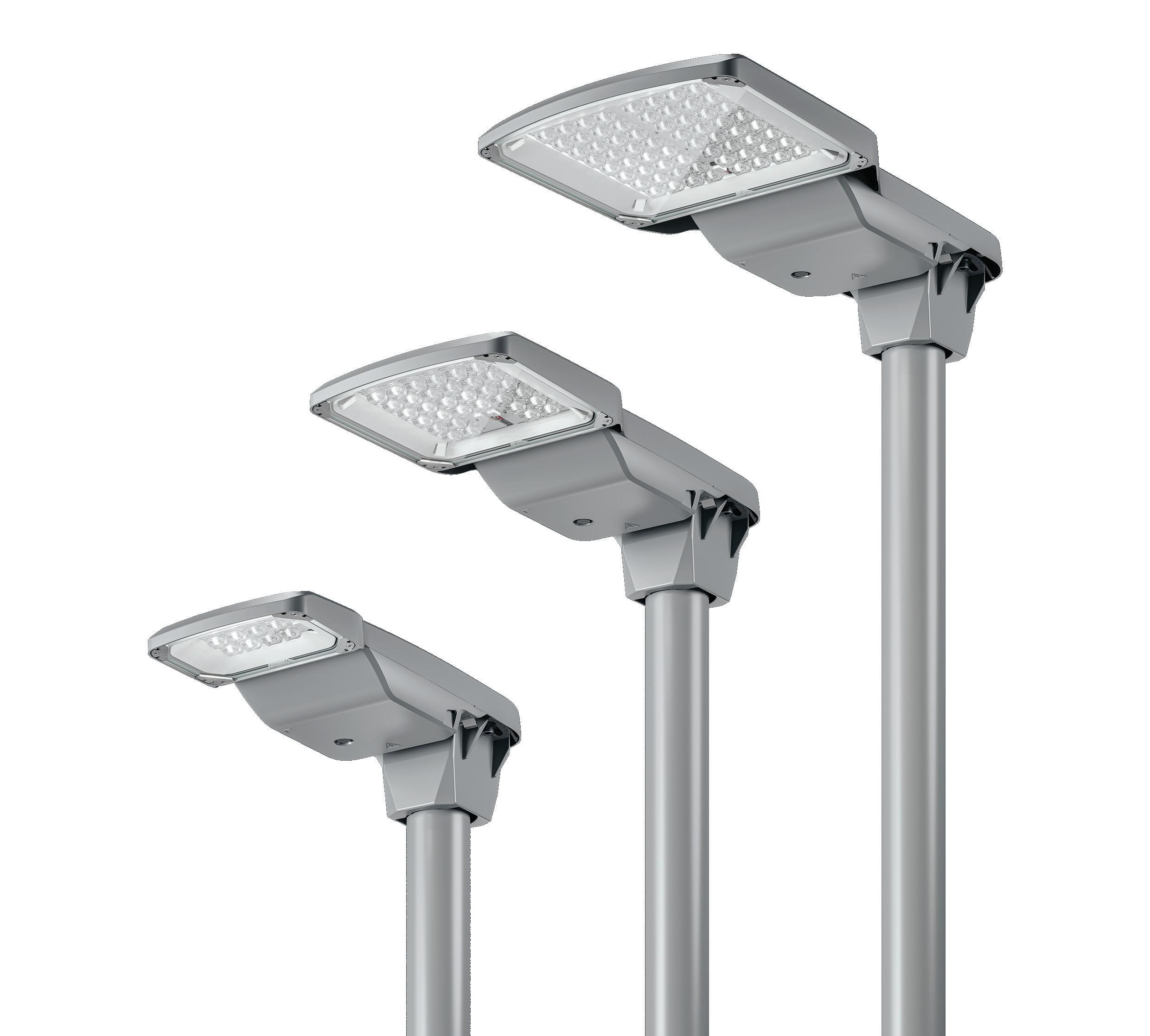
dwwindsor.com
LIGHTING CONSULTANTS
This directory gives details of suitably qualified, individual members of the Institution of Lighting Professionals (ILP) who offer consultancy services




HERBIE BARNIEH
BEng CEng MILP PROJECT CENTRE
1 AMERICA SQUARE, LONDON, EC3N 2LS
T: 0330 135 8950, 077954 75570
HERBIE.BARNIEH@PROJECTCENTRE.CO.UK
WWW.MARSTONHOLDINGS.CO.UK/PROJECTCENTRE
Efficient, innovative, and bespoke lighting design services from an award winning consultancy.
Experienced in delivering exterior lighting projects from feasibility studies to post construction services. Whether it’s highway, street, or public realm lighting, let us assist you to realise your project goals.
STEVEN BIGGS
IEng MILP
MILESTONE INFRASTRUCTURE
PETERBOROUGH PE1 5XG
T: 07834 506705
STEVEN.BIGGS@MILESTONEINFRA.CO.UK
MILESTONEINFRA.CO.UK

Award winning lighting design specialists, delivering innovative design, installation and maintenance solutions in highways, public realm, commercial and architectural environments.
Our HERS registered team provide design strategies, impact assessment, technical & certifier support.


BONNIE BROOKS
BA(Hons) BEng (Hons) MSc
CEng MSLL MCIBSE MILP
THE LIGHTING BEE LTD

EXETER EX4 1NF
T: 07840 054601, E: INFO@THELIGHTINGBEE.CO.UK
WWW.THELIGHTINGBEE.CO.UK
Professional independent lighting design consultancy providing designs for all exterior applications, including street lighting. Specialists in assisting at the planning application stage with designs, strategies, lighting impact assessments, and expert witness, with a focus on mitigating ecological and environmental impacts.
SIMON BUSHELL
MBA DMS IEng MILP ENERVEO
PORTSMOUTH PO6 1UJ
M: +44 (0)7584 313990 T: +44 (0)121 387 9892
E: SIMON.BUSHELL@ENERVEO.COM
WWW.ENERVEO.COM
Professional consultancy from the UK’s and Irelands largest external lighting contractor. From highways and tunnels, to architectural and public spaces our electrical and lighting designers also provide impact assessments, lighting and carbon reduction strategies along with whole installation packages.
LORRAINE CALCOTT
IEng FILP IALD MSLL ILA BSS IT DOES LIGHTING LTD
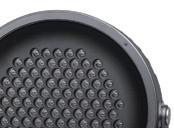


THE CUBE, 13 STONE HILL, TWO MILE ASH, MILTON KEYNES, BUCKINGHAMSHIRE, MK8 8DN
T: 01908 560110 E: INFORMATION@ITDOES.CO.UK
WWW.ITDOES.CO.UK
Award winning lighting design practice specialising in interior, exterior, flood and architectural lighting. Emphasis on section 278/38, public realm, ecology receptor mitigation and supporting Councils with planning approvals, CDM2015 and SBD accredited. Specialists in circadian spectrally specific lighting design.
MARK CHANDLER
EngTech AMILP
MMA LIGHTING
CONSULTANCY LTD
READING RG10 9QN

T: 0118 3215636
E: MARK@MMA-CONSULTANCY.CO.UK
WWW.MMA-CONSULTANCY.CO.UK

Exterior lighting consultant’s who specialise in all aspects of street lighting design, section 38’s, section 278’s, project management and maintenance assistance. We also undertake lighting appraisals and environmental lighting studies
KEVIN RAMSAY
IEng MILP MIET SWECO
SWECO, EDINBURGH EH3 9QG
T: 07467685753 E: KEVIN.RAMSAY@SWECO.CO.UK
WWW.SWECO.CO.UK

Lighting and electrical design consultancy providing private and public sector innovative professional services. Specialising in Section 38, Section 278, RCC, highways, architectural, public spaces, car park, lighting impact assessments, Internet of Things, interior and emergency lighting, EV design. From planning to post-construction we provide innovative and environmental balanced solutions.
REBECCA HATCH
IEng MILP
WSP
LONDON WC2A 1AF
T: 07385 461143
E: REBECCA.HATCH@WSP.COM
WWW.WSP.COM
National team of specialist lighting and energy professionals offering the latest thinking and best client service across all aspects of lighting and energy, both public and private sector. Architectural, Highways, Environmental, Local Government, Electrical and Technical Expertise
STEPHEN HIGHAM
IEng MILP
SHD LIGHTING CONSULTANCY LTD
BOLTON BL2 6SE
M: 07834 490 192
E: STEVE@SHDLIGHTING.CO.UK
WWW.SHDLIGHTING.CO.UK





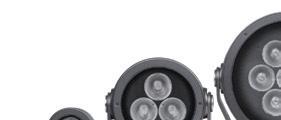

Outdoor lighting design consultancy specialising in street lighting and private lighting design services. We provide Section 38, Section 278, Car Park lighting designs, Commercial lighting and Environmental Impact Lighting Assessments and planning application consultancy advice throughout the UK.
ALLAN HOWARD
BEng(Hons) CEng FILP FSLL WSP
HERTFORD SG13 7NN
T: 07827 306483
E: ALLAN.HOWARD@WSP.COM
WWW.WSP.COM
Professional artificial and daylight lighting services covering design, technical support, contract and policy development including expert advice and analysis to develop and implement energy and carbon reduction strategies. Expert witness regarding obtrusive lighting, light nuisance and environmental impact investigations. registered personnel.
ALAN JAQUES
IEng FILP ATKINS
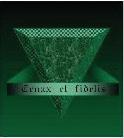
NOTTINGHAM, NG1 5FW
T: +44 (0)115 9574900 M: 07834 507070
E: ALAN.JAQUES@ATKINSGLOBAL.COM

WWW.ATKINSGLOBAL.COM
Professional consultancy providing technical advice, design and management services for exterior and interior applications including highway, architectural, area, tunnel and commercial lighting.
Advisors on energy saving strategies, asset management, visual impact assessments and planning.
PATRICK REDMOND
MILP MSLL IEng Tech IEI
REDMOND ANALYTICAL MANAGEMENT SERVICES LTD.

M: + 353 (0)86 2356356
E: PATRICK@REDMONDAMS.IE
WWW.REDMONDAMS.IE
Expert lighting and electrical infrastructure for all interior, exterior, and emergency lighting applications. On street EV charging infrastructure design. Authorising Officer and Live Working Manager for Local Authorities.
ANDREW LONGMAN
BEng (Hons) CEng MILP MIET
MHEA -Managing Director
DFL-UK

WINCHESTER SO23 7TA



T: +44 (0)1962 855080 M: +44 (0)7779 327413
E: ANDREW@DFL-UK.COM
WWW.DFL-UK.COM
Professional lighting design consultancy offering technical advice, design and management services for exterior/interior applications for highway, architectural, area, tunnel and commercial lighting. Advisors on lighting and energy saving strategies, asset management, visual impact assessments and planning.

ANTHONY SMITH
IEng FILP
STAINTON LIGHTING DESIGN SERVICES LTD
STOCKTON ON TEES TS23 1PX
T: 01642 565533, E: ENQUIRIES@STAINTONLDS.CO.UK
WWW.STAINTONLDS.CO.UK

Specialist in: motorway, highway schemes, illumination of buildings, major structures, public artworks, amenity area lighting, public spaces, car parks, sports lighting, asset management, reports, plans, assistance, maintenance management, electrical design, Lighting Impact Assessments and Dark Skies Compliant Lighting.
NICK
SMITH
IEng FILP MIES
NICK SMITH ASSOCIATES LIMITED
CHESTERFIELD, S40 3JR
T: 01246 229444
E: MAIL@NICKSMITHASSOCIATES.COM
WWW.NICKSMITHASSOCIATES.CO.UK
Specialist exterior lighting consultant.
Private and adopted lighting and electrical design for highways, car parks, area and sports lighting. Lighting Impact assessments, expert witness and CPD accredited Lighting design AutoCAD and Lighting Reality training courses.
ALAN TULLA
IEng FILP FSLL
ALAN TULLA LIGHTING
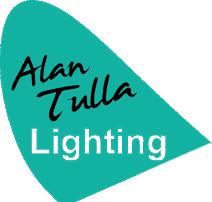
WINCHESTER, SO22 4DS
T: 01962 855720
M:0771 364 8786
E: ALAN@ALANTULLALIGHTING.COM
WWW.ALANTULLALIGHTING.COM
Visual Impact Assessments for planning applications. Expert in minimising environmental impact. 3D building modelling of light spill. Exterior and Interior architectural lighting design. Site surveys and lighting measurements. Specialises in problem solving and out-of-the-ordinary projects..

MICHAEL WALKER
IEng MILP CMS
MCCANN LTD
NOTTINGHAM NG9 6DQ
M: 07939 896887
E: M.WALKER@JMCCANN.CO.UK
WWW.MCCANN-LTD.CO.UK
Design for all types of exterior lighting including street lighting, car parks, floodlighting, decorative lighting, and private lighting. Independent advice regarding light trespass, carbon reduction and invest to save strategies. Asset management, data capture, inspection and testing services available.
PETER WILLIAMS
EngTech AMILP
WILLIAMS LIGHTING CONSULTANTS LTD.
OFFICE 6, STONEHOUSE BUSINESS CENTRE, 1A MIDDLE ROW, CHIPPING NORTON, OX7 5NH
T: 01608 642530 E: PETER.WILLIAMS@WLCLIGHTING.CO.UK

WWW.WLCLIGHTING.CO.UK
Specialists in the preparation of quality and effective street lighting design solutions for Section 38, Section 278 and other highway projects. We also prepare lighting designs for other exterior applications. Our focus is on delivering solutions that provide best value.

anolislighting.com CALUMMA™ OUR NEW FAMILY
Neither Lighting Journal nor the ILP is responsible for any services supplied or agreements entered into as a result of this listing
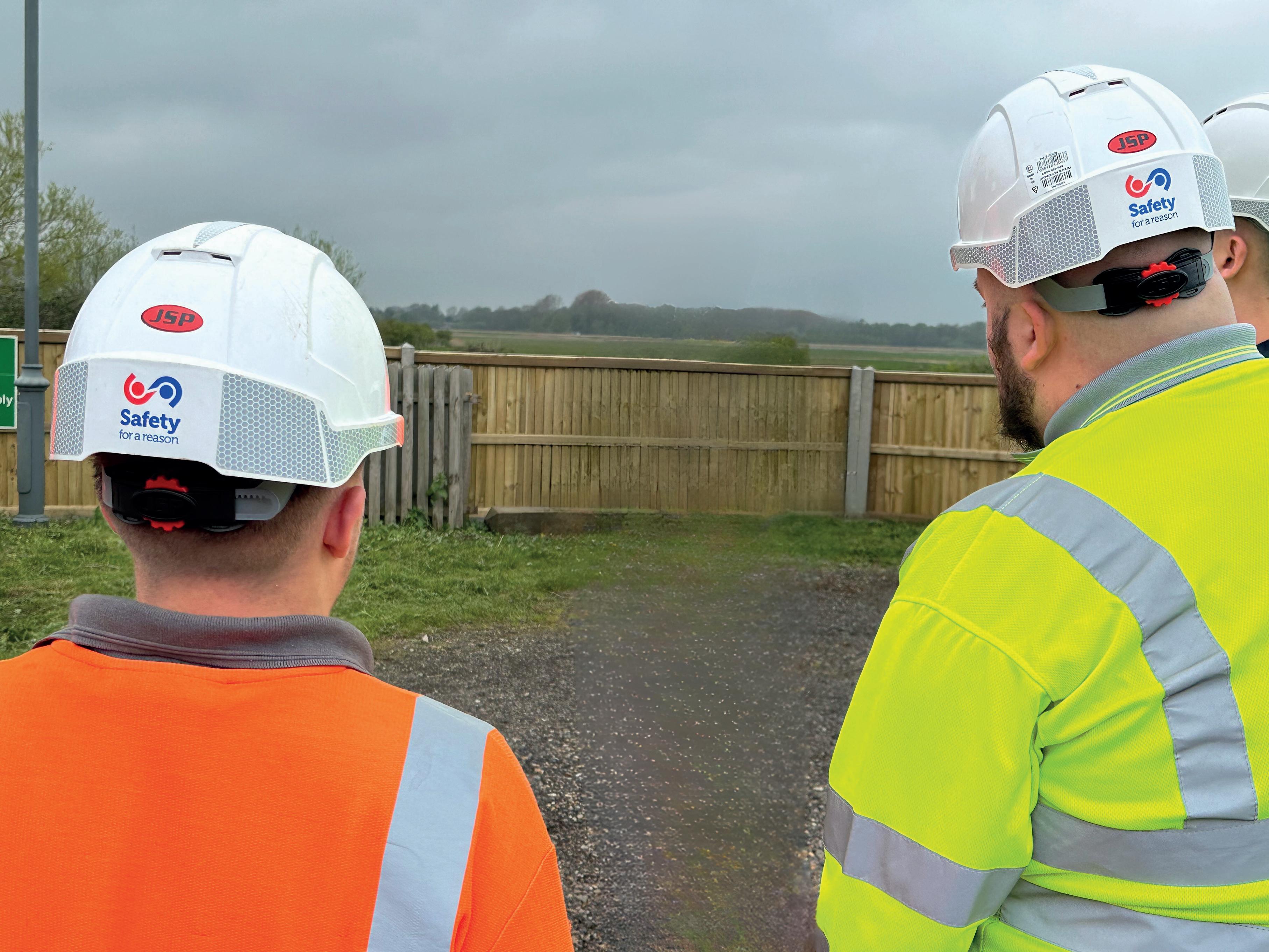
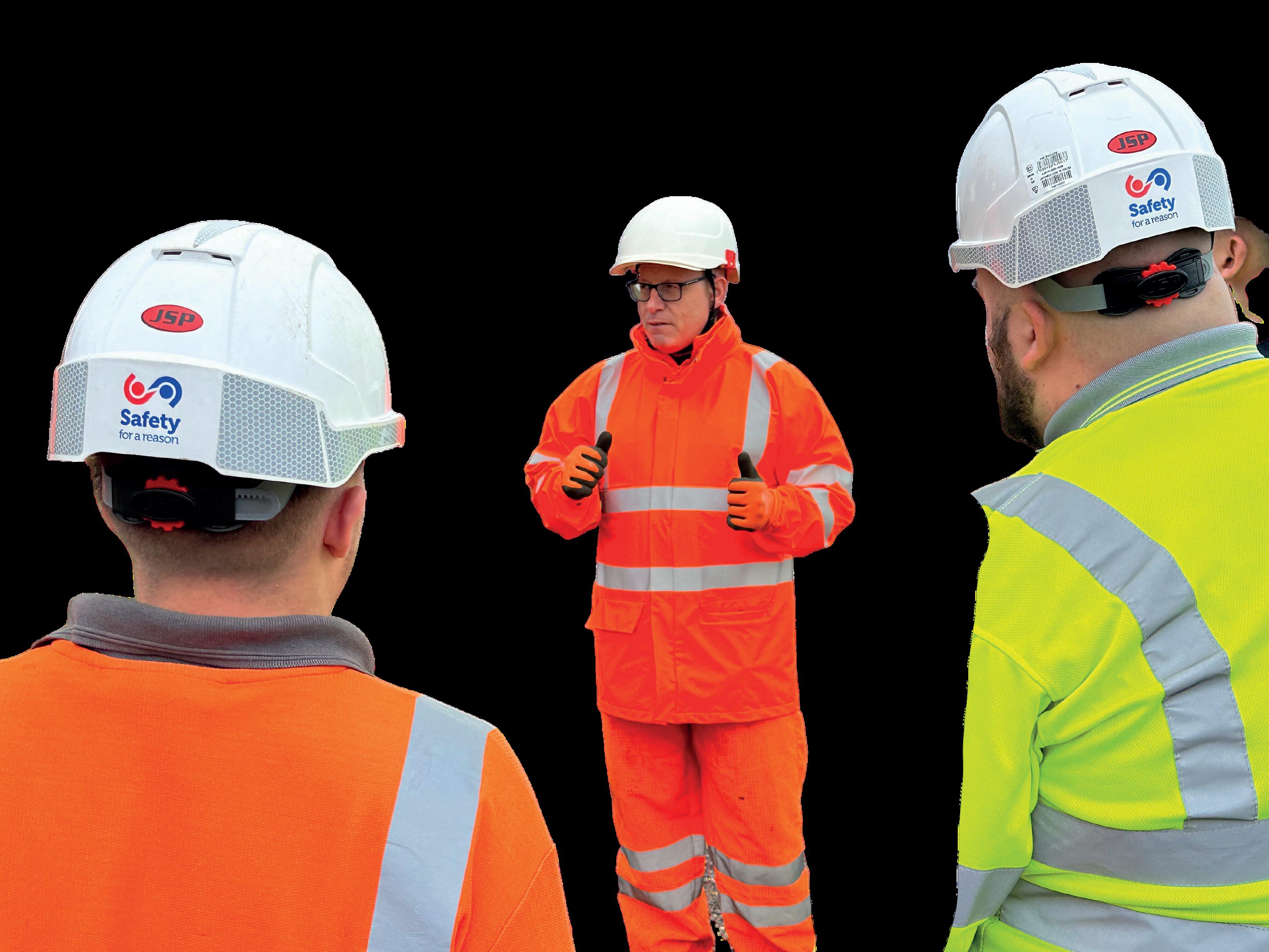


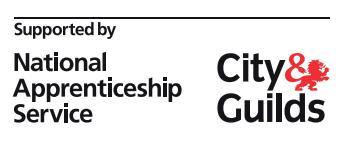





Celebrating a Century of British Manufacturing
Celebrating a Century of British Manufacturing


CU Phosco have had 100 award-winning years of illuminating roads, motorways, airports, ports, shopping centres, housing estates and sports stadiums - throughout the world.
A century ago, Charles Albert Marques M.B.E, founded Concrete Utilities.
As we celebrate the past and reflect on how far we’ve come, we’d like to take a moment to thank all of our wonderful customers, suppliers, partners and industry friends who have supported us over this incredible journey.
Here’s to the next 100!
+44 1920 860600 cuphosco.com enquiries@cuphosco.com




























 By Clare Thomas
By Clare Thomas









































































































































 By Nic Paton
By Nic Paton









 An interview with Matt Murray, Sales & Marketing Director of CU Phosco Lighting
An interview with Matt Murray, Sales & Marketing Director of CU Phosco Lighting









 [1] Hamoodh K. ‘Lighting for Pedestrians’
Figure 2. Test images show how the covers are applied to the face and hands. Image (a): face and hands are visible. Image (b): face and hands are not visible – face covered with a scarf, hat, and sunglasses; hands covered by placing them behind the back
Figure 3. Example of a test image observed by a participant while wearing eye-tracking glasses. The white dashed circle (here shown inside the bold red circle) shows a fixation point – or the point towards which they were looking. Here the participant was looking at the body of the person
[1] Hamoodh K. ‘Lighting for Pedestrians’
Figure 2. Test images show how the covers are applied to the face and hands. Image (a): face and hands are visible. Image (b): face and hands are not visible – face covered with a scarf, hat, and sunglasses; hands covered by placing them behind the back
Figure 3. Example of a test image observed by a participant while wearing eye-tracking glasses. The white dashed circle (here shown inside the bold red circle) shows a fixation point – or the point towards which they were looking. Here the participant was looking at the body of the person



 By Nic Paton
By Nic Paton




 A light meter showing the lux levels at Boxpark Wembley, as photographed by Lora Kaleva
A light meter showing the lux levels at Boxpark Wembley, as photographed by Lora Kaleva

















































 By Nic Paton
By Nic Paton





 By John McRae
By John McRae






 By Andy Davies
By Andy Davies












 Ryan Carroll is department lead, Lighting Impact and Planning, at DFL and the current chair of YLP (Young Lighting Professionals)
Ryan Carroll is department lead, Lighting Impact and Planning, at DFL and the current chair of YLP (Young Lighting Professionals)












































